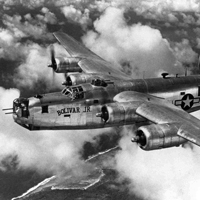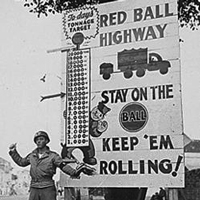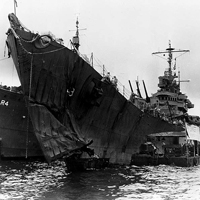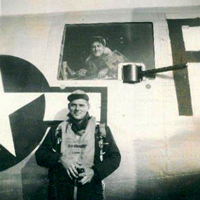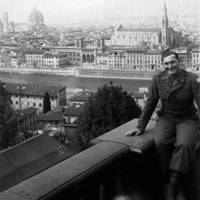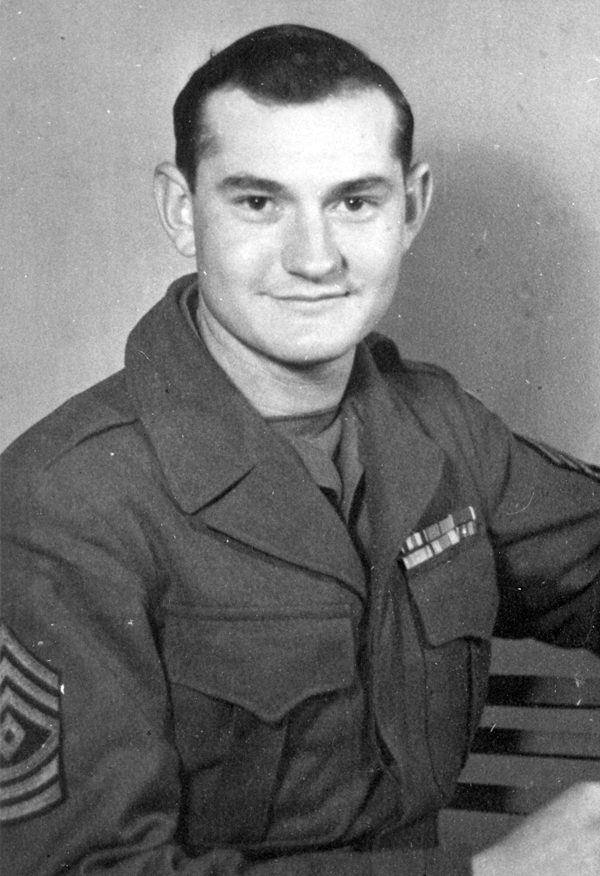
lyle pittenger
contents—click on a chapter
1—Early life and enlistment
My name is Everett, E-v-e-r-e-double t, Lyle Pittenger. Of course I’m a junior and I was a junior in the service. I dropped that in later life. I was born on May 8th, 1918. Route 3, Wellston, Ohio. I had three sisters and two brothers. I’m the second child. I have an older sister and the rest younger.
I grew up on a farm. A hundred–acre farm, general farming. That’s in Milton Township. Back in those days it was horse–drawn equipment, and we had milk cows and just general farming. We had some pigs and hogs and calves, chickens, that type of thing. Chores started rather early in those days, at seven to eight years old, going and getting the cows, actually starting to help milk and different chores. Feeding the chickens, gathering eggs, things like that. We progressed, we went on to heavier, bigger work, of course. I was young when they started hoeing corn and working in the gardens in those days.
I’ve enjoyed gardening and it’s a challenge any more. It seems like they have more different types of insects and of course we have better materials to combat the insects and different methods to grow things.
My first four grades of elementary school were at Locust Grove Country School. That was near my home. Mulga, in Milton Township. About three–quarters of a mile from our home place. We walked to school. Back then the township roads were terrible, a lot of them, and that was one of the worst ones. I completed the fourth grade there.
It was one room, all grades together in one room, with the old pot–bellied stove in the center of the school and the blackboard on one end. There were eight grades. Sometimes a grade would only have three or four. I’d say on the average of twenty to twenty–five students altogether.
One teacher. Had the recitation up in front of her desk in the front end of the school on the blackboard end. The seats graduated from little up to bigger and as you went from one year to the next of the class, why you got in bigger seats. The eighth graders, you know, seventh and eighth graders, they’d be in the bigger seats. The teacher was the only adult.
My mother was a old one–room country school teacher. She taught in that school two years. That was before my time. My first teacher was Odessa Hammond. Her husband was in the post office for years and years, and they of course raised a family after they were married. What was his name? Emerson Mossbarger.
The Milton Township school board closed Locust Grove, Mulga, and the one out at, we called it Number 3 or Wainwright. They closed three schools, and that left them the Berlin Township Schools. They bussed the Mulga and the Wainwright or Number 3 children into Wellston. The Mulga one–room school was the first old one–room school in that neighborhood.
From the home place to the post office in Wellston was just right at three miles, and we went into the Fourteenth Street, they called it the South or the Fourteenth Street School. I’d say that that was right at two and a half miles. I think they had three busses. Levi Jolly, Homer Jones and I think there was one that went into Berlin from out in the old Buckeye Furnace neighborhood. Levi Jolly and Homer Jones went from Mulga and out that direction into Wellston. I don’t know whether it was Wesley Geer or somebody else that took the outlying ones that lived out over Carmel Hill and out toward Number 10. You’ve probably heard of Number 10. This was 1927 or 28. I think they closed it, they closed it in the fall of ’27, so it went in the ’28 school year, 1928 school year. I went to Wellston through the eighth, and on up to Wellston High School. I’m proud to say that I graduated in 1937.
Now for some reason, and to this day I never could get it established, but I was supposed to go to the fifth grade. When we got to Wellston and entered the school, they set us fourth graders back, and we had to take the fourth grade over again. They said it was on account of the books.
Differential in the books. So we lost a year there, you might say. I should have graduated in ’36. Sometimes people have narrowed me down, you know. “What’d you do? Flunk a year?” No, we went to the fourth grade again, and then went on up through the eighth and through high school. We lost a year as a result of being in the small rural school with the wrong books.
C.H. Jones was principal. Mr. Holter was the high school superintendent at that time. In high school my favorite subjects were industrial arts and history. I made average or a little above average grades.
I had a lot of good teachers. I might as well say my favorite teacher was Philip Dye, who was the general science teacher and commercial arithmetic. I knew I was weak in arithmetic when I started in high school, so Mr. Dye had general science, physics, chemistry, but he had an open class and he taught commercial arithmetic. So I took one year of that. It was a one–year thing, and he really helped me. There was a whole class of us took it, and I think I benefited greatly by that.
I did not have very many outside activities. Farm kids in those days were expected to help. They had chores and of course the time that we had to walk from home to school and back in the evening, so my sports activity was very, very limited. In high school we had physical education, and of course that was just like an open class. I mean they carried it once a week. We took that.
I know I was a good–sized boy, and my cousin Ever and Herb Tucker, you know Herb Tucker. And Alfred Bishop and us boys were healthy boys and we’d hear little remarks “I wonder how’s come he’s not on the football team?” Or, “ How’s come he didn’t come out on football or play basketball or something?” We couldn’t. We didn’t have time. We was expected to be home. Our fathers worked, you know, and we had chores to do. If we’d a practiced till, Wellston School, till say five o’clock, it’d been dark when we got home.
I’d like to tell you this. One Fall, oh, it was a terrible hot Fall, dry, and they dismissed school at three o’clock. Everybody was tickled to death and said, “Boy oh boy, aren’t you glad they’re dismissing school?” I said, “Well, not really.” Because I know what I’m gonna do when I go home. Dad was still putting up hay. I’d put up hay till dark! I’d just soon stay in school.
I used to think hay season would never end, and the farmers, it was a different ballgame then. They tried to get every bit of it. You cut the wheat like in July and of course you had a pretty good year of rain, well there’d be pretty good hay on that by September. They’d mow that and then put that up as hay too, you know, for roughage. They depended on it. Needed it. The cattle you know. They don’t do that much anymore. They have this equipment that makes it much easier.
During the Depression we were not hurt as bad as some others because we had a farm. We were well supplied with basic essentials, but we had no money. If you got a hold of a nickel, you really had something. The folks give us a little money now and then, but in comparison today we had no money in those days. What you got was what Mom got on Saturdays when she went on her...in those days country people went to town on Saturday and you’d go shopping and come back and that would be it. Kids didn’t run to the store.
Every evening or on the way from school. We just didn’t have it. We had chickens, several chickens and meat in the Fall and young chickens would lay, and they would depend on the chickens’ eggs, and some butter money and things like that. My mother sold eggs and butter in the town.
Dad mostly fed his grain and hay out, but sometimes he’d have a surplus, like in the Spring of the year. The phrase “fed it out” means fed it to the cows. Your own horses and cows. There’d be maybe a surplus left over in the Spring, why he occasionally sold a hundred bushel of corn or some hay, and it usually went into buying fertilizer or planting the corn or oats.
Back in those days farmers usually had cribs and they’d harvest their corn and crib it, meaning store it on the cob. Sometimes they’d take small amounts in and have it shelled and ground up and mixed a supplement for the cows and made chicken feed, but most of it was held over on the cob.
Through the 1920’s and up to 1935, the furnaces had gone down. Milton Furnace, the Upper Furnace. Those furnaces had gone down. The big mines had worked out. The Superior Coal Company and the Fluhart Coal Company, they had deep shaft mines through the later 1800’s and up through, up until about 1920, along in there, and it seemed like it was just about all worked out at the same time.
The mineral played out, and they moved their mines someplace else. When they did that, it seemed like the miners...there was a big percent of the people that depended on mining in the Wellston area. We called ’em the old time miners, you know, and it seemed like very few of ’em ever moved on with the companies. They just stayed there and beat it out some way.
Of course through the ’20’s it was terrible, and then in the early ’30’s they got the WPA going and things like that they worked out. The hard times began in the 1920’s through here.
So many places we talk about up to Wellston is out over Number 2 Hill or out at Number 3. Well those were mines. Number 2 was a shaft mine at the foot of Number 2 Hill, and they called that Number 2 Hill. Out the other way past Morrows and out toward Raccoon Creek, that was Number 3. On Number 8 Pike toward Uncle Frank’s, well there was a mine out there. It was Number 8 Mine, and it’s kind of funny.
They just, within the last two years, filled in Number 2. That was just an open shaft, three or four hundred feet deep. Boy, I was glad when they filled that thing up. I think they’ve pretty well got ’em filled up now. Dangerous. There was Number 9, Number 10, Number 12, Number 11. That’s on toward the far end of the county. Out toward, you’re goin’ toward Wilkesville, out in that area. Superior Coal Company had a lot of mines.
Then those furnaces had mines of their own right in Wellston that went down, oh, two, three hundred feet to down at that good Number 2 coal. You had a very high grade Number 2 coal from Wellston down through Coalton and toward Glenroy and down in there. They even went to the extent that those mines joined together. I’d say today there’s millions of gallons of water down there in those mines. Excavated mines, you know.
Yeah, they’re all filled up with water. That holds ’em up, too, you know. It’s in there and some places do give in sometimes, but not very often anymore. Wellston has had two or three settlements right up there in the middle of town.
Down in Jackson, to my knowledge there was Globe and Jisco furnaces. Old Star was right above. I started to work for the B & O Railroad on March 11th of 1941, and right back of where Chun King is now was huge concrete remnants of Old Star Furnace. It had already gone. And Orange and all those. Jisco and Globe was the last ones.
That pretty well covers it. Our recreation in the summertime was, like Saturday afternoon or Sunday after we’d go to church, us boys in the neighborhood would go down on Raccoon Creek and go swimming. Do you know where Little Raccoon goes down through Milton Township? It’s about three miles from home. Oh, later on we got bicycles. And we hunted after we got old enough to, that we could take dogs and guns. We hunted small game.
The game would kind of come and go. Sometimes the rabbits was very scarce. It was even said that they got something that kind of wiped ’em out for several years. They made a comeback. There were enough to have a good time if you had pretty good dogs.
The squirrel population, the squirrels held on better than the rabbits. Of course they lived in the woods in the trees and had a different food, depended on more nuts and things like that. I think the rabbit had more common enemies than the squirrel, too. Vultures came in. We’d berry pick up in that country, and they live on rabbits. I think back then there was a lot more woods.
Back in the mid–1800’s and through the Civil War time, these charcoal furnaces, around those areas, I’ve got an old atlas and I’ve read a lot about it. They just practically stripped the hills and the woods for charcoal. That’s what, a hundred and fifty years ago. The woods have come back.
Out of school, jobs were very hard to get. I applied at the pants factory. It was built I believe through the school year of 1936. How I know, my brother–in–law went to work on the first group of pressers in the initial plant, which was just a little plant. They made fine men’s trousers, Hercules Trouser Company. Later bought by the Kuppenheimer Company, and they kept expanding. I stayed around on the farm and, for ’38 and then I went in the coal mine and I worked through what we call three seasons in the coal mine, under the hill, number 4 coal.
It seemed like the mining season, Bill, started, it would start up late August and it’d run through say early April, and then they’d just sort of dwindle out. It was cold weather. It was mostly house coal. Practically everybody heated and cooked even with coal. So the market was better in the winter.
It was just sort of a private. Up in those hills, they was just dotted with small mines, and they was private mines. Most of ’em was a limit of four or five men. It was what they called slope mine usually, slope a little bit to get into the vein and then most of us had small cars that would hold, oh, 1800 to a ton, and we’d pull ’em out with ponies. Used ponies to pull power.
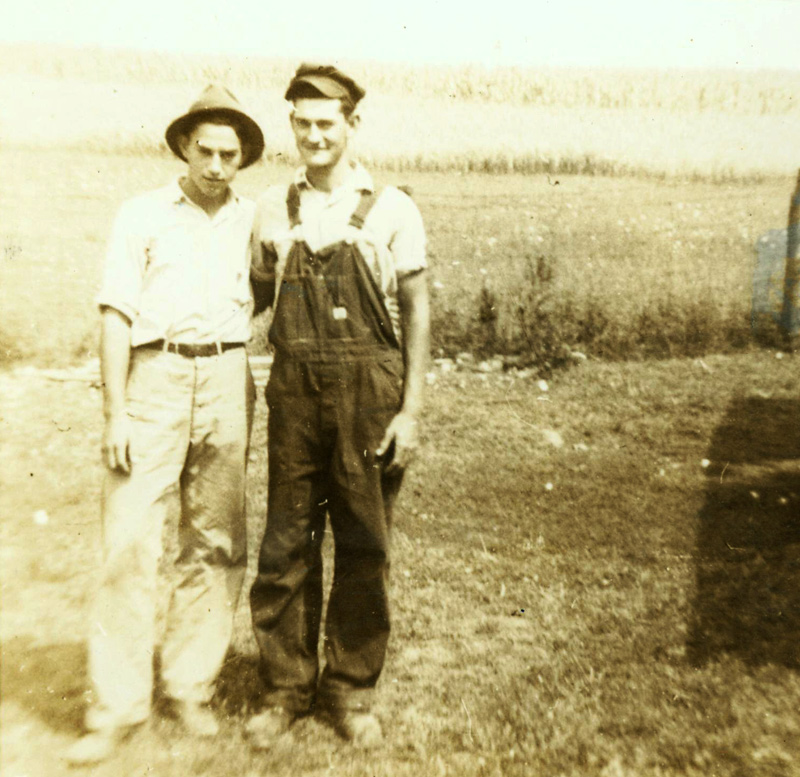
We’d go several hundred yards into the hill, some of ’em. We went all the way through some of the hills and have air shafts down on the far side of the hill for ventilation. Of course, as we went, most of it was slate top, and we had mine timbers cut all the time. As we went ahead we’d timber, set the columns, props or posts along as we went. The rooms would be something like twenty feet, and then if driving double rooms they’d leave like a six or eight foot column, they call ’em pillars. We speak of pillars, that was solid coal and that supported it. They wouldn’t stretch it too far, you know, to the top. We didn’t remove that coal because we needed it to support the roof.
And every eight to twelve feet, why they’d break through just enough that a person could...for an escape hatch. If something happened over here, if it didn’t get him, he could go through there and get into that other room, like if there’d be a weak place or a slate fall. And then it let ventilation, it caused the circulation of air, too. These tunnels were interconnected for safety reasons usually. You felt more comfortable if you knew you could get through if something happened over here where you were you could get through on the other side and get out.
I was never involved in an accident. Very lucky. Once you worked in there, why you get accustomed to it. You know signs that you pay attention to. If it’s bad enough you abandon or you get out of there till, maybe for a period of time to see what it’s gonna do. Now sometimes like the roof on the edge of that ceiling, if you had an overburden and sometimes you had worked, you didn’t know it, but maybe you worked under a huge boulder of lime or something, and you had wet weather, maybe along the edges you could hear it chipping. You’d hear it chipping along. Well, you know there was a lot of pressure there, and it’s time to get out and leave it alone for awhile. Sometimes on more extreme cases, we’d gone in and maybe a few of the posts would be almost a collapse. You could tell they were under stress. Yeah, time to get out of there. Quit that.
Miners usually went to work pretty early. Six–thirty to three, three–thirty. That was about. Miners usually went to work pretty early, and then they’d knock off about three. We were paid by the ton of coal. We got a dollar and a quarter a ton of coal. Not overburden. That coal went over the screens and sometimes you would lose some on what they call a screening. Dirt, you know. You just can’t get it all clean as it ought to be, but it worked out pretty good. Two of us we could run five ton a day, so I don’t know what that adds up to. Divide it by two.
Big wages. Then the miner, in those days we bought our own powder and supplies. We used carbide lights, and we had to buy carbide. And had to buy blasting powder and fuse and paper to make the cartridges out of. That come out of our diggin’.
We were a small operation, and there was no union. There was a union in the bigger mines, and once in a while when they’d come out on strike, why they’d come around and tell us. We’d just take a little vacation till they’d leave, you know what I mean. We didn’t aggravate ’em ’cause they was all our friends. Down in what they call Mohawk they had bigger mines down in there. Then stripping come in later years, early strip mining, down in, they call that Mohawk or down at, from Number 10 down in that part of the county.
When the people up in the Hocking Valley would...you know that was quite a mining place, Nelsonville, Canaanville, all up in there was a lot of mining up there. Well, they was really hard–nosed union men, and when they’d be trains of them come down maybe they’d come around and so we never give ’em any trouble. We just come out for a while until things got settled down. We never scabbed on them. Nobody ever asked us to, and we wouldn’t have scabbed.
We just took a little vacation. Everybody was happy. I had relation up in the valley. I didn’t want to get on them. I didn’t want to get Uncle Jim and all his boys on me. It was a good bit easier to cooperate. Well, that went on until the spring of 1941. The fella I worked with there at the last, his father worked with us till he got the age that he quit and he sort of retired. John Drummond and I went ahead with it, and John’s younger brother Ernest was working on the maintenance of way for the B & O Railroad.
He knew how the mine tapered off in the spring, so he mentioned to me one day. John told me one day, “Ern said they’re gonna hire, they’re gonna put a few men on for the summer on the B & O.” He said “Would you be interested?” And I said “Yes, I would.” So I got with him, and he filled out my applications and they sent me to Chillicothe and I was examined by the railroad examiner and passed the physical exam with flying colors. Eyes, many things. Eyes, hearing, colors. Colors was a real thing then on a railroad. They wanted you to know from a red flag to a green flag, you know. So, sure enough, March 11th ’41 I went on the railroad.
My first job was trackman. I started here at Jackson. A trackman, those gangs at that time was about four trackmen and a foreman, and we all worked together. If we was putting in ties we all worked on that. If we was laying some rail we all worked, we just worked together. Maintenance of way. That’s what we were, maintenance of way.
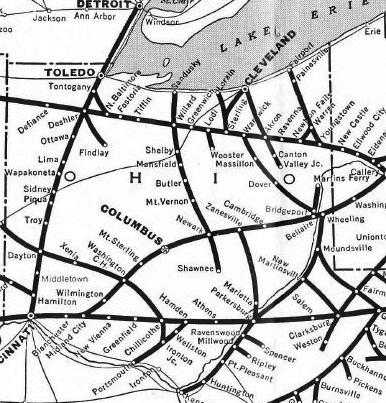
I was on the Portsmouth Branch of the B & O. It starts off at Hamden, comes down through, now they had a section from Hamden down through Wellston and down to Berlin. This section here went from Berlin, from Jackson up to Berlin and down to Keystone. We had, let’s see, eleven miles of main track and then they counted it three mile over to Jisco. We were responsible to maintain that track, plus the Jackson yards. It’d just be a rough guess, side tracks and all, the Jackson yards might as well add at least another mile and a half or two mile, anyway.
Classification yards where they did their switching and storing, the empties and the loads. The trains would come in with loads, you know, and they had to have a place to set them. Then as they did their work, they’d get more loads and take empties in their places, and that’s what the yards are for.
At that time we had one passenger train. It come out of Portsmouth every morning and went to Parkersburg. It was a diesel electric unit with two coaches, and that same train come back, over and back every day. For local traffic, it was just occasional, maybe somebody was just coming up to Jackson for the day or over to Athens. A lot of ’em went over to Athens to shop and then catch it coming back.
The B & O track ended down at the steel mill, at the lower end of Portsmouth. They left the Portsmouth Branch at Hamden. That’s a main line. If they wanted to go parts east and west, they’d go from Portsmouth up to Hamden and then switch to another train. At that time there was Eleven and Twelve and National Limited. Parkersburg was east on the main line from Hamden. Chillicothe was west. Just across the river and you come to the Parkersburg yard and their depot is just real close, right over to the other side of the river bridge. One passenger train every day. They just had the unit and they carried the mail and the baggage car and then one coach.
There was also what they called a Chillicothe local. It come out of there...back in those days was steam you know, a big steam engine...it come out of there headed toward Portsmouth. It come out of Chillicothe every morning, and it would make its way to Portsmouth. Chillicothe to Hamden to Portsmouth. Come down the west wye and into Wellston and I don’t think they did much at Wellston, but they usually had the furnaces running then. They usually had several cars to set off here at Jackson, and he’d work his way on by, and of course Oak Hill was humming with the brick industry at that time. It had boxcars, maybe a whole string of boxcars to set off down at Oak Hill.
Now this local, he went to Portsmouth, then he’d head back to Chillicothe. Usually he’d come back in here, oh maybe around midnight or two o’clock in the morning or if it was light work maybe ten o’clock, but anyway he went back to Chillicothe. At that time they had the long hop and facilities up at Wellston for these locals. There was a local left Wellston for Portsmouth every morning, and one left Portsmouth for Wellston every morning. They’d pass someplace from Oak Hill, according to the work. They’d work all these sidetracks. They both had empty cars, and they’d start out and they’d put in empties for of course what their agents had lined up to do.
All the manufacturing plants would have had track off the railroad track into the plant. Sidetracks. Now this Chillicothe local, his big load would be steel from down in Portsmouth. Steel was a big thing down there, you know, and that was its main business. It went to Detroit and all over the United States, Bill. Wherever they needed steel.
They did not carry a great deal of coal. There was some coal in places like down at Clay and down below Oak Hill. There was a few coal docks. They called them coal docks, where’d they load hoppers of coal. But it was mostly brick and steel from the steel mill and brick from the Oak Hill area and on down for clay products down in the southwest part. I can’t remember all the little old switches that went into clay mines, just the bulk clay. That’s why we had a brick industry here. We had good clay, and plenty of it.
In addition to the B & O there was the C & O Railroad. C & O come out of Logan. The C & O come out of Logan down through Wellston on down through Coalton that way, and the B & O come down through Berlin and down through Petrea at that time. Each railroad company had its own track network. That’s the C & O over there by the old cigar factory or over by the foundry, and he dead ended right behind Globe Furnace. That was the end of their line. Globe had a yard on that side where they’re kinda figuring on makin’ a park and that was the C & O yard. Below Water Street. They had several tracks in there. So did B & O and D T & I.
The D T & I ran over...by agreement, they ran over the B & O from right over there at what we call the light plant, you know, over on Broadway. They went onto the B & O right there and come over past and got orders at the depot, and then they ran. They couldn’t pick up or set off anything until they went off of the B & O down at Bloom Junction. That’s this side of South Webster. Before you make that big curve going up to Webster. Well, they went off to the left and toward Ironton. So D T & I actually ran over B & O track in a good part of Jackson County, and we maintained the track. D T & I couldn’t do any work between there. If they did, they had to share or give it to the trainman and the B & O. If they break down they could set off. If a car’d break down or something, why they could set off in our sidetrack and notify the agent, but they couldn’t do any switching or pick–up or set–off cars.
D T & I run a lot of coal from down Ed Clark’s Pedro and down in that country. They picked up a lot of coal and brought it up. They took a lot of it on to Ironton, too. You know as they get onto the N & W. They’d turn it over to the N & W and she’d go on a big track up north. They had a good railroad down through there, and it worked out real nice. Now that, that was six days a week. For years and years they run to Ironton and back.
At that time we had three railroads in Jackson County, each with its own set of customers. Each had its own track except D T & I ran on B & O track by agreement.
Bill, maintenance of way was just what it says. We maintained the track and we tried to keep it in good shape. In the summertime you can put ties in when it’s not frozen, you know, and things like that. Well, they’d have a tie program from like the last of March through August, they’d put in ties mostly. Mow, keep the right–of–way clean and do crossing work.
We had on the average a foreman and four men and sometimes they’d upgrade that in the summertime to maybe eight men to increase production, get more done. They didn’t like to have too many men around when it was frozen up. About all you could do would be tighten bolts. We did all that by hand, too, in them days. Big wrenches, you know, and go along and tighten bolts and replace ’em if they was bad.
On the joints that held the rails together. The rails, most on the main lines the rails were thirty-nine foot long. Some of ’em was thirty-three foot and some rail was thirty foot six. Most of it down the branch here was a hundred pound rail, upgraded from the old eighty-five. Now we’ve got a hundred and we’ve got some hundred and twelve pound rail down here. All the yards and every sidetrack had switchlights that burned kerosene that had to be refilled, cleaned and lit or checked twice a week. You’ve seen those switchlights. Now they do that with, most of it’s done by machinery.
The old handcarts on the rails? Well, Tom Hughes and Loren Mercer, they had twenty years service when I joined ’em over here on March 11th, and they had taken the old handcars in just a few years before and they come out with motor–driven cars. The Fairmount Company built motor cars, and they was a one–cylinder belt–driven outfit.
We drove them up and down the tracks. You’ve seen these little push trucks. Four–wheel push trucks at the coupling. We need to take out ties or cadge the bolts or you know, just transport heavy stuff. Rail. We could haul rail, switch points. Those old motor cars, boy, settin’ out there like a bunch of birds on that limb, we’d about freeze to death.
I went home one evening, you know. Us guys a certain age...I think it was October the 16th. 1940. I got my card in my billfold, that we all a certain age of us had to register for the U.S. Army. They registered you, all the men a certain age.
Let’s see, about July 20th the next year I come home and I had a letter from the President of the United States telling me to report to the draft board, 9 o’clock on the morning of August the 12th, 1941. I got a greetings, and I was gonna be with him or the Army for one year. That year stretched out to three years nine months and five days.
This was before Pearl Harbor. So, on that appointed day, why I went to the Courthouse and Clark Cleland was head of the draft board they call it, from Wellston. Clark Cleland. He was associated with the Milton Banking Company and a very nice gentleman. He was head of the draft board at that time, so he met us there and had our orders in a big envelope. There was three of us. Wilma’s brother and Hal Edwards came from Oak Hill. We walked up to the Gibson House and waited for the bus that left about 9:15 there.
We just got our orders and got on that bus. We come down through Oak Hill and on to Portsmouth, picked up two or three guys along the way that had notified them that they’d be standin’ out along...people did that then, they’d catch a bus down toward Firebrick, down in there, you know. Rather than to come to Oak Hill or someplace, why they’d just flag the bus down and get on and go on.
We got down at Portsmouth and oh, the group would be about eight or ten by that time, I guess. A whole flock of guys got on at Portsmouth, and we started for Huntington. We got on another bus that went from Portsmouth to Huntington. Then by the time we got that Huntington Armory, why, there was a whole busload of us. A lot of the guys had come from West Virginia cross into, they got orders to meet ’em at Portsmouth. You know, across the river. Different places. A lot of West Virginia and some Kentucky boys.
We went to the old Huntington Armory. They met us over there, of course, with the vehicles at the bus station. They took us direct down to Huntington Armory. As I remember, I was drafted directly into the United States Army with no choice at all. We just had our orders to report and, as far as I know, we all went into the Army. We was the only three out of the county of that call, and I’ll say about two to three weeks before that a buddy of mine and several guys was in the first call. That’d be, oh, middle of June.
We were the second call. The last time before that would have been First World War.
Well, then, they took us to hotels and gave us our lunch and loaded us up and took us down to Huntington Armory. We was examined, full physical examined there at the Huntington Armory. When they got done with this particular group, why we were all sworn into the Army. I was 23 years old at the time. I guess I had a feeling of apprehension and fear and bewilderment. I mean, you know, on that day you completely change from one life to another. I mean at that hour. And I didn’t have a great deal to say about it.
I think most people that was really concerned about war coming. I know I heard the older folks talkin’...could well remember World War I. I think they could see that we was gonna get in another war.
We were inducted about 4 o’clock in the evening, and we got a grand pay of $21 a month for four months, and then if we didn’t goof off or something, why at the end of four months we got $30 a month. Boy, we really got a raise.We had to pay our insurance and laundry. And we all had to buy cleaning equipment for the rifles. We had to buy a bottle of Hoppe’s and two or three things to clean ’em or an extra shaving brush to clean our rifles with. We had to buy a lot of shoe polish because we scuffed up our shoes pretty bad in basic training, so we had to keep our shoes shined.
We shipped out from Huntington the next day, afternoon, and went down to Fort Thomas, Kentucky, and they unloaded us down there. We went by train. We went by train from Huntington. Boy, that was really a treat, get to ride on a passenger train. They assigned us to barracks down there at Fort Thomas, and the next day they started givin’ us our shots. First series of shots. We were there about three days, I think, and they sent (of course it’s hard to keep track, you know there’s guys comin’ and a goin’, you know) but the group I was with, they sent us to Fort Leonard Wood, Missouri.
We were Ohio and West Virginia boys and a sprinkling of Kentucky. Mostly Ohio, but a good many, say about a third maybe, were from West Virginia and then a scattering of Kentucky boys. They gave us some testing. I believe they did take us in a couple places, groups of us and they had us to fill out some forms. Of course an instructor went along with each thing and it was kind of a mark “yes” or “no” or a choice of something like that. It wasn’t much really to concentrate on it because you didn’t know really what it was all about anyway. I think that was the main object, to try to figure out the ones that could read and write and ones that had been, say from elementary school to high school and if there was any in college. I think that’s what it was about.
2—Basic Training
Fort Leonard Wood was a brand–new fort or post. It was a fort named after General Leonard Wood of World War I. He was a famous general there. The government bought, I think, a good part of Missouri down on Big Piney River for way back, about ninety miles from St. Louis. Boy, it was back in the woods.
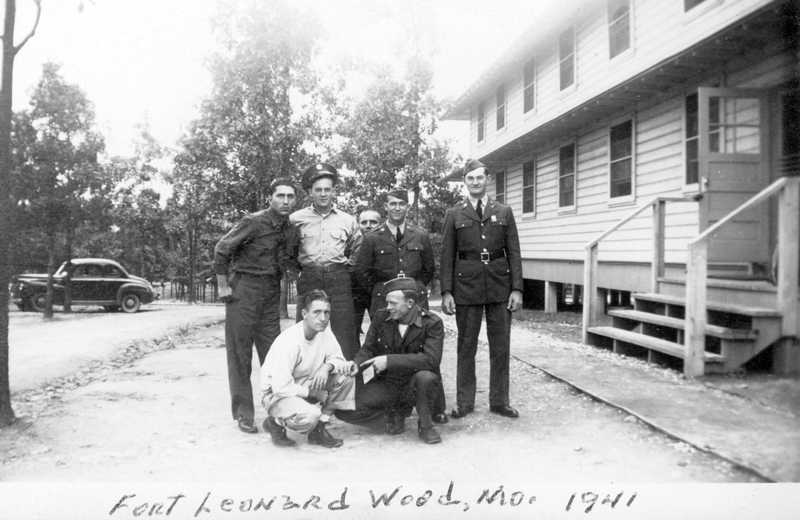
I think we were the second group that was in there, and they was building barracks furiously and churches and rec halls and kitchens and building the hospital. Putting up water towers. They was actually constructing then. They used us, a lot of our manpower, to help do a lot of those things, just as training. Fort Wood was basically an engineer training center.
Naturally they had the headquarters way out and then the huge drill field. Then they had, off in every direction, they had different parts of training areas, you know. A lot of ’em were really out in the woods, too. I expect it was five mile maybe from the post down on the Big Piney River—they had their pontoon and bridging school down there. I kinda had a feeling that they run records, what we did in civilian life, and I thought maybe since I worked on a railroad, that maybe I got in the engineering department.
In Basic Training, you get up in the morning and you stand reville. You been through that. You stand reville, you get your breakfast right quick and you got so many minutes to go to the bathroom and shave. You had to look up on the bulletin board on the side of the orderly room what the first uniform was. Whether it was fatigues or o.d.’s or khaki. We went in khakis first.
So, whatever it was, why that’s what you put on, and then when the whistle blew you fell out in the ranks. Maybe they’d close order drill you or march us over to a big drill field and you go through maybe a half hour or so of drilling. By platoons and companies and battalions and all that. Then maybe they’d take you back and you had fifteen minutes to change from your khakis into fatigue clothes and fall out under arms with leggin’s.
It tickled me, I was tellin’ Wilma, they said “Fall out with leggin’s, under arms.” Some of the guys fell out with their leggin’s under their arms, and they said, “Get back in there and get them leggin’s on!” Poor guys, they done what they told them to. “Fall out with leggin’s under arms.”
Well, then, Bill, in engineering we started to basic engineer. A lot of it was done way back in the woods with hammers and just regular wood tools. We’d cut down trees and cut ’em up and build bridges across ravines and just whatever the Army needed. We’d build tank traps and things to...like we’d set posts, and put another log up on there, and then just over a little further set a nail. A tank try to come through in the night they’d run up on them and get hung up on them. Stuck, you know.
Usually second lieutenants and staff sergeants did the training. They’d been through it enough they had it down pretty pat. We also had night problems, map reading, compass work. There was emphasis on engineering from the very beginning. This was Engineering Basic Training. Different from regular infantry basic training. Besides, we got infantry training over on the drill field, and we’d have days that we just did infantry training. Rifles, you know. And different formations and different signals, without saying anything, you know.
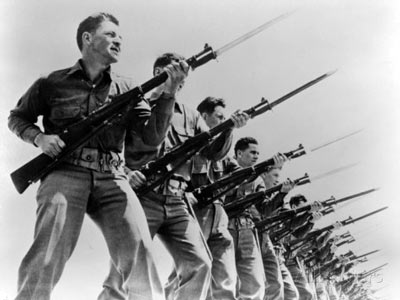
By squads, platoons, and we had lots of bayonet. At times we had lots of bayonet drill. The Army still drummed on the old bayonet, and we’d drill and drill on the bayonets. How to stab it down in. Like a company, they’d string us out in two big long rows. You with a bayonet and me with a club, but we’d keep the scabbard on. Take it off your belt, so we wouldn’t really hurt each other. You didn’t aim to hit anybody, but you’d see that man goin’ through the formation, and you’d visualize what he was gonna do to you. Maybe you’ve been through bayonet. Did you have any bayonet drill?
Really down in the bayonet there’s steps that you went through with, if you missed the first plunge you didn’t just back up and take off again. You had another option. The short, the short and the long and the butt cut...slash, you know, and it was really somethin’. It seemed awful horrible. I’m thankful I didn’t end up doing that.
Pontoon is of course using the assault boats. The small hand–operated assault boats, where each squad had to do their own rowing and go across the river and get out of the thing and, and make a charge up over the hill and get that done, get back in and get across without upsettin’ or somebody gettin’ drowned. Then that was part of it and then we went into foot bridges, putting foot bridges across, and then, playin’ like we was the infantry, goin’ across the foot bridges on attack. Then graduated up to the bigger ones where a jeep could cross, actually up to where a two and a half big truck could cross.
They really put it to us. They had the material stacked, like a school you know, they had the material. Now down on pontoon, up in these other training areas where we cut all the timber ourselves in assigned patches. They had it patched out you know. They didn’t at random cut the woods down. They just cut a few, enough to demonstrate, you know. Sometimes use the other stuff that they had.
We built what they call the bent type bridges, like we use today you know, the bents and then the stringers and the decking. We worked, a lot of us, with ropes. We had lots of classes with ropes, tying of knots and different hitches, and threading block and tackle. They’d team us up on block and tackle and see which gang could set a block that could drag the other ones. Things like that made it more interesting.
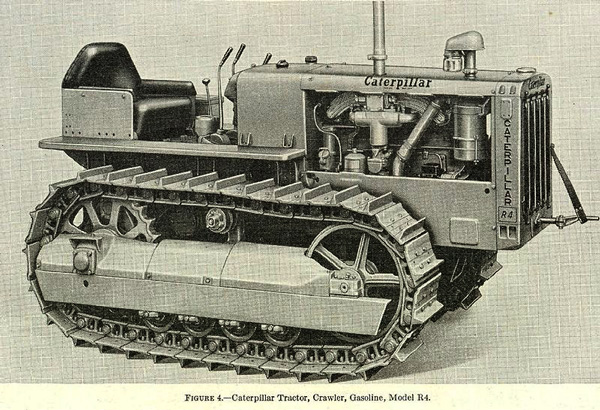
We had very little training at Basic on heavy equipment, but we had a little bit of training with a little R-4. The R-4 was a gasoline cleat tractor. He was a little small cat. But some of the boys that was more adapted to that, well they give them more training than others. They didn’t drum that too much. If a fella, if his records...they kept pretty close records of us of course. If you seemed to be adapted in the mechanical end of it or something or equipment operator, you might end up in H & S Company, heavy equipment and supply.
The Army really tried to screen us at an early time so that they wouldn’t waste a lot of time with somebody that wasn’t adapted at all for engineering work or try to train somebody for heavy equipment into something else that they could use ’em otherwise. Move things along better. We took several tests along that line and it leveled out pretty good.
The sergeants, as far as I’m concerned, were well qualified. I don’t just know how many groups they had worked with, but not very many. They seemed to be well qualified to pass on their knowledge and training to us. We were one of the first groups that these sergeants were training. It was really a new fort, and construction ever’place and right beside our unit there was new buildings going up. Each battalion had their PX, their church, and rec hall and of course their barracks and kitchen altogether.
Discipline and drill was quite strict. They didn’t allow any clowning around. It wasn’t just all drudgery, but they kept us busy and kept us training pretty well.
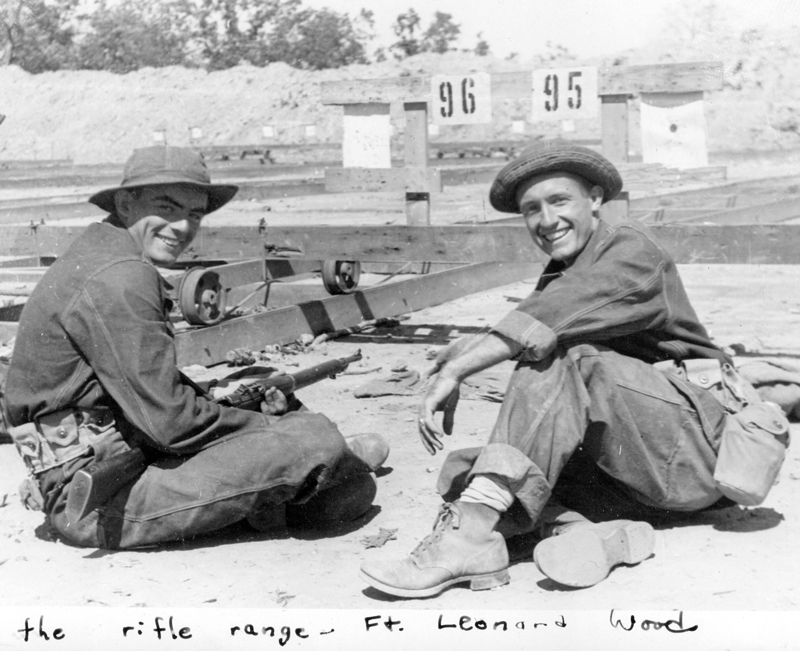
The weapons in the Basic Engineers. We trained with World War I Springfield ’03 thirty caliber rifles with bayonet, and we practiced grenade throwing with dead grenades. No live grenades. We got the idea of the proper way to throw a grenade, and we had some hand–to–hand combat training. I got the impression that we would probably need this training, combat training right along with the engineer work. I thought that they were trying to get us accustomed to the different procedures and what we might face on that.
Personally, I didn’t have any injuries in Basic Training. We had a few fellas that got working with tools. Some of the fellas had never seen a two–man crosscut saw or adze or had a real good sharp axe. We had a few injuries, but nothing real serious, I’m happy to say.
The barracks were the double story with the latrine and showers on the ground floor, and they were large enough to have two squads down and two squads up. Twelve to thirteen men to a squad. So this would be a platoon barracks. They had a coal–fired furnace outside the entrance in the front of the building on the ground floor. It was back near the showers, on that end and the toilet facilities. It heated the water for the showers.
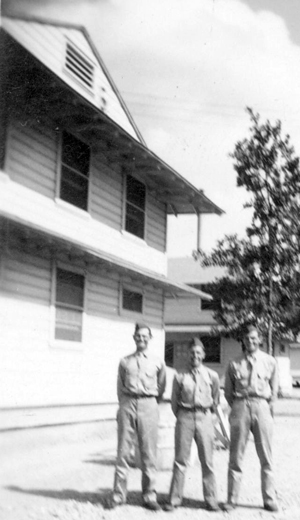
Upstairs was a little room that would accommodate about four non–coms, but our platoon non–coms stayed right in the barracks with us. For the Company area we laid out the three barracks, kitchen on the upper end and the supply. The supply and order room shared the same building right on the end.
We started out with a canvas cot, folding cot, just for a few days, and they brought in a single one–person bunk. Single, with mattress. It was a metal cot.
The barracks were standard design, all over the Army.
I can’t remember of any women at Fort Leonard Wood. No. Even over at headquarters I can’t remember there was any women. Our medics seemed to be all men, giving shots and doctors, all men personnel. Nor can I remember any black soldiers at the Fort.
We had very few passes. We were pretty much on base. They seemed like that they had a pretty tight schedule and they wanted to get it worked in, so not very much. Along toward maybe about the tenth week of the thirteen weeks they started a lettin’ a few go into St. Louis, which was ninety miles away. They had buses that ran from the Fort into there, and all the outlying little villages which wasn’t very close were off–limits. Had to have a pass if you stepped over the line.
They had a rumor around that the group before us had one suicide. A fellow got depressed and they didn’t get to it soon enough. After they got into going to the rifle range he’d evidently smuggled a round of ammunition and shot himself in the barracks. In one of the little upper rooms. That’s about the only tragedy I can think of. Now that was before, that was a group before we got there.
Thirteen weeks Basic Training and it was getting up toward Thanksgiving time and we finished up and I remember the fellas began to ask about “Are we gonna get a leave? Are we gonna get a pass?” Well, they didn’t tell us exactly. Finally it narrowed down. “The next place you go you’ll get a ten-day leave and you can go home for ten days and then report back.” But that didn’t work out for me very well. I don’t know how about the other fellows. I was the only one out of my company that was picked for the group that was set aside to go to Ford Ord, California.
So, the appointed day that we loaded at, and the government had built a brand–new railroad out to Fort Leonard Wood. They had a yards out there that they brought in freight, supplies, and they’d bring out the coaches you know, that they’d transport troops on. So that’s where we loaded, right there. And we moved out. A troop train to Fort Ord.
Loaded us up on the train, and we headed for Fort Ord, California. “What about my furlough?” “They’ll give it to you once you get to your new place.” So you know, strange thing, now you know you didn’t, in thirteen weeks, I was in Company B of the Twenty–second Battalion at Fort Wood. In the company there was four platoons, and you know I was the only guy out of our company that went to Fort Ord. You know where Fort Ord is. It’s at Monterey, California. It’s right on the ocean, and it was an old World War I regiment and that was its home base. They was in France during World War I, and all regulars, you know. Here’s us first selectees. They called us selectees and draftees for a while, but that’s where I joined the outfit.
We went the northern route. St. Louis seemed to be a great big railroad hub, you know, Southern Pacific and Missouri Pacific and railroads that I’d never heard of. The B & O was what I was used to, sort of ended at St. Louis. And we went the northern route. I think we went on the Great Northern or one of those routes, and went down through the Grand Canyon. They stopped the train down just to let us look a little bit, up and down the Canyon.
It was something to see, a railroad goin’ down in there, and then I know we could, as we went up out of there, we could look up ahead at the three steam engines pulling the train up that way, and one pushing on the back. It was like a snake and we could look across and see ’em, hard to realize that you was on the same train. The last night, without seeing daylight, you could tell that you was quit climbing and you was going, it seemed like something told you you was going down, which we were. We’d went over the Divide, I guess, and was going toward the Coast and we stopped at Denver, Colorado about eight o’clock in the morning and what is it, Pike’s Peak over there. That was something for us to see, you know. There was snow way down on it. It was gettin’ up in November, and they begin, well there was a two or three inches of snow on the ground there then. That was the first snow we saw. Then we went on over to Fort Ord.
3—Fort Ord and the Pacific Coast
Ford Ord is right on the coastline. Just look out the various windows and right down there’s the beach, beach of the Pacific. It’s at Monterey, California. North of Los Angeles and south of San Francisco. We joined the 19th Combat Engineers Regiment. It was a regiment—six line companies and H & S Company. H & S Company is Headquarters and Supply. The line companies were designated A through F.
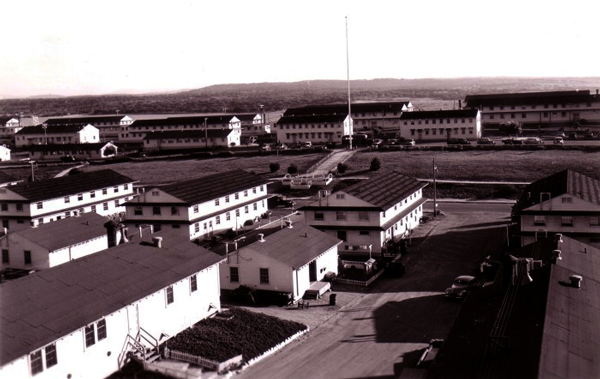
We were the first group of inductees or selectees that they had got. I thought I might bring that in because, see, we wasn’t volunteers. We were selected to the 1941 build–up in the Army. I’d say 95% of us. Some guys jumped in and volunteered just as soon as that happened, but most of us just went with the current and went in. We went in for one year training and service, and we understood that if we didn’t get into a war, they just wanted to train us and just have us sort of in reserve. But the situation changed right quick. We were basically soldiers in the Army, for good.
We were regular Army. We weren’t in the reserves. In answer to your question when did we get there, on the third day after we arrived the Japs hit Pearl Harbor. Now how I remember so well, all but just a skeleton force was left at...they knew we was coming of course, and they just left some non-coms and some officers and people to transport us. The rest of the whole outfit was out in the desert. What is that, the Mojave Desert? They were back there on maneuvers, so it took ’em a few days to get us there and get us our equipment. We didn’t have anything. We had to be issued our web equipment and our rifles and all that equipment.
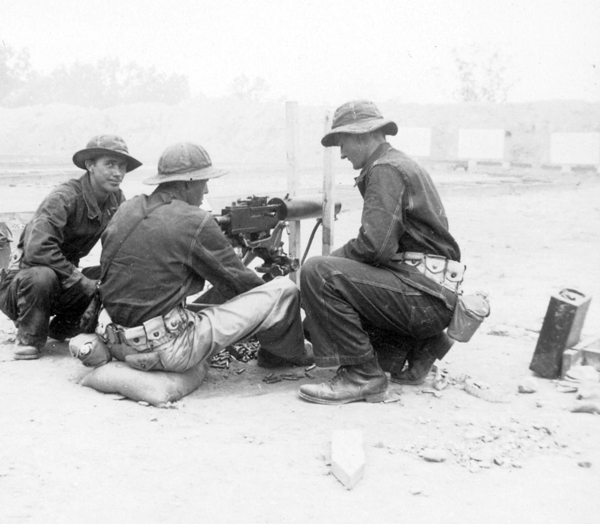
I think about the third day they loaded us up and took us out there. It was quite a long ways, several hours’ run out there. So I believe the next day...I was remembering that as soon as I got there, I was put on what they call a machine gun guard. Of course Army always had guards out, you know. Well, I was on a .30 caliber machine gun.
We joined the maneuvers, and they had this post on a real high point of a hill, right overlooking the camp, and we were there that night. The next morning about nine o’clock the Sergeant sent me down on an errand to...I can’t remember just what it was, whether it was for some rations or water or something, and he was just a regular sergeant. The Staff Sergeant, as soon as he saw me, he said go back and tell Sergeant Reeves to fold up his post and bring ’em down, that we’re moving back to Ord. That the Japs had hit Pearl Harbor. So, we wasn’t there very long after us new fellows got with them. We loaded up. By evening we’d broken camp and was on the way back to Fort Ord.
Do you want me to start with an individual company? There were three platoons, with three squads per platoon. Now they might run up as many as fourteen men to a squad. I’d say the basic privates and a sergeant and a corporal. Full strength, I believe that runs to about fourteen men to a squad, see, and then three squads to the platoon. Then there was a staff sergeant over the buck sergeant and then there was a first or second lieutenant that was the platoon commander. And the staff and once they got their T.O. of officers, why our first officer was first lieutenant of the company, but they were short of non–coms and officers.
Sergeant Green was an old Army regular. He was the First Sergeant of the company when I joined, and Captain Stogsdale, he was an elderly individual. He wasn’t with us but just a short time, but he was the captain. He was the company commander, Captain Stogsdale.
In basic platoons, they were riflemen at that time, and the mechanical operators were in the H & S Company, Headquarters and Supply. They had like a platoon in Headquarters and Supply, and part of that platoon was the equipment operators and truck drivers and those fellows.
The line companies would be basically doing engineer work, but they was quick to lay down the tools and fall into fighting, combat mission, which quite often happened. The privates would be construction laborers, and the sergeants, like in civilian labor, the sergeant would be the foreman or the boss. Whatever we was doing, bridging, building roads, clearing, clearing areas for something new or just whatever the situation was.
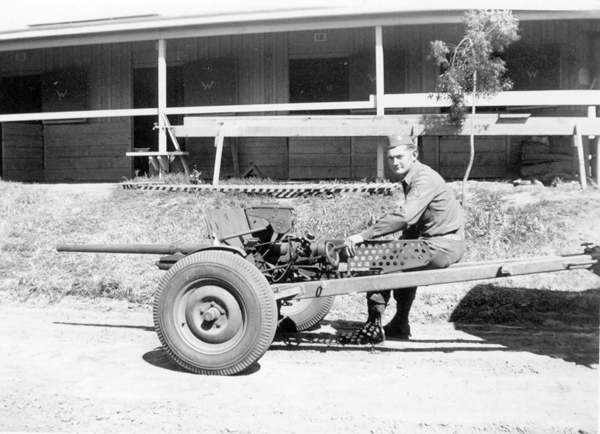
Each man had his rifle and bayonet, and when the situation changed, they issued each squad a water–cooled World War I type thirty–caliber machine gun. We also had live grenades, but they was kept under lock and key until we actually needed ’em. Later on, while we were still in California, each platoon was issued a 37 milimeter anti–tank gun. Along with that, each platoon was issued a half–track. The half–track was different from the infantry.
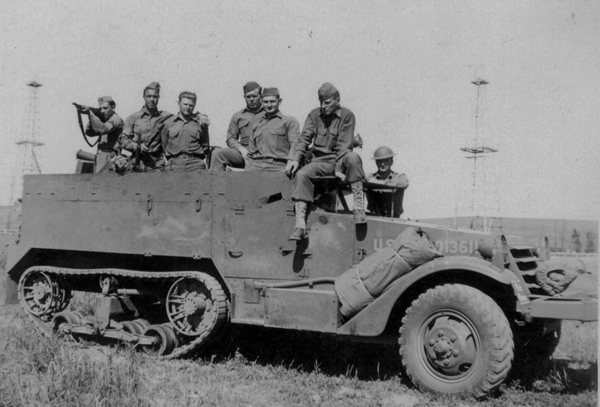
A half–track. It’s unlike a tank. It’s not enclosed on the top, or it doesn’t carry a mounted gun like a tank. It’s open–topped, and it was manufactured by the White Truck Manufacturing Company. It had a motor that had White on it. W–h–i–t–e. They was tremendously heavy, and the front part was just standard truck, guided front wheels, and then the back part was track. It would run on a highway or off. It was all rubber. The tracks were unlike the older tanks that were all metal tracks. They had rubber pads on the tracks. They were fast, too.
It was a new piece of equipment. The older fellows of the 19th said that they hadn’t had that. It apparently was a newly developed vehicle that the Army had adopted. It carried what we later called a weapons squad, and it was mounted with a fifty caliber machine gun, belt type.
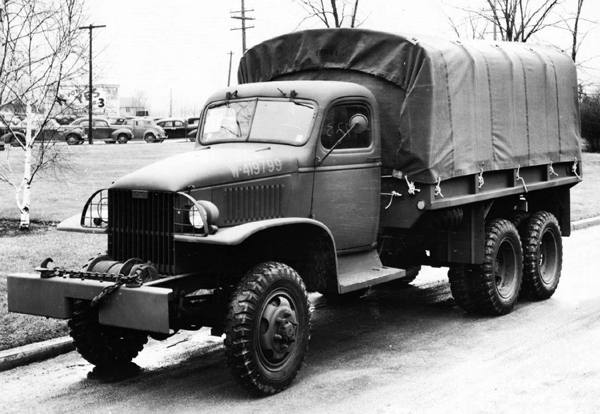
As I remember, they’d take the platoon and the three squads, and they collected the best men that the rifle range records showed, with guns. They picked three men out of each squad and built up a weapons squad. They were assigned a half–track. When we fell in formation, that really made four squads. See what I mean? Instead of three squads, we made four squads.
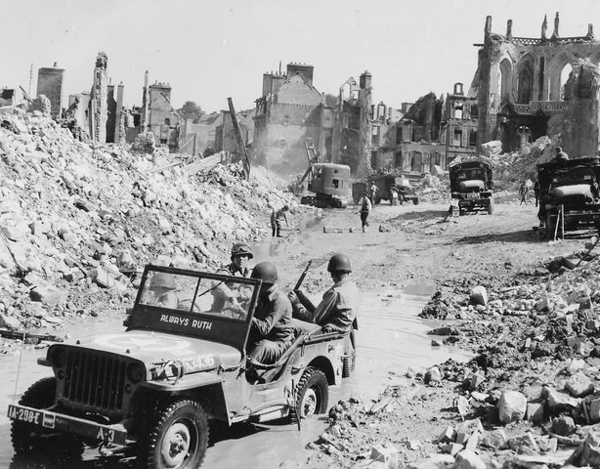
When we were just in bivouac or normal times, we fall out in company formation. Instead of having a truck, they had the half–track. Normally there was a squad of men in each truck. On the other squads I was talking of, about a fourteen–man counting the NCO’s squad, each had their own truck. Standard Army truck. Each squad in each platoon had its own truck for transportation. Each platoon had three trucks and a half–track. Plus they also had a jeep. They got beucoup brand–new jeeps. Willys jeeps. They didn’t have this stuff before.
We were ready. We didn’t have to walk. No, we didn’t have to walk a lot, they just wanted us to. We did a lot of walking, on hikes, and a lot of times ten miles. Well, we walked it. Each company at that time had a R–4 gasoline tractor bulldozer. You know what I mean? They was a cleat tractor, bulldozer. They called ’em an R–4. That’s a small one. Then later on, when we got into business, each company got a D–7, and then they upgraded to D–8. That was diesel–powered bulldozers which would make about three of the R–4.
We had heavy bulldozers overseas. Now this H & S Company, that was their responsibility. They had what we called prime movers. Huge, but they, at first they called ’em four ton trucks. Then, before it was over with, we had six–ton tandem, huge trucks that pull these low–boys that haul these huge D–7 and 8 bulldozers. That’s when we got really ready for business.
I don’t know how many they had, but we had like the county has these patrol graders. We had those with us to grade, make roads, air landing strips, anything that they needed. They were fast, they would run fast on the road. They were mounted on rubber. You know, just like you see now. They haven’t changed ’em a whole lot. We called ’em patrol graders.
This was at the company level. They were very useful. Most of the roads once we got overseas were like our secondary roads and the Army beat ’em to pieces. They were a great help to us to keep ’em leveled and maintained. When we got into North Africa, within four or five hours we could take one and make a landing for fighter planes.
In North Africa through Tunisia there was valleys of level ground and it seemed like we’d get away from the foothills and where the boulders were. We could take those patrol graders and make a landing strip in just a short order for the fighter planes or even the big boys. But they, the bombers, usually come from distance. Fighters kept pretty close to us.
Later on we got bazookas. You know what we mean about the bazooka? It was a rocket, battery fired. The bazooka. Each squad had a grenade launcher. One man was designated and given additional training on rifle grenade. They’d shoot a grenade three or four hundred yards, pretty accurate after a fellow got used to holding the rifle. That was the main thing. Usually they’d sit ’em on the ground in a leaning position and hold ’em at an angle. It took practice and training, a lot farther than you could throw one.
Then we got in this mine warfare. We carried land mines with us, a certain number in each truck. Headquarters kept that stuff as close as they could, but we couldn’t carry everything. We did take like fifty mines on three trucks. That’d be a hundred fifty of ’em. We could mine an area if they called for us to land mine. Anti–tank mines mostly.
In addition, now from the time we hit Fort Ord we had a gas mask all the time with us. That gas mask, there was a bill that went around the shoulder strap and it hung right under your left arm, and we had to take that thing to chow, but maybe I’d better back up a little bit. Once the Japs hit Pearl Harbor we went into a new chapter in warfare. If we left our tent to go just to the latrine or the kitchen or the orderly room, we had our steel helmet on. At that time it was a World War I doughboy hat.
Helmet, a rifle and a gas mask. And a cartridge belt, you know. That was something, too. It didn’t make any difference if you was just goin’ like from here to the garage you had to have that with you, and it was just gettin’ that tight.
The gas mask would smother you to death it seemed like, especially if it was real hot. You’d get that face mask on and it had to be air–tight under your chin, and the mask, it had a netting over your head and very uncomfortable. We never did use them in action. At the end of North Africa they took ’em all to the supply room and put ’em in big boxes. Those gas masks followed me completely across North Africa, but it was a precautionary, a safety thing.
We didn’t know what the Japs were gonna do, especially in California, and maybe I should back up. Do you remember when a Japanese submarine raised up close enough to shell the coastline below Los Angeles?
A lot of people don’t believe that, but at 9 o’clock this night, the orders come in for us to, with arms, load up as fast as we could. We were camped about two miles out of Pasadena, California, up a draw, at Devil’s Gate Dam. That was a water–saving dam that they have out there to catch the water in the wintertime and hold it for water supply.
What we did, when we moved from Fort Ord, you see they evacuated a great part of Fort Ord when the Japs hit Pearl Harbor. They practically evacuated Fort Ord. We, 19th Engineers, went down toward Los Angeles, spread out down in there. We, F Company, happened to go in there at Pasadena, and we cleaned up abandoned CCC camps. You know how things will grow up, and the three C’s had kind of phased out. The buildings were kind of shabby looking. They had headquarter buildings and two or three buildings there like they built, and they were just low long–like buidings, but we used them for the headquarters, and we quartered in pyramidal tents. Pyramidal tents will take care of, let’s see, about ten men.
In the pyramidal tent, the center pole went up and fastened to sort of a harness up there, but when it got up it wasn’t square like that, you know. It had about six corners. It looked like it had about six corners. It was handed down from World War One.
Other than that we had pup tents. Each soldier had a shelter half and one pole and six tent pegs. Two soldiers could go together and put up a pup tent. You are familiar with the old pup tent. They were great! If it was raining and you turned over, your shoulder rubbed the side and it started dripping right down. Did you know that? It would start leaking. “Don’t touch that tent!” Turn over and accidentally... Us tall guys, our feet was just barely in, you know.
Each company had their allotted place in pyramidal tents. This night at nine o’clock, a call come in. They rushed us down and we put up a defense up along the coast there. The Jap submarine had fired several rounds before we got there, and a few after we got there. A lot of people said that’s not true, but we saw they had a chain–link fence around the Sun Oil Company. You have probably heard of the Sun Oil Company. In California. They had these storage tanks up there, and a high chain–link fence around the whole thing. Most of the shells hit the fence and exploded. We saw holes shot through the fence. A couple tanks they hit just slightly below the top of the tank. Put a hole in them like that. About six or eight inches across.
I don’t know what size projectile it was. With the gauge of the tank, you know, it would hit it and bend in. I don’t exactly what size it was. But, luckily, it didn’t set them afire. We were certainly glad, because it would have been an awful explosion, a tankful of fuel. We stayed there all night up until noon the next day, and then they called us back to Pasadena. The sub left. We didn’t see it, though. The unit got a Congressional citation and the American Defense Ribbon for that little bit of action.
So within a few days we were spread out towards San Diego and Santa Barbara area there, with our equipment, digging in 155 artillery pieces for coastal defense. Now maybe I shouldn’t say this, but as far as coastal defense, we couldn’t see another thing along our west coast in the way of armament for defense. Maybe they had it on back someplace, but they rushed us down there and we took bulldozers and made gun emplacements for them and we dug powder magazines. With the dozers, and timbered them up. The coast was not previously defended.
Back to organization, there was three line companies in the battalion. And a headquarters company. And two battalions in the regiment. First and Second Battalions. Companies would be A, B, C, D, E, and F. Six companies in the Regiment. Our commanding officer was a full colonel. When we went there the First Battalion that they had us at, the commanding officer was Colonel Porter. He was an elderly looking soldier. He was a Lieutenant Colonel. Right away the commander...now he was the Commander of the whole Regiment...right away Colonel Moore. Evidently the Army was shifting their officials around and we got Colonel Moore, and he was a full colonel. He was the man with the eagles on.
We used that Devil’s Gate Water Reservoir for training pontoon and bridging. It made a nice place to play with our pontoon equipment there. A floating bridge.
They had us practicing doing everything. We took soundings, like shoot a mark over there and send a couple guys over there in a rowboat and they put up a stake. Then we’d follow that line and measure every so many feet to see how deep it was, and make a graph out of it. It come in handy once we got the natural bridging or crossing rivers. It come in handy. We knew what they was talking about, at least.
All the pontoon equipment was like plywood construction. The pontoons were wood construction. Open top with beams fastened right on them for your timbers to lay on. You know, your treadway. Once we got over in the combat area, especially up in Italy...we didn’t have to do much of that kind of work in North Africa or Sicily. But we got started up through Italy, we got into rivers, you know, and there was almost one hundred percent air–inflated pontoons. They could deflate them, and one truck could haul so many of them when they was rolled up.
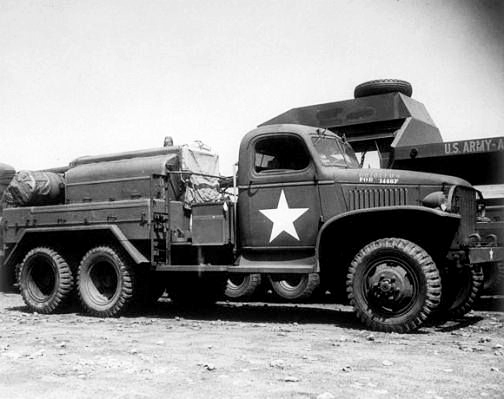
One other piece of equipment. Each company had an air compressor. A mounted air compressor. It was a LeRoi...manufactured by the LeRoi Company. They were just invaluable. Built on this six–by truck. Same chassis as the six–by truck. The motor and the compressor was right in one unit, and it had tool boxes on each side. It had the drills, the jackhammers, hose, and everything. They was just really a valuable piece of equipment. Do more work with them things. Even on ground for digging a latrine. We’d get the jackhammers for garbage pits. They was really a valuable piece of equipment. Now that was something new in the Army, too.
The last of June, getting up into July, we upgraded our equipment. Polished it. Getting ready to move to Camp Kilmer, New Jersey. So it took us a while. We had to load all those vehicles onto cars, and tie them down. You know what we mean by come-alongs. Rolls of wire. Everything had to be just right. Blocked and chocked, you know. Lot of work to it. Moving those vehicles. Getting ready the equipment...went right with us.
We went the Southern route. From Pasadena we went the southern route back East. We crossed Oklahoma and Texas. Then they went right straight towards St. Louis and from there up to Chicago. We stood in the Chicago yards the biggest part of one afternoon.
We had the equipment on train cars, and then there were coaches, Pullman coaches. We traveled by Pullman. I think we were just about all on one train. Maybe it was two trains. I’m not sure. We got to Camp Kilmer...it took us six to seven days to travel that far. At that time with the train traffic that was on the roads. It took us about a week to go, there all the way across to Camp Kilmer. We were there right about the first of August, 1942.
4—Shipping out overseas
There were lots of engineer regiments in the army. I know there was Nineteenth Engineers, Twentieth Engineers. There was Forty–Eighth Engineers. About every division had their combat engineers in World War Two. Probably one engineer regiment per division. A division had about fifteen thousand men.
At Camp Kilmer we didn’t unpack. I don’t know where they parked our equipment, but we didn’t even have our own trucks. They had their own trucks there at Kilmer if they wanted to take us on a motor hike or something like that. They wanted to get guys used to riding in trucks, you know, and loading and unloading. At times tempers, you know...you’d get all loaded up and you’d go about half a mile down the road and they’d stop all at once. “Everybody out. Get out and line up on the road.” They were just getting us used to in and out. In a group doing things in a hurry. Pretty good idea, I think.
More training. I don’t know where they had our equipment parked. Our heavy equipment. We didn’t have any. We were there through the month of August. The first day of September, 1942 we loaded on the British ship Queen Elizabeth, sister ship to the Queen Mary. The first day of September at nine o’clock that morning she eased out and headed straight down by the Statue of Liberty, got out in the open water, and took right straight across. When we loaded and went down and got on the train, every man had his full field pack, rifle, that infernal gas mask, the whole works. We had been issued the new type field helmet.
I might say that on the next berth, you probably read about that big ship that France had built prior to World War Two. The Normandie? Before the Germans got to her they brought her over to New York harbor. She was in the next billet. Our understanding what we read about it, they converted her into a troop carrier. Somewhere they claim by using acetylene torches and welding down in, she caught fire. There she was, just like a big fish. Laying on her side. Huge thing! It was a little bit depressing to be getting on one big ship and to see that big ship. We were all looking forward to it, but that was a tragedy. It was a fine ship.
Our equipment was handled by somebody else. We just hauled our personnel down to the docks. Went in from Kilmer by train. The equipment went by different ship. While we were at Kilmer, they loaded us up and took us down to Fort Dix and let us fire rifles on their range. Used Fort Dix rifle range. Didn’t seem like it took very long to get down there. We went in one day. We got to shoot our rifles and see if they’d work. Kilmer was just...we could walk, Bill, the highway down to New Brunswick, New Jersey. There was a house right on the street, with a sign there, “George Washington stayed here overnight.” How I come to remember that. We could get four–hour passes in the evening. So many of us, not everybody, but so many people.
What amazed us fellows was on Sunday morning, they told us no passes. Everything was quarantined in. No leaving. No goofing off. Stay there. By evening we were all ready to load. We’d turned in our bedding, and we had to roll up our mattresses and turn everything in to the Supply. We waited till dark, and they loaded us on trucks and took us over to the railroad and loaded us on the train. After it got good and dark. Took us into New York. Unloaded us, and we walked down the brick streets that were sloped down. Then we got down there, and we were just jam–packed like sardines on small trawlers or something that took us across a body of water.
When we unloaded there we were on a dock. There was stairs and there was the Normandie and there were steps going up into the Queen Elizabeth. Just all the lights were kind of a bluish light and we didn’t want nobody to see us or anything, you know.
We were on there about the third morning and of course they loaded troops around the clock. Enormous ship. We couldn’t understand all that security. On a bright sunny day we backed out at nine o’clock in the morning and go down right in front of everybody and past the Statue of Liberty and bear to the right and went straight out in the Atlantic. We thought we’d sneak out in the night. But they didn’t.
You know how guys will think of everything, you know. When they got out to sea, away from the harbor, you could just feel it. Vibrations, you know. And they was really pouring the fuel to her, and seven minutes she’d go like that, then she’d turn. You could look back and see that wake. Made it white. She’d turn slightly, and she’d go that way. We had to have something to do so we’d watch her wake, and, boy, right on time. They didn’t go in a straight line.
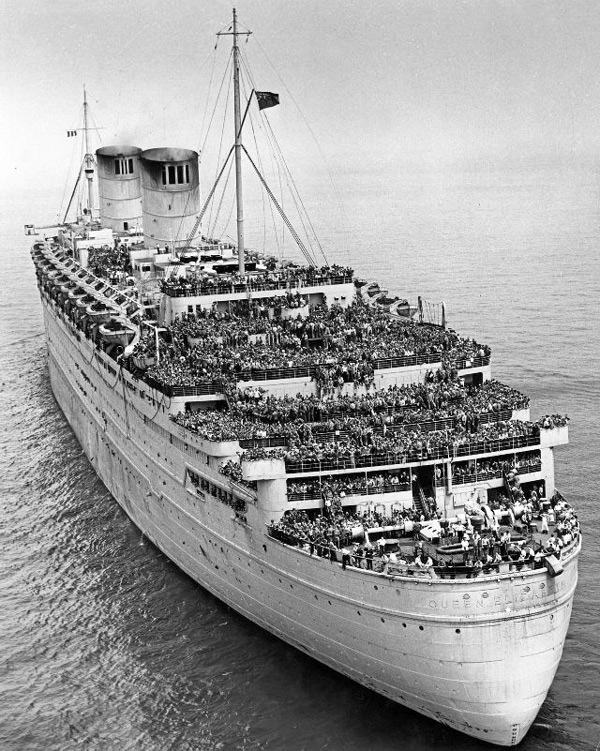
After we got organized, conditions on the troop ship were good. There was confusion the first day out about feeding. We didn’t know...they didn’t do this ahead of time, but they did it after we got on. Like, my group, maybe we’d get a card like a doctor’s appointment card. Mine would be green. Maybe yours in another group, yours would be red. Another’s would be blue. Another guy’s would be white. Well, I don’t know how many different colors was that, and then they had signs on there to the galley where they fed us.
On your card was the eating time. There was no use for me to get in your line with a red card and you had a blue card. There was no use for me to try to go to chow with you because when we got down there was guards at the doors and you just couldn’t get in. So that was confusion for a while. About a day. But it worked out fine once they got accustomed to it, because guys would know they couldn’t get in without the proper card. They said...I don’t know whether this was official or not, but they told us there was around twenty-one thousand of us on there.
In the sleeping quarters I was in, above the door, little room we know, about six feet wide, above the door it said “Accommodations for Two Seamen.” There was twelve G.I.’s shared that room. And likewise with the cot, they’d put instead of one cot on a side, they had six. So that twelve of us could sleep there for twelve hours, and then we had to get out and let twelve other guys get in. When we had to go out, why we could roam the ship, like up on the Promenade Deck. Every place that wasn’t off limits, you know.
I never saw a great deal of seasickness on the Queen Elizabeth. Of course we wasn’t around a lot of either, but boy, goin’ from Liverpool to Oran we was on a British ship, and a lot of the guys got seasick. Small, you know, on the Atlantic at that time. We hit the beaches November the 8th. The Atlantic gets rough that time of year.
You could look over at the other ships and see ’em goin’ like that, you know. You better not watch ’em too long. I was very fortunate that I never got seasick one time. Some of our guys never left their...where we was billeted, from the open deck down one flight of stairs, just like from the ceiling down here, the water level was up there at the ceiling. Then there were guys on below us you know, a deck or two, and it never bothered me a bit. I was very fortunate. I don’t know why.
I’ve kinda got a mental block, but you know there in Scotland where they made this sort of home base for the Queen Mary and the Queen Elizabeth. What is that, the mouth of the Clyde, is the Clyde River there or where is it, Bill? You probably know your geography there. It was like you know where the sea is big and goes inland. Well that’s where they eased her up there and they unloaded us off onto smaller ships.
We ended up at Belfast, Ireland. We went up to Belfast. I was on a small, about a battalion of us just made this little boat, the Princess Mab. It was a British ship, a small ship, the Princess Mab, took us from the Queen Elizabeth up to Belfast. We unloaded on the docks there and we went by truck about twenty mile inland to a little town Antrim. Antrim, Ireland.
The whole regiment was stationed at Antrim. Spread out at different...it was the British Army’s Quonset hut barracks, about two squads to a hut. We went on their rations. They had a central, like a mess hall, and got along pretty good. As I remember breakfast, there was some kind of a, well, it was between a stew and a gravy. I don’t know which one.
September, we must be five days goin’ across and then up there say another day. We must have got up there about the 8th or 9th at Antrim. Then we were through the rest of September up into early oh, it must have been right at the end of the month or a few days up into October.
Then they brought us back to Belfast and we got on the U.S.S. Brazil. It was a nice ship. We got American food on there. We came down to Liverpool, come down along the coast line to Liverpool. Boy, was our eyes gettin’ big. You know Belfast, Ireland, was one of the first major cities that the Germans really bombed. You could see those big buildings.
I know one particular gray, big stone church, the only thing that was left there was the steps, and the entrance doors and the arch. You know, it didn’t look like it was hurt a bit, but then the rest of the building was just a pile of stone. For some reason they bombed Belfast bad, and we came down to Liverpool on that there U.S.S. Brazil. Of course we unloaded on the docks and there was a railroad. There was a railroad and we got on. They loaded us on British trains.
Now I’ll never forget it, you’re probably familiar, but they had the redcaps, you know, the British redcaps. They was the M.P.’s of the British Army. They call ’em redcaps. They was doin’ a good job there gettin’ us on the train. The coaches, you didn’t enter on the ends and go through. The doors opened on each side like a carriage, you know. That was something new to us.
It’d been more comfortable if there’d been say four of us in there, but they put six of us in the compartment with all that paraphernalia. Barracks bag and your field pack and your rifle. It didn’t take us too long to get down there, but we went from the docks, they was takin’ us down to where we was gonna load there at Liverpool on the big ship. They had like great big warehouses or something. Well, I suppose that’s what it was, for freight. But they seemed to be, they’d emptied ’em, and that’s what they run us in there and held us in there. Then there was that waiting period to get loaded on the big ship that was gonna take us to North Africa.
Somebody else was handling our equipment. That’s amazing. Bill, we never saw that until we unloaded and hit the beach in North Africa at Oran and Patton hit over toward Casablanca. Patton, Casablanca, us at Oran, and another unit at Algiers, all at the same time. And here, just in a matter of a day or two, all these ships moved in and started unloading our equipment. Our same trucks, everything. We hadn’t seen these trucks since we’d left Pasadena. Now that’s really bookkeeping, isn’t it? That’s organization!
I’ve read in some of those books where they had special trained people and they loaded every piece of that so it would come out just right. A Company, B Company, it was all marked, you know, stenciled on the bumper. And it was amazing they could do something like that. You’d think that you never would see it again.
It was His Majesty’s...there was a great big plate on the stack right on the main deck...His Majesty’s Letitia. And the Captain, we assumed he was the Captain, he was broad-shouldered, old, looked like an old regular seaman. He had his cap on and his blue uniform with the brass buttons, and every evening, you’d never see him till about four o’clock in the evening. He’d climb that ladder up and there was a catwalk around the stack and the railing. He’d walk around and around that and stand periodically and look out across the ocean. He looked like he’d been at sea a lot of time, never seen him since. There was our whole regiment on that ship plus a lot of guys I didn’t know.
We was in convoy down, out in the Atlantic, and I don’t know just how many days, but it was several days we was in convoy. Right at that particular time the Atlantic was pretty rough and overcast, cloudy, overcast, very little bit of sunshine on the trip. And the seas was rough and on different occasions, one day especially, we had an alert. The seamen appeared from nowhere and started jerkin’ ropes and threw the canvas off of the ash cans on the racks. They were depth charges. They started rollin’ ash cans off and you could hear those things exploding.
The ships, you know they all have their flags across, those flags were just changin’ just like frantic, you know. You could see guys with this semaphore, the flag semaphore, oh the ships would be sometimes closer than from here to Eleanor’s garage. We could almost make out, if you’d been on one and we’d knowed each other you could almost and then other times you’d been oh, four or five hundred yards apart. Usually we was spread out more, but sometimes they’d get pretty close. Different days we went by drums and crates, barrels and things that would make you think, well, something’s happened along here some before we got here. Like something had been sunk.
Oh, gosh I’d say we could see at least twenty ships at the same time. Twenty or thirty. You know there you can see a long way in a ship. When we got down, they had it timed just right and we come right down there to Gibraltar. Well, just like ducks they started a comin’ out of a convoy into a line. Just like a duck we shot through the Strait of Gibraltar.
The weather cleared off and you could see the stars shining. So while each felt a little bit safer, each guy had his own feelings in a situation like that. Felt a little safer when we got into the Mediterranean, but then again we thought sure that the German submarines would just be lined up to shoot us like ducks when daylight come the next morning. But the Navy had taken care of that. They had minesweepers and their patrol boats with sounding devices that they was already ahead of us, I guess. And they was on each side of us.
U.S. and Royal Navy, and I’ve read in some of my books that...you see Patton and his Army came from the States. While we was goin’ from Liverpool, they come across the Atlantic over to Casablanca. Now we never did see ’em, but these writers on it said that our Navy was patrolling out of sight of the convoys and listening for subs, and the subs never sunk a ship. That’s amazing. They never sunk a ship on them convoys. All of ’em got through all right.
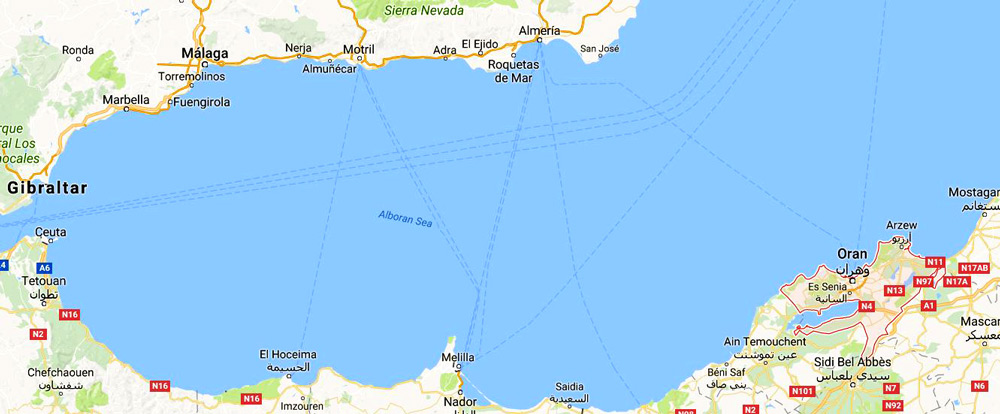
courtesy of Google Maps
Oran is a city in North Africa. It has a pretty big port area, one of the major ports of that part of North Africa. The French Navy was holed up in there, some of the French Navy. The part of the French government that sort of stayed a little bit along with the Nazis and then the Free French, you know...well, there was some of the French Navy in there that wouldn’t come in with us. I say with us, meaning the U.S. forces. They had a fight down there and they had to sink some of their naval ships down there before they’d...that naval commander, the Germans had their finger on him until they had to sink some of their navy down there in Oran Harbor before he would give up to ’em.
We heard some explosions. We’d just got around the Bay, there. We heard terrific explosions at night. They tried to make a run for it, and they got ’em headed off. I think maybe one or two of ’em might have got away.
Had a little experience I’ll never forget. We started unloading. Our ship got to its designated place which was straight out in the Mediterranean from Oran. We was right around the coast, like Oran was right around here to a little town of Arzew. Just inland from Arzew was, say a mile or a mile and a half, there was a small airport. Well, that was our objective, to knock that airport out.
At two-thirty in the morning the signal come to us, my group, to start goin’ over the side. We went from the top deck down to the British, they were escorting us in these little landing craft that’d hold about a platoon of men, from the mother ship, the Letitia, into the land in there, to the beach. They had a few bigger ones that would haul vehicles. I never saw any vehicles, but they were there, and we went down these rope ladders, full field pack on, a rifle and everything, and you had everything fastened off.
If we fell off or anything like that, why we could just unfasten our belt and slip ashore. They said don’t worry about the equipment, save yourself. So, luckily, nobody in my group had any too much problem. There was one or two got their legs through the group netting and got hung up and had to get back up and start again.
It was dark of the moon, I mean it was dark in there, no moonlight and you had just enough little blue light on the ship that you could see what you was doing to get in the landing craft. Then when you got goin’ you couldn’t see. We got away from the mother ship and goin’ on all right, packed in there like sardines. Here come an empty back from the beach, and we had a collision, corner to corner with theirs.
It broke the corner of the landing craft in till she started a takin’ water. Those guys, they just bounced off and they just went right on and we was hollerin’ and yellin’ at ’em. I guess there was just an act of fate that here come one of these bigger ones back to the mother ship, and they was close enough and they heard us and they made a U–turn and they come over and threw ropes over. We begin to list pretty bad and the seamen snugged us together and we all transferred over into the bigger one and they took us on in. So we almost got through the trip from Liverpool down there and almost got sunk in the Mediterranean!
That was really an experience. We got over there on the landing. We got on target over onto our landing area. As soon as we got organized we went over there and we’d been told that there was some opposition over there. It was a metal, corrugated building. We made a sieve out of that, and soon took care of that, and all was quiet then. Then we could hear this explosion and this problem.
5—North africa
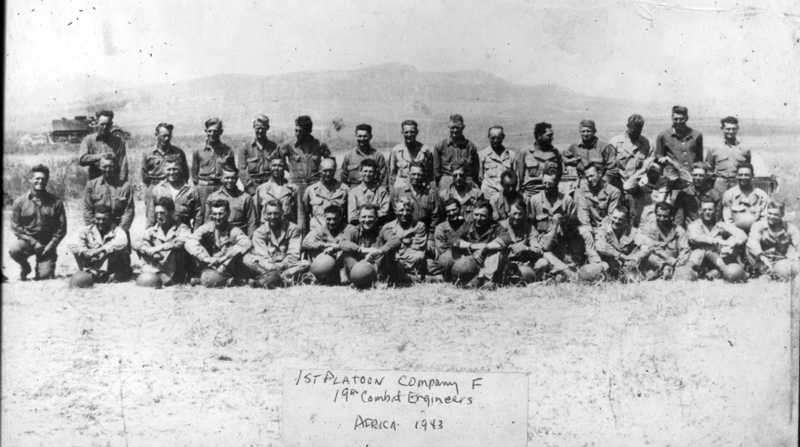
Lyle at Upper Right
We proceeded onto our objective of landing at Arzew, which was just around the coast from the City of Oran. East of Oran toward Algiers. We made the landing without incident. Everybody got ashore all right as far as I know. Of course there were several waves behind that I never heard anymore.
We went out, we got organized, and went out to our objective airfield, which I stated before had a metal hangar. We suspected that there was some German troops there that had got wind of this landing. So we fired several rounds through the building and made a lot of noise and got no response. They had left. So we turned back to our landing site, and by that time they had been able to bring supplies like some artillery ammunition shells.
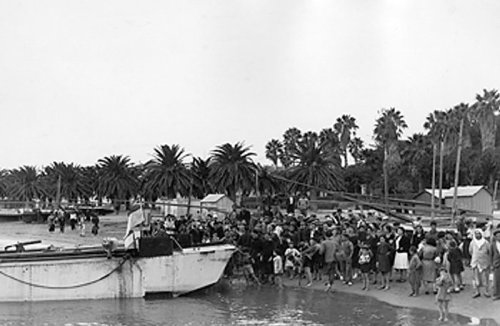
It was basically our regiment that landed at Arzew, as far as I know. The 19th Engineer Combat Regiment. By morning they had a few heavy artillery pieces there, and we continued to unload different kinds of supplies that was needed. We went back to the landing site and began to bring heavier equipment, like artillery shells and cartons or boxes that the shells came in. We were building up a staging area there at the landing site. It was a nice sandy beach and just a slight rise from the water’s edge up for, say, a couple hundred yards, and then the land began to get rolling and higher.
I think that they tried to synchronize their landings with low tide usually. It was more normal at the beaches at low tide. It would expose the obstacles if there were any planted or set up in there. Then it seemed like at low tide, it’s been my experience along the ocean it’s more calm, unless you’re having a storm, than high tide. High tide it seems like there’s more waves coming in. It’s more unsettled.
I think the general plan was for the French to give up the city. They was gonna try to take everything they could without the least opposition. The main enemy, the Germans...of course there was always some of the other faction that, even on the French side, that didn’t exactly know which side to go with. But that soon passed over and it was mostly French troops there.
As I recall, part of the French Navy that had got away from France and got to sea when France fell, why part of the French Navy was in Oran Harbor. For a day or two they had quite a bit of trouble. The commander, he either didn’t have direct orders to go in with the Allies, or he was under some higher command from the Germans which way to go, so they sank a few ships and blew up a few ships in the harbor. That lasted for oh, a day and a night and maybe part of the next day. They scuttled some pretty nice ships of the French.
Along in the afternoon we were alerted that there was some enemy troops inland about a half mile. They didn’t know exactly who they were or what, so we laid down our tools and took up our arms. My company, Company F, went back in there and spread out and established a line of defense. I was a buck sergeant and squad leader.
We went out there and formed a line and there was several rounds fired. We come to find out that it was part of the French Army in the same position as the Navy down in the Harbor. They didn’t know really which way to go. It didn’t last very long till they got together with the officials and the fighting ended. There were very few casualties. We didn’t suffer any casualties, but the other side I understand suffered a few casualties.
That was the first time I came under fire. It’s sort of a mixed feeling. It seemed like naturally as time progresses that you know there’s a possibility or probability that you’re gonna see combat action. You’re nerved up, you’re under tension, but it seems like when it happens and you get started on it, well that relieves you and then you’re more relaxed. I guess you’re not relaxed, but you just hope that the thing will turn out for the best. In other words you hope you’re not the one that’s gonna get it or something like that. The more you’re into it, why you learn a lot of things how to protect yourself and get the job done.
I thought that we were pretty well trained. We’d been through a lot of combat maneuvers here in the States, and we even trained a lot up in Ireland. We had field problems and come down to England. We were down there for two or three weeks, and we trained back in the woods and the open country back in there. We felt pretty safe.
After the fighting ended, we were pulled back. Our regular infantry had got established and they was making their perimeter back farther all the time and probing. We went back and started unloading ships at the docks at Oran.
As I remember, we were attached right away to the First Armored Division. From that point on we went with them toward our objective which was Tunis or Bizerte or across North Africa. First Armored had on their helmets and their equipment, their symbol was a shield with a big one. It was a red shield on the green helmet, or the GI-colored helmet, and with a big one on it. That was the First Armored.
When we landed there was nobody else there. We were the first ones in that particular landing area. What was down here and all around we had no way of knowing. It was at night of course. We started landing about 2:30 in the morning, started unloading I should say, and took our time to get over there, but we could hear some explosions or gunfire down more around the harbor at Oran. The city of Oran itself.
Arzew, the coastline comes around like this and Arzew is here. We couldn’t tell exactly till it got light, how our situation was. It seemed like the older and the business part of Oran is on sort of a high bluff overlooking the harbor. I got in there a few times after it got settled down, just a three or four–hour pass once things got organized.
They took us down on the docks and what they called Liberty ships started coming in. We unloaded truckload after truckload of all kind of rations and just regular army supplies. We were creating a depot there at the landing area. Just next to our dock that we was working on, just next to us. The next day a ship come in and they began to unload vehicles—trucks, jeeps, all kind of vehicles. It was the regular established dock. At Oran. There was no dock at Arzew. The docks were all over at Oran.
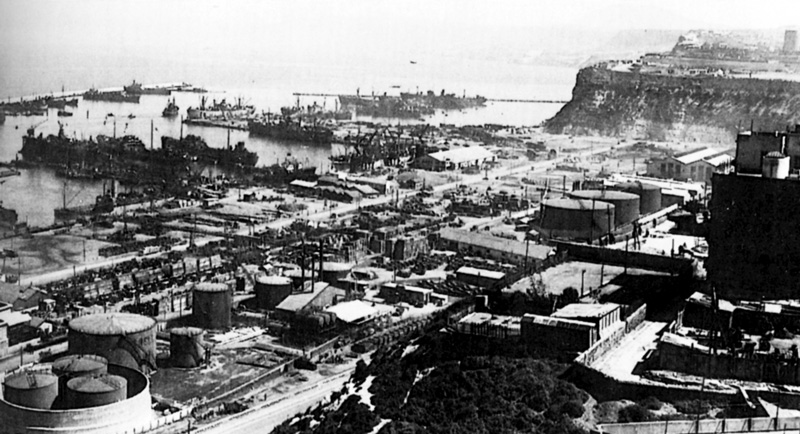
We had men up in the ship loading them up on these net slings. The sailors on the crew of the ship would operate those and they’d swing ’em like a truckload at a time down on the dock, and then we’d load the truck and just kept that up. It was amazing to us fellas. We hadn’t been around the docks of the Navy very much.
Those ships, you could almost step from the dock to the side of the ship. We worked in shifts and maybe we’d come back and it was right there, and when we would come back our next shift, it would be way up higher. The ship was rising up as the cargo was unloaded, you know. When a ship would be completely unloaded and way down in the hold, well you’d have to climb the ladders to get up on ’em.
They was very good to us. A few at a time we could go to their galley, especially when we was working at night. For a cup of coffee or something like that. The fellas on duty on the ship was welcome to come down as long as we kept it...you know, not a whole gang. Just a few guys at a time. The squad leader could regulate that. He’s the guy that keeps the things going.
We hauled the equipment and supplies mostly back on the back of the docks, there close. They had some warehouses like big open sheds. At the same time we were landing and all this was going on, the Air Force had taken the main airport back of Oran. On the high ground back of Oran. They had taken that, and the planes were coming in and going out. They were patrolling constantly, and they were building up, too, at the same time.
I didn’t really know for a few days what division that we were going to be with, until they got organized and got ready to start moving east toward the general direction of Tunis and that part of the country. I’d say it took four or five days or something like that. It took ’em a while to get organized. We were fortunate that they made these landings. I can recall and I know that the German forces hadn’t got there in force, and it was all very synchronized and secret. It was a secret landing.
I think it really surprised the other side, that we’d hit there. I don’t know how they did it, such an enormous thing that it was, all the activity in England, Ireland. General Patton coming from the States and heading down to Casablanca at the same time. The British and Americans together went into Algiers right on around the coast, and how they did that...It was either tied up with their activities over toward Greece and that part of Europe. It seemed to me that they had slipped in on ’em pretty good.
Now after a week or ten days, our platoon, the First Platoon of F Company, was detailed. We went as a platoon with part of the kitchen force, enough to take care of us. We went down to Sidi bel Abbes. It was a town inland. There was a small hangar down there that was kept full of what we call our little one–winger planes like they have around here. Like individuals have. It just seemed like they was in storage there. They was pretty nice planes, and they got several of ’em fueled up and checked and they were flyin’ them around.
As I recall they wasn’t armed. They was just small like these fellas have down at our airport here. Smaller planes. I imagine that they did work with our troops because gradually they was expanding the circle behind Casablanca, Oran and Arzew. They was probing, you know, the country.
There again they begin to send convoys of supplies down there, and there was a huge granary there. One of our missions down there, we was unloading those supplies and stockpiling or storing them in this huge brick granary. Like a mill. A flour mill and all kind of facilities. They liked to keep their supplies spread out so that if they get a bombing or you had the enemy come in on you, he don’t get everything at once. You’ve got something left over. If he gets part of it, why you’ve got something to live on. You don’t put everything in one basket.
We didn’t seem to be interested in their grain. The civilian people just in a few days they just went about their activities. They was coming there with mostly wagons, horse–drawn wagons and getting it. They would stack it in bags and haul it like that instead of like we haul it, all bagged up. They had some real nice horses. That was interesting to us. Their Arabian horses. They wasn’t huge horses, but they was really well built.
We got a little railroad started right away that went toward Arzew and it come on down around the coastline to Oran and then on down toward Casablanca. We helped ’em get it going again. They was small steam engines. You’ve probably seen pictures and you’ve been over there. They was the oldtimers. The engineer and fireman, just a little short cab on ’em, and they stood up all the time. The cab was very small, had fuel boxes. Instead of havin’ a tender on ’em like our engines, they had just fuel boxes on the side. They had to fuel up more often that way, but they made it all right.
The Armored Division usually sends infantry ahead, and they’re usually the point. They’ve got their liaison from them to armored and the artillery and infantry, engineers and then the light artillery and heavier artillery and then in there some place the tanks coming along. They don’t just run those out there and get ’em knocked off like birds. They can maneuver better in a whole Army.
Maybe it’s just my understanding, but the old armies without the tanks, they wasn’t very movable. A tank outfit, they can divert one way or the other or come and go much faster. Most of ’em was the Sherman tanks that they had at that time. They had light tanks but most of ’em were the Sherman tanks. They didn’t use lowboys to move tanks; the tanks run on their own treads. They pretty well stayed on established roads until they’d get into where they had to spread in a battle line. They had their own people that kept fuel to them. Fuel and supplies had to move right along with them.
All this landing and getting established, getting supplies and getting the thing synchronized with the other landings...we were there at Oran, but we were in that general area until a little after the first of the year. I remember distinctly that the boys celebrated New Year’s night. January 1, 1943.
So then shortly after that we began to move east. They established a huge supply dump over at Tebessa. That was a huge dump. As this stuff landed, they didn’t have too much enemy opposition where they had to keep their supplies with them. They established this supply dump over there at Tebessa. Then they kept going in the direction of Kasserine, and in that same line with Sbeitla and Faid Pass.
Carl Crawford told me that he was pretty close to Faid Pass when General Rommel surprised them and dashed through the Pass in a sandstorm. Through Faid Pass and created a huge problem. He rolled us back there. Carl was with an armored outfit up there. They was that much ahead of us at that time.
We were back in the Kasserine area doing engineer work, and the news got back to us. They routed us out in the middle of the night and put us on alert, and the next morning we were on a standby there. They deployed us in the Kasserine Pass area as infantry.
We had formed companies in the Kasserine Pass area. Nineteenth Engineers, Second Battalion, lined companies D, E, and F right in the Kasserine Pass. In the Pass and on each side of the Pass. Down at Kasserine the main road from Sbeitla...from Faid down through Sbeitla on to Kasserine. It came to Kasserine and then the road forked. It was kind of a three–pronged fork there. All this had to be defended. In that area we are getting into open country and mountainous country. The Kasserine Pass was a pass through mountains.
The Germans were east, ahead of us, coming toward us. That’s where Carl and his people were on up ahead of us at that time. They’d stopped us at Kasserine. We were doing engineer work to build some railroad bridges and things that they’d blown ahead of time, and that’s why we were kind of behind the armor. They went on without much opposition. They went up there and established a line up near Faid.
Here they come back. It was really something then. We knew we was in for war then. We were holding the Kasserine Pass. Now see, from Faid down to Sbeitla and on to Kasserine was a matter of two or three days. It just didn’t happen like you’d just go right now. We were doing everything to slow them up. The Germans were doing everything to come on down. I guess Rommel was short on fuel. Especially fuel. He liked to have got over to Tebessa. From Faid through Sbeitla on through Kasserine and got over and captured that Tebessa dump, there, he’d have gotten lots of fuel. And then where he’d have gone from there I don’t know. Just kept coming, I reckon. They delayed him along the way till he got down to Kasserine.
While we were at Kasserine on the front there, we were here with British units that had come from the Mediterranean coast east of Algiers. And some Canadian and British and American forces, they were rushing down that way to head him off. They always tried to have a way to get to the coast if they could. As an outlet, you know. They had a terrific battle over there. Lost a lot of tanks, armored equipment, trucks as well as casualties.
But we held them up at the end of the third day. E Company...they put so much pressure on E Company that E Company lost their ground. They had to reform and take their ground back, but they were so weak they couldn’t hold it. The Germans pushed them back and F and D. If they hadn’t pulled us all back, they’d have encircled us. They pushed E Company back, and then they would have encircled all of us if we hadn’t pulled back. E Company was in the middle. F Company was on the right flank of E. D Company was on the left flank of E. E Company was in the center and it was pulling back. If the Germans got in the middle there they could have encircled F Company and D Company. So D and F Companies had to pull back in order to maintain our line.
If you get encircled in behind to cut you off, why you don’t last long in a combat situation. Unless you’ve got awful good supplies and plenty of ammunition and everything, you know. But all in all, we delayed them long enough. Here comes our armored that had been travelling since this thing started up at Faid. We got the word to the armored division back toward Oran, and they’ve been travelling day and night to get to us.
Part were reinforcements for the First. More reinforcements, unloading, you know. As I understand it up at Faid they pushed in on them and they just wasn’t...they just knocked them out. So many of them got knocked out, our tanks, that they put us almost to flight. What Carl said, that’s right.
Here come First Armored. Certainly was a welcome sight to see them rolling down the road. We was holding up a rifle and going like that to tell them to come faster, you know, and they was a–waving at us as they come by. And they formed a huge line then. Tanks, and what they called armored...they was like these half–tracks and then had any place from 105’s to 155 howitzers mounted on these open half–tracks. They was just like artillery. But they could move faster than artillery.
Rommel got up to that point, and we got him stopped. These reinforcements come in. The next day he decided to go back. He went back about the same route he come, but some of them went back toward Tunis. It was quite a thing there, about three days.
Carl Crawford gives the British a certain amount of credit, too. They were over here and they put up a terrific fight. They brought troops in from a long distance. We could tell that they were there. We’ve got high ground and we could hear and see terrific fighting over there.
The Air Force came over on the morning of the second day and we could look down on that valley and it just looked like, just a whole army of massed Germans down in there. They just put up such a wall of fire that one plane...there were four planes came swooping over the hill right over us and dropped down in and started strafing. One of them, he never went right or left. He just plowed into the ground, with an explosion. The other ones took off. That was the end of that. They never came back. It was too much for them. They apparently didn’t have the bombers organized. No bombers came up. We didn’t bomb them. Those fighter planes came up to strafe. All we saw was four, that day. Morning of the second day.
The Germans got right down to the foot of the mountains. Just like foot of the hill. If we’d have had good or heavy mortar, we could have dropped mortars on them. But we didn’t have mortars. They wasn’t there. Our main objective was keeping the infantry from surrounding us. We had fifty–caliber machine guns. Air cooled, and the old type water–cooled. Thirty caliber machine guns. And of course the riflemen. The bazooka hadn’t come in. The bazooka was something new, and would come on later, up in Italy.
We could see individual German soldiers. They’d bring their infantry up so close by truck. There were certain places on the road that they would be exposed. The machine gunners would really concentrate on them. Sometimes you’d see them jump off a truck and run for cover. Sometimes, a few of the trucks burned and some of them would get turned around and go back. Then what infantry was coming, why they would try and get around us. We kept at them with the M–1’s and machine guns.
On the morning of the third day, they were putting so much pressure on E Company that the company had to pull back. They detailed a couple of our thirty–caliber machine gun crews and one fifty over to them to help them. But they still couldn’t hold them.
We were platoon strength and stretched out from hill to hill, you know. Our platoon was basically forty–eight to fifty men. I have no idea how many were coming in on us. It seemed like at nightfall, those two nights we kept right on the line there. It seemed like when it got dark both sides eased up because you couldn’t see. Early the next morning they started again.
During the lull in it we tried to get water and rations up. We’d have to carry them from the road up. We’d go down over the hill and have details bring up to them. We’d do it ourselves, but by details. We wouldn’t all leave at once, just put details enough to get it up there.
Then history says the Germans called General Rommel back. They sent General von Arnim instead. He was an old Prussian general. They sent him over to Tunis to take charge of the situation over there. But before that I guess he come over to Tunis and had a pretty good tank outfit. Rommel kept through orders and chain of command trying to get Arnim to release some of his tanks to him. Because the British had been pushing him toward Egypt and Cairo, around there. They had been fighting so long that his tanks was getting wore out and depleted. He wanted von Arnim to form...he went over direct to the high command in Germany to get some of von Arnim’s armor. But they wouldn’t tell him to release them to him, so there was conflict right there.
General von Arnim was up around Tunis, where the actual fighting wasn’t at. Seemed like he wouldn’t co–operate with Rommel like Rommel wanted him to and come down and get into it with him. He come over this way through Faid and it’d been a sad story if Arnim had joined up with him. He’d have been a much stronger force. Course as Rommel went along, naturally he lost equipment. Everybody was shooting at one another and we were getting some of them. Not enough to keep them from comin’ plumb down to Kasserine.
We lost several men in that. I got a letter from an old company commander, a Christmas card, and he wrote a little letter to me, and he said “All in all, we lost about two–fifths of our men.” At the Kasserine. That figure covered the six line companies, lost killed, wounded and missing, about two–fifths of the regiment. That’s several men.
Our squad always dug in ever’place. If we’d move a hundred yards we’d dig in again. We were in foxholes. Some of the ground, it was so dry and hard up on them hills, we’d take rocks. We’d gather up rocks and make for one or two men and just sort of make a gun emplacement and dig what dirt we could. It was terrible up on them hills The ground was just terrible, flinty, rock, hard, hard to dig good holes.
Our job was just to shoot the M–1’s until we were told to pull back. Down on the road, why our company kept, we still had the road and the land, or the territory behind us from where we had come from. They kept us supplied with ammunition all right.
There was no end to the day. It was all day until darkness and it started out at the very first light the next morning. It started right in again. It seemed like there was just sort of a lull, you could hear at different distances some action, but it just seemed like it kinda died down in the night. And that’s both sides, that’s where you get the willies. Pardon my expression, you don’t know who’s sneaking up on who, you know. Night patrols. And that makes fellas awful trigger–happy.
I was up all night, didn’t get any sleep in the whole thing hardly. Seemed like we could try to get some rest after so long, but not much sleeping. As the battle progressed we had to fall back from one position to another. We lost our bedrolls, our mess kits, equipment. It was kinda all over those hills. When the battle was over and they fell back, we took details and combed those hills and got a lot of it back.
F Company, we held it right to the last, but we got orders we had to...we had runners from our headquarters, you know, our company command post, and then he was connected with battalion and then the regiment. If it works it’s all hooked together, and we had runners from it, and we lost a lot of ’em, too. They got captured. Some of ’em we never did hear from. A few of ’em got back. They got infiltrated in the back ground on us. That’s a bad situation, too.
Basically they put so much pressure on E Company that, give them such a hard time that they finally moved us back on the very end of the third day. It seemed like it just all worked into a pattern where...I’ve got it in print in there in one of the books that Rommel said that he was amazed that a regiment of combat engineers could hold him up for seventy-two hours, long enough that he would have to change his plans and drop back.
Carl and his fellows, they made their way to different units and just tried to keep from gettin’ captured. Once they lost their vehicles they were in pretty bad shape. There’s another fellow that lives, he was captured, Bill, lives out there at the Vinton County line. He married the Spires girl. And Bill was captured, and he said they just simply outrun him. They was just flying to the point of exhaustion. Just different groups tryin’, they was all tryin’ to keep away from ’em, but they finally were took and captured ’em, prisoner of war then.
Up on the line we had the basic C ration then. That was the canned C rations. It was in a can. Did you see any of them? I think they was about the same thing as they had in World War I. I mean they just kept feedin’ that same recipe in the same cans. There was what they called a hash, vegetable, and then the vegetable stew, and then sorta like pork and beans. There was three cans of ’em, and then there was a can of biscuits with a couple of pieces of candy in there, and some of ’em had a little tin of coffee in it. You could open up and make a canteen, it just make a canteen cup of coffee. We got enough rations. We got plenty of rations to eat. Don’t seem like we needed as much to eat. Too busy to eat.
Water. It seemed like if you run out of water it’s worse than runnin’ out of food. Because you know how it is when you really want water. It’s all you can think about. We found a wadi down where a couple of them sharp hills come, we found a wadi there and there was a spring down there. Like around here usually where there’s a spring it’s usually in a place where the hill’s come down together, like.
They’d been waterin’. The Arabs had camels in that country. That was one of their main pack animals, the camel. We drank out of camel tracks, and they had a huge foot and it was soft down in there. It’d fill up with water, and we went down there and tried to get water in those cans. It was hard to dip it out, but we’d take turns goin’ down there, and we’d drink out of them camel tracks.
The temperature was coolish, warm in the day. You didn’t need your jacket on. It was too hot in the daytime for your jacket on, and then when the sun went down it got cold. Like, you know, down to thirty degrees or something. Not freezing, but uncomfortable cold. If you didn’t have your jackets on.
In the foxhole it just seemed like, oh, maybe a fella would just sort of catnap or fall off to sleep a little bit. If there’d be two of us, or two or three of us together. But basically, in that situation we was all mostly just watching, listening and watching, especially at night. Then in the daytime if we’d see a target we was shootin’ at him.
We lost a lot of ’em. We went through the Kasserine, or the little village of Kasserine, and out there was a cemetery. We found three of our fellows that they’d either captured and they were still alive when they took ’em back there and they’d died. They’d buried ’em already. That happened frequently goin’ across North Africa. As they’d fall back, we’d find their dead in there, some wounded. How they did it, it was amazing to us. They could fall back and they’d leave maybe several graves there and they’d have a marker with the fellows’ names on ’em and everything. We come to find out that each one of ’em carried in his pack already a little cross with his name on it.Because they’d be very artistic. You know they wouldn’t have time to do that in a situation like that, but we found ’em.
We tried to keep the Germans at least a hundred yards off of us, at least a hundred yards. Two hundred. Try to keep ’em from a hundred to two hundred yards away. If troops get much closer than a hundred yards, you’re gonna have hand-to-hand fighting which is bayonet, rifle butts, hand grenades. We also had the old type fragment hand grenades, but most of the time we was too far to use them. You can’t throw very far.
We saw a lot of ’m drop. It’s a mixed feeling. As I grew up I never thought that I would look down the sights of a rifle and shoot at a human being. But when that time come I didn’t think about that. I thought, “Is he gonna shoot me right in the neck or someplace?”. Now I don’t know about all the other guys, but it seemed like they were doing the same thing. I suppose, after months and months of training, field problems, going through the same thing, I suppose it just becomes an automatic thing to do.
I thought of him as just an object, really. I didn’t think him as a person. I was tryin’ to stop him. That’s all I had in my mind, tryin’ to stop him. Not a very pleasant thing at all, but it’s been goin’ on for centuries, hasn’t it? He was trying to stop me. Stopped a lot of us. That’s about it.
After General Rommel decided to go back, why things returned to normal pretty soon. We didn’t get anything, no unit citations for that.
Carl and his fellas...boy, that was terrible on them. Rommel took advantage. Did Carl tell you that he took advantage of a terrible windy dust storm that came through there? And just created havoc with ’em. That’s what I read, where they have these dust storms. He took advantage of that and went right with the dust storm. That kept observers from seein’ ’em. And also they come through at night, too. That made it that much worse.
We went back to engineering duties. Cleanin’ up the roads. Openin’ up the roads. There was not too much bridging in that dry country. We could take our dozers and just fill in and keep up with ’em.
We didn’t clean up the battlefield. It was their maintenance outfit. They call it ordnance, the ordnance people. They had the equipment, and they recovered...it took ’em a long time, but they worked at that. We didn’t fool with it at all.
Our vehicles, they kept them in the background, kept ’em out of reach of the artillery and the fighting. They wasn’t any good to us up there anyway. They’d just have been blocking the roads.
The kitchen force, of course they knew what was going on. They knew the situation. They were back a couple miles in the clear. Taking care of the supplies and the kitchen. The kitchen is a very important thing. Our kitchen was mounted on a truck so we didn’t have to unload it all the time. They just kept moving up with us.
These boys, outside of the mess sergeant and just enough to take care of things, the rest of the help, they just threw down their aprons. Here they come with their rifles and fell right into line with us. I really admire those fellows because they wasn’t ordered to do that. But we’d been together so long that they come up and helped us. I would just like to get that on the record. I thought that was really wonderful.
The armored division got reorganized and got this new equipment that come up at the last and kept going. From that point on it seemed like we went...up until they made the last stand. Just a few nights ago they showed the last major stand that the Germans put up. Line defense before they got to Tunis. Seemed like Tunis was the main objective and Bizerte was up there right on the coast. Seemed like Tunis was the all–out objective. When it fell they was done.
It was nothing like Kasserine until they made that last stand up there. They had an awful battle. We didn’t get drawn into that. It was more the infantry and the tanks. We didn’t get drawn into that battle. We were basically keeping supply routes open. Helping get the supplies up. Present–day armies...they’ve got to have their supplies or they don’t last very long.
On a typical day when we weren’t in combat, five, five–thirty in the morning, started gettin’ up soon as it would begin to get daylight. Our basic living quarters was a pup tent, but as long as it was dry, very few of us pitched a pup tent. We just used that canvas and if we had a bedroll or blankets, our blanket roll...each man had like three blankets and you’d roll ’em up in your pup tent, your shelter, they call ’em shelter halves. We just slept on the ground. Down in North Africa, once it quit raining in the Spring, why uh, we didn’t really need a tent till on through Africa.
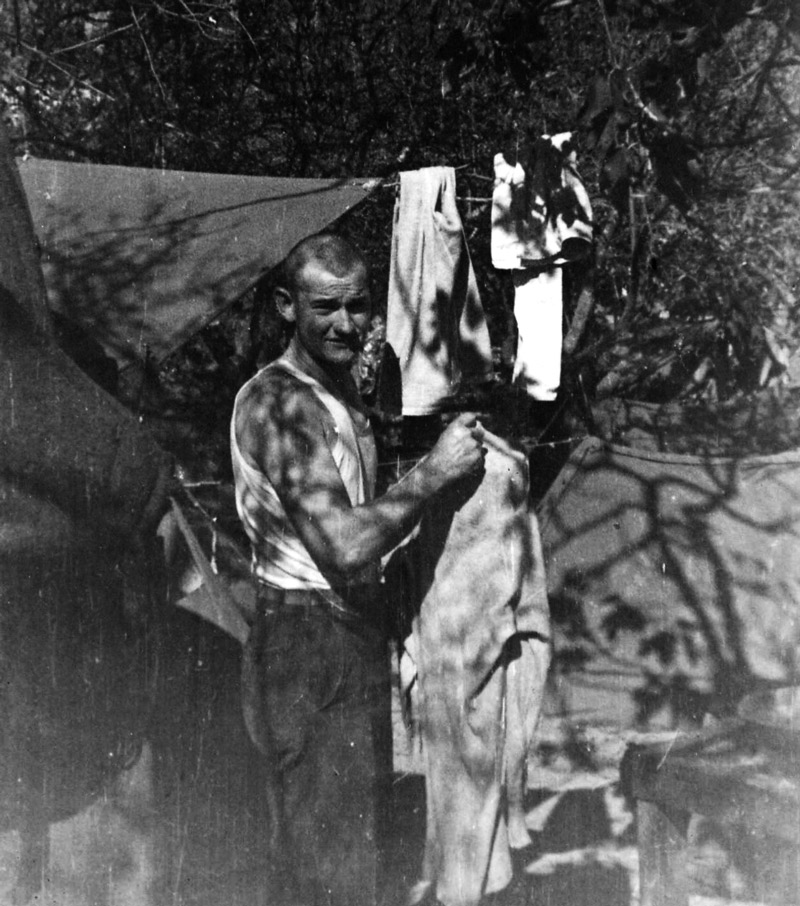
They call the camping areas bivouacs. We’d be there for maybe a day or two days or three days, but maybe while we was out here working they’d just move it on up closer to us. Under normal situations, each squad had a truck and each platoon had what we called a barracks bag and bedroll trailer. If they moved, why they’d just throw our bedding and things on the trailer. Of course get ’em that night. Some nights we didn’t even get to use ’em. These were usually company–sized bivouacs.
We engineers never had to really carry the pack on our back. Once in a while we’d just have what they called the light infantry packs. Mess gear and maybe raincoat in it. We had a cartridge belt with a canteen and different things hung on that. We didn’t have to carry as much as the infantry.
We carried those rifles. Well, it was right at arm’s length twenty–four hours a day. And cartridge belt. I carried a .45 sidearm plus a carbine, along in the latter part of North Africa. Up to that time I carried the M-1. Squad leaders have a lot of extra duties that’s pretty cumbersome to have to have a rifle hanging on your shoulder all the time. The carbine was so much lighter. The sidearm was handy, too, to have with you.
As for water, we used our steel helmets as a wash basin. We had the lister bags. There was special engineers that as troops moved forward they had the testing equipment. If they could find a source of water they’d create what they call water points. They kept our battalion notified as they moved along. They had these movable canvas tanks that they could put up just in a few, just in a little bit, and pumps. They’d treat and filter water. Took a lot of water to keep the Army going.
But we didn’t have showers or anything. That was back in World War II, and in all wars it’s pretty hard to keep sanitary conditions in good shape. Much of the time, just in the lull of things, we’d try to clean up our clothes and our equipment. But there was no puttin’ on your jammies. You just slept in your clothes and sometimes your shoes and all if the situation was that way. We never even took our shoes off.
In most of that time we wore the canvas legging, you know. The shoe and the canvas legging, and you’d never get your leggings back on if you’d take them off. We got combat boots after we got into Italy. The leather shoe with a leather top on ’em. Until then we had low-cut shoes with leggings. The boots didn’t come along till we got, oh, up past Cassino. The infantry was the first, I think the infantryman was the first that they equipped with combat boots.
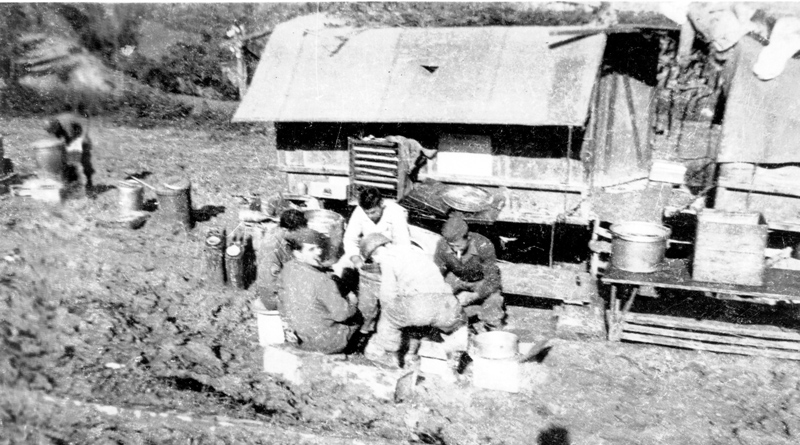
If things was normal, a lot of times for breakfast we’d have eggs, fried eggs and cereal. The kitchen force always got up around four o’clock in the morning. They’d fry up these big thermos cans of hotcakes, and sometimes they would get sausage through rations. Have hotcakes and sausage. Sometimes S.O.S. You’re familiar with the old S.O.S. I always liked it. Some guys just preached about it, but I could eat it. I liked that. Then there was situations where the supplies, they’d kinda get short and we’d just have the old C rations again. Maybe they’d just cook up boucoup cans of it and the biggest trays of hash. You got hash and just the biscuits that went with them.

It seemed like most of the time we always had plenty of coffee. They made good coffee. Great big pots, and they made good coffee. Our kitchen was a company kitchen, for one hundred fifty men. Now sometimes if the conditions was right, like a whole platoon was workin’ two or three mile up the road, and another one around the same way, they had a truck that they sent. Its basic use was to bring the supply up to the kitchen. Maybe they just put the food in these hot things and bring ’em right out on the job with us for our noontime lunch. Otherwise we’d be issued just the C rations.
After breakfast we got our orders for the day. If there was something special comin’ on the officers would get together with the company commander and maybe they’d come in to the platoon leaders and say what was the breakdown. Give you a chance to maybe break your squad down to three details or something. We were in touch with the company commander and our platoon officers all the time unless there was just something drastic happened.
Each company had what they called the motor pool. It was part of the headquarters and supply of the company. Of course the battalion had a big motor pool. The company, they had the motor pool which covered the mechanical part of it, and the supply, and the kitchen and the medics. They kind of grouped together all the time. It worked out real well.
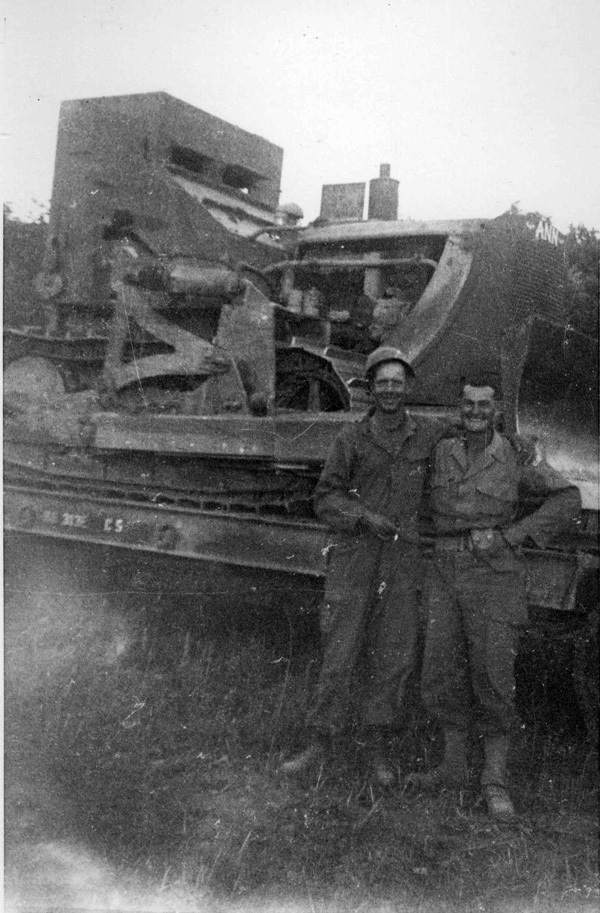
Lyle on Right
Bulldozers. Each company had, after we got overseas and in the main business of it, we had first D–7’s. That’s the big–size bulldozer. Then we got D–8’s. They was a little bit bigger and had some more modern things on ’em. We had one small R–4. It was a small gasoline cleat–track Caterpillar. They was nice to clean up with. The big ones could go on, and they could kind of clean up with the little fellers.
Basically we’d stay back just back of the artillery line. But if the situation occurred with the engineers, we floated in between the infantry and the artillery. See, it’d be the infantry and then oft times we would be in the area right behind the infantrymen’s heels, and ahead of the artillery. In other words, if they was into it pretty good. Just the heavy stuff was goin’ over the top of us. Sometimes we’d get in a conflict of interest there. We’d get too close and we’d get shelled frequently, too.
We had quite a bit of strafing in North Africa. ME 109’s, that was one of the favorite of the German Air Force and the fighter planes. They done a lot of low strafing—convoys, vehicles, jobs. There was not a great deal of point to shooting back at them. Some of the fellas got a few shots at ’em, but they’d usually come up on you so quick that by the time you got to a safe place or thought you was safe, why they’d be gone.
Your first priority was to get someplace where you wouldn’t get hit. Get away from the vehicle. The planes would use the road for a guide. They just come down through and just spray the road. If you could get like fifty yards from the road you were pretty safe. Usually you’d fall flat and hope if it hit, it didn’t get you.
We had a lot of mines in Africa. The German, after we got sort of strong enough to keep shovin’ ’em back, every time they moved back, they laid minefields. Anti–tank minefields and then anti–personnel mines to catch the infantry, engineers and whoever come along.
We got the job of clearing those mines up. The engineers. That was the engineers’ job. We had mine detectors and different equipment. Take the bayonet and probe and search for ’em. I had that detail lots of times. We had several fellas got hurt with ’em. Some of ’em had trip wires. Some of ’em was just step on ’em. You could jump up and down on what we called a German Teller mine. It was anti–vehicle. It was strictly for vehicles. It had a seventeen–pound explosive in it, and it was about this big around. About that thick. About as big as the small back wheel on a child’s bicycle. It had a handle on it. They’d just dig a hole, just enough to get ’em underground, where they could cover them over and hide ’em. It took the weight of from a jeep on up. A man could step on ’em and they wouldn’t go off.
Then they had little shoe mines. They call ’em shoe mines. Remember the old wooden chalk box that used to be dove-tailed? Can you remember the old chalk box? Well, they was just about half as tall as a chalk box. They was half a pound explosive in there and then a detonator. And the lid of it, they could put that lid up there on a notch, and if they had time they’d put them kind of level with the ground or cover ’em with grass or whatever. Just a slight pressure would push that little pin out and that thing would blow up. They was basically to blow your foot off. They figured it took too many people to take care of a wounded person, and that’s what they worked on. It was a morale buster, too. It’s pretty hard for fellas to go on and see one of his buddies get his foot blown off.
Then they had another one that we were very scared of. They was operated with trip wires, tight wires from stake to stake, about the size of a quart oil can. That was the outside canister. They’d dig it, they’d put it down flush to the ground or a little bit deeper. The inside of it was like a filter, and in the bottom of it they had a prepared charge. That canister had...we’ve actually counted ’em that we’d taken apart...two hundred fifty steel balls. That went down in there, and then three prongs stuck up, little steel wires stuck up like that. When they got ready they could set that thing, turn the thing over and put that down in there. Any pressure like a man’s weight pressing down on either one of those prongs, it’d set off a charge at the bottom of it. It’d jump off about eight feet high and go off. That’d spray.They was really designed against the infantry. They was a deadly thing. They killed a lot of guys.
Luckily we escaped. We found ’em and escaped those. We did have a few fellas get hit. I’ve got a buddy that lives in California now that stepped on a shoe mine. Took his foot off. They couldn’t get it stopped and he’s got his leg off plumb up in his hip. I haven’t heard from him for a while, but he lives in California. That mine warfare is terrible.
We worked from the time we’d get out in the morning till late in the evening or dark. We have worked all night. We’d get in, oh, maybe have to build a bypass around a big bridge or something. If it was a dry creek. In that country there are so many steep...it would be like these dry creeks in dry weather. Instead of bridging it we’d make a bypass around ’em. We’d work all night sometimes, where they could keep goin’.
The idea was to get the vehicles up to the front line. Keep that open. Keep ’em goin’. Sometimes they’d have to wait on us. They’d come up and get stopped, and it’s hard to keep up with ’em sometimes. Sometimes they’d have to wait on us till where they could just barely get over it, and then we’d let the ones that really needed to get there first and keep workin’ on ’em, you know, get ’em better and better. Different companies would get enough equipment across, or get it fixed good enough they could get their equipment across, then they’d go on to the next one, you know. Didn’t wait on each other, just a leap frog. Keep goin’. It was a whole lot like this maintenance way of railroading. You have your wrecks and things and they wanted ’em fixed just as soon as you could get it fixed. Keep goin’.
How long was our campaign? Kasserine was in February, from the evening of the 16th to about the 20th of February. Tunis fell right about the first of May. So that would be the rest of February, March and April. The first of May Tunis fell. That’s give or come a little. I can’t remember we got a bit of days off.
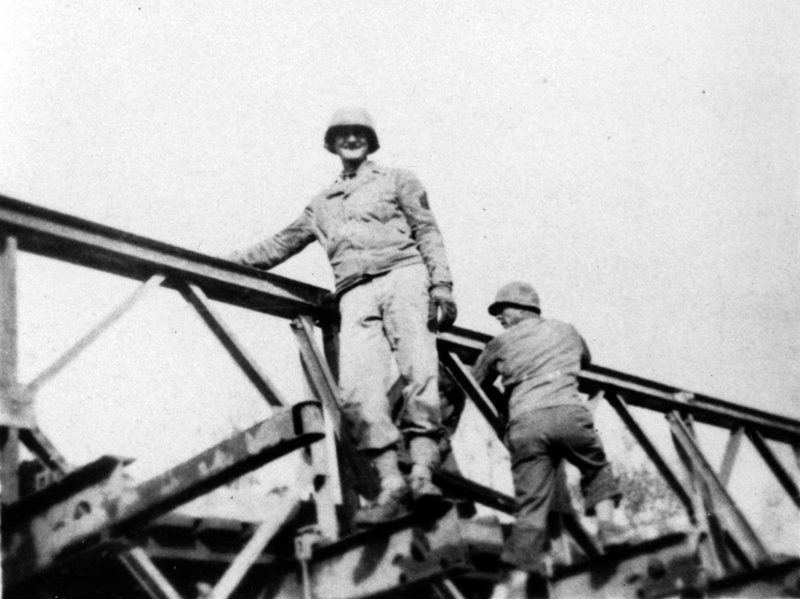
After Kasserine Pass was over and things got back to normal again and we proceeded east, the British organized a Bailey Bridge School. A Bailey Bridge was designed by a British engineer. It turned out to be a very famous bridge during the whole rest of the war. It was like an erector set, all steel and went together with parts and clamps and pins. The bridge could be laid out and constructed in a few hours or dismantled in a few hours, and moved on ahead as more permanent replacements. I had the honor that General Alexander visited the school while we were in that class, and I was within arm’s length of him.
General Harold Alexander. He was a large man and very, very common, and talked to us like, I should say like our dad. I’ll never forget it. I was certainly glad to see him. I’d been close to General Montgomery, but not that close.
As we moved east, of course there was the last battles for Tunis, the City of Tunis itself and for Bizerte. They were rough battles, but we didn’t take part in the fighting as we did in Kasserine. There was more of the artillery, air force and infantry battle up there. Of course we were close behind doing roadwork and our assigned duties. But we weren’t engaged as infantry in that battle.
Once the battles were over, we were detailed to build prisoner of war cages—wooden post, barbed wire—up near Bizerte. As we went toward the coast, we’d kind of shuffled off going sort of north–northeast, and we ended up around Bizerte. When the fighting was over and the Germans surrendered, there was so many prisoners coming in by the truckload that they come and said, “Boys, stop building fences. They don’t want to get away anyway.” So we just quit building and they just threw their belongings out and just camped out till they was taken care of. We couldn’t have built enough fences to accommodate all of them, and they were done anyway. Many of them told us that they were glad it was over, and they wanted to go back home.
They moved the prisoners out of North Africa as far as I know, but I don’t know where they did take them. I think they sent a lot of ’em to the States, down in especially the southern camps. This cousin of mine that was a cook in the Air Force said that they had several prisoners of war in part of their camp. They quartered with ’em. I don’t know what they did with all those prisoners. We heard a figure of 275,000 altogether, that’s total Tunis, Bizerte, the North Africa campaign.
6—Sicily and the italian campaign
Our next assignment was Sicily, and it took I’d say around three weeks’ time to get reorganized, equipment up to required number and replacements of men and get everything in shape to go again. We went from Tunis over to Sicily by LST. I’ve looked on the map, and it’s ninety miles from Tunis over to...we landed at Gela, Sicily.
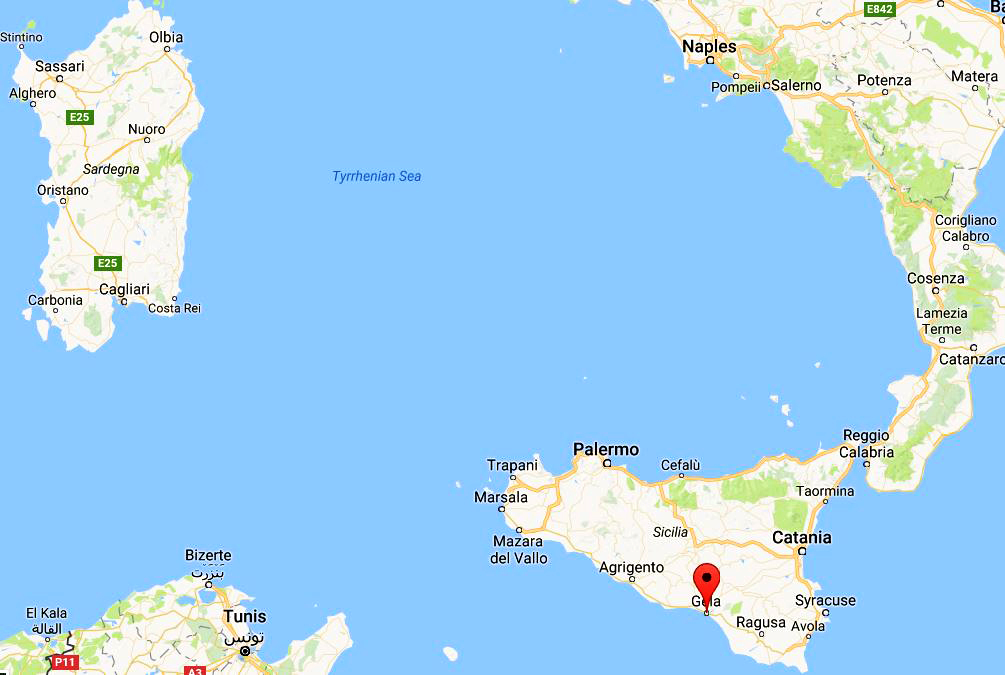
Courtesy of Google Maps
They had secured the shore the night before we got there, and we got there in the early morning, after daylight. For us it was a calm landing. They headed the LST’s right up to the beach and dropped the gates and we unloaded right off before the next day. We unloaded just off into the sand. A few of us got our feet wet tryin’ to get the trucks and things off.
We went about a mile inland, and secured the area along there. From there my group stayed in the center of Sicily, going up toward Mt. Etna. The volcano is roughly the center of Sicily, and it’s all upgrade, mountainous. Sicily is a very mountainous island.
As far as I can remember we were still with the First Armored. The British forces under General Montgomery, they went up the east coast of Sicily. General Patton, his forces landed along about the same place we did there, and they swung west toward Palermo. It’s on the western edge, tip of Sicily. We were still under General Clark. Patton was our overall commander, but we was under subcommanders. Mark Clark. He was our commander up through Italy.
Sicily was a short campaign. I think the whole thing was over within a month’s time. I can’t just pinpoint the number of days that it took us, but I think within a month the whole island of Sicily was under the U.S. and British forces. They took the island.
Up around Mt. Etna, the volcano, it hadn’t erupted for quite a number of years, and I remember we could see the smoke coming out of it. When we got up near there, it erupted. It sent this lava down on the west, in the direction of the west coast, and we used our heavy equipment to help divert the lava from going down through the town of Randazzo. This lava burnt its way down, and it did get into just the edge of this town and destroyed a few buildings. But it didn’t destroy the city. It was one of these mountain towns, and we followed up mostly clearing the roads.
The Germans blew every bridge down. Of course in the summertime it was dry, not much water. They had to truck water to us and instead of bridging we built bypasses in Sicily. We would take our bulldozers and make bypasses for vehicles and troops to get around where they’d blow the bridges down. They did have some high bridges and they was all stone. Everything over there is stone construction, and they’d just blow ’em down. Instead of bridging we would build bypasses around ’em.
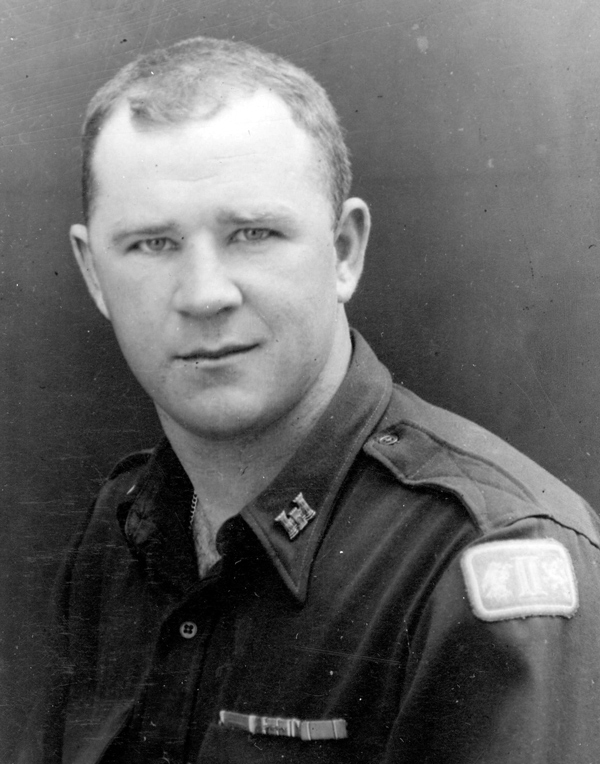
The Germans did quite a bit of mine warfare. They laid mines. We had to sweep about all the roads as we went along. We swept up and checked for mines, mostly Teller mines. I’d been promoted to Staff Sergeant. From Buck Sergeant to Staff Sergeant. I had responsibility for a platoon of men under First Lieutenant Berry.
We didn’t know about those things, of course, but the Allies were looking ahead about those amphibious landings that they was gonna make in Italy. So after we got going good in Sicily, they sent Lieutenant Berry and a big part of the lieutenants out of the 19th Engineers all the way to Oran to help load and organize these coastal landings that they was gonna land. That threw the responsibility of the platoons mostly on the staff sergeants under the company commander.

Our company commander was Captain Ed Pohlmann. He was a captain and a very, very good company commander. We worked with him hand in hand and got along just fine. Most of our responsibility was to maintain roads and sweep roads to keep supplies at the front. Infantry, artillery, keep all kinds of supplies—fuel, rations, everything they needed. We didn’t really have any engagements personally with the infantry or with the Germans. We were kept back of the infantry, and they did the job there.
The Allies seemed to have air superiority—the American and the British Air Forces. We saw dogfights and strafing, but it was a hit and run thing. It was just maybe three or four come through and do their job and take right on off. Mostly they used North Africa fields, especially with their big bombers. Down on this landing part of Sicily, on the Mediterranean coast, they did have two or three landing strips where the fighter planes can land. They didn’t take such a long strip. But the big boys they come high, and as far as I can remember they did very little bombing. They went on up across Italy and up in toward Austria. They were high, but we could see ’em, formations going over and coming back.
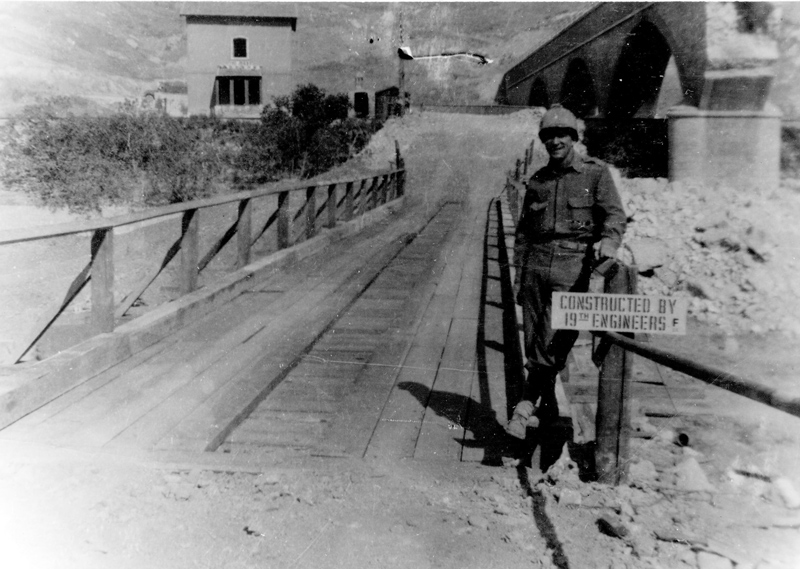
We captured a good many of the Germans, but they got their main force across the Strait of Messina before we could get ’em hemmed in to where they could keep ’em from crossing. They held up a pretty stiff resistance, and at that time a lot of their troops were getting across the Strait of Messina, over into Italy. We ended up at Messina.
Then it was just the old Army game hurry up and wait. You really wasn’t doing anything a lot of the time, but oh just like your guard duty and camp duty, but you couldn’t leave because we was under alert. Of course we was resting and gettin’ ourselves cleaned up after the campaign, but we couldn’t go any place. No leave time. They wanted you to be ready at a moment’s notice if it was our turn to get loaded and go, so you know we just had to stay right close—played cards and shot a little dice.
The British, they got their people there, and they ferried us across in barges that was big enough to accommodate two or three trucks and all the guys that went with them. They ferried us across the Strait of Messina after the Germans.
Once our outfit got across, why they just lined us up as we crossed and just when the last leg come over, why we started right up toward Naples. I’d say from about noon, we convoyed just right straight toward Naples and got up just south of Naples when it got dark and they run us into a bivouac area, they called it. You know what a bivouac is, just a place where you could pull off and park and get out of the way, and we stayed there overnight.
I think I’m safe a sayin’ there were no Germans south of Naples. Because we just drove fast in gettin’ up there, and before morning we wished we’d either went on and hadn’t got up there. The German Air Force bombed the harbor of Naples, and we was just like Naples was downtown and we was right out here, and planes went over us all night, and we didn’t get a bit of rest. We could hear those bombs a goin’ off, what they was after was what ships was left in the Naples harbor, and the docks. They really did give ’em a pulverizin’. They sunk ships down there, big ships layin’ on their sides, just the mast and the top deck showing. I’d say that probably a lot of ’em was Italian ships. Maybe a few French ships that they had taken over.
Mussolini was still in charge in Italy at this time. I think he was still in power. I’m sure he was still in power, because it was a long way to Rome. The Italians, they had given up. When we were in the last days of Sicily, why the news came to us that the Italian army had given up. They collapsed, and of course it took some time, but what was left of the Italian army, what the Germans didn’t make go with ’em, and they got away, why they did detail work for the U.S. and the British armies.
One thing they did, they took charge of some of these mule trains, like when we got up around Cassino. When we got into really the mountainous country, they took care of and operated these pack mule trains. Carried supplies up there, infantry and like mortar ammunition, ammunition, small arms, food, signal wire, signal corps material.
As I go along I mustn’t forget that the Signal Corps all along the line played a very important part. Every place that we went the Signal Corps also went. One unit of the Signal Corps that I distinctly remember was the 53rd Signal. You might make a note of that if you want to, Bill. The 53rd Signal Battalion. Those old boys, they had a tremendous job. They used like this two–strand, cable telephone wire that used to come into your houses. You know that type of wire, on reels. They kept that on reels right along with us for communications. We had some radio communications, and it got better as we went along, but the main thing was the Signal Corps kept the communications going.
They strung the wire toward the front all the time. From command post they’d just keep following the command post right up. When we got in Italy, the Third Division showed up. I can’t remember what Army they was with, but I reckon they took them in part of the Fifth Army. Third Division had the blue shield with the white stripes. It was an infantry division. Third Division. I remember their Signal Corps pitched in and helped II Corps then, with signals. That was a big job keepin’ the communications. Communications is very important to the whole shebang, you might say.
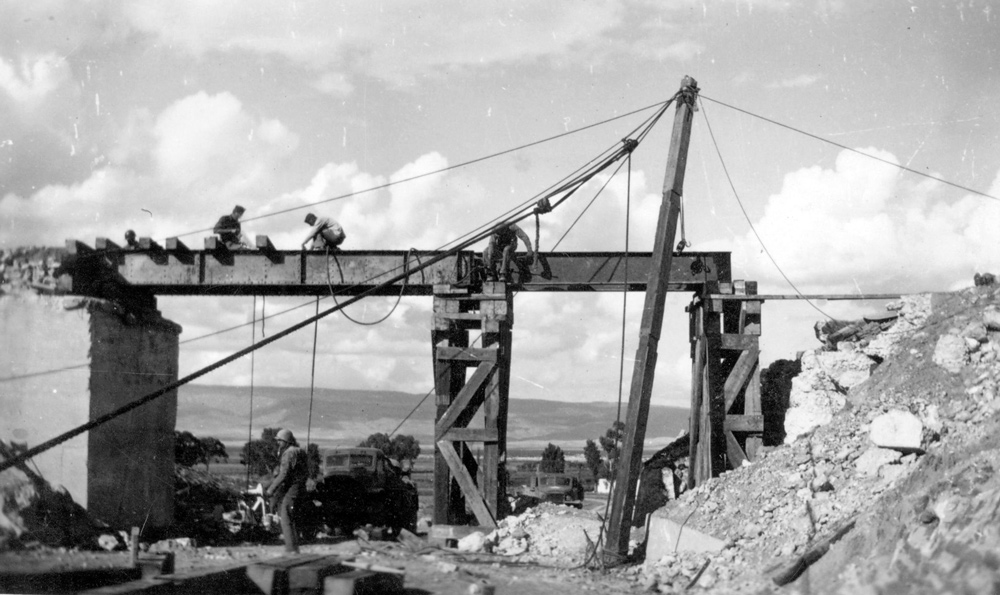


So the next morning we broke bivouac and went right on up to north of Naples to the main town. There was little towns along, but not as important. We went to Caserta. Caserta, Italy was a fine little town. As it happened, that was where the King of Italy had his winter palace, at Caserta. In the wintertime he’d move from Rome down there because it was warmer down there, they claim. We were around there for a spell of time and then we moved on up to right in the Monte Cassino area. South of Rome.
We were held up there all winter. ’43-’44. We were held up there. Winter set in. Rain. Rained and rained and rained—just a cold, drizzly, hard, hard and drizzly, enough to just soak the whole country up there that winter. All the streams and rivers were bank full and the earth got soaked. Heavy equipment just couldn’t hardly, like the tanks and trucks and things, couldn’t leave the roads. A lot of the roads wasn’t built for army traffic and they went to pieces. Bridges washed out. Of course there was bombings and shellings. Sometimes a direct hit with a five hundred pound bomb would just knock out a whole section of a road, and we’d have to get that filled in some way. We even went to cuttin’ timber and makin’ corduroy roads, kind of a corduroy roads just layin’ poles—cuttin’ poles and layin’ ’em crosswise, right close together. We used a heavy wire wound to secure them in the places we couldn’t get anything in there enough solid to hold up. I mean just no bottom to it, you might say. We got right up to the base of Monte Cassino, and we was at a standstill there for I’d say for at least two months. Two or three months.
The war action during that period of time was artillery barrages from both sides. One side shootin’ at the other side. Maybe you’d have a few hours that neither side would fire a shot and then it would start up again. They done a lot of shooting at night. I don’t know how much damage we did, but when we got up there all the small towns and villages was pretty well pulverized from the shellings. Those towns really took a beating.
The Germans was on the other side, well they’d shoot back and we’d shoot at them. That made each town gettin’ about two workin’s over with artillery. You know, the long and the short shells, and we destroyed ’em. Terribly. I’m sure the civilians took a lot of casualties. Neither army really was quick to take care of ’em and really didn’t want them. If they could get back through our lines or get back of the Germans and we wouldn’t bother ’em and they’d go. I reckon they stayed with their own people someplace. But we run into pockets that they stayed right in.
There was a common sight. Here’s another one. Those British boys are probin’, searchin’ for mines.
I think I was telling you that the civilian population, they’d stay right in their homes. They really hated to leave, and they’d stay right in their homes until they got a direct hit or something like that. So a lot of ’em, the war passed ’em on, and they stayed right up in the mountains. Stayed there. Course if we come along, we were friendly to ’em, and they’d come down and talk to us. The Red Cross would try to get ’em and the Italian civilian people would try to get ’em necessities of life —food and if they needed something to help ’em out.
We were able to keep the main routes open, so I think I’m safe in sayin’ that our army was well supplied most of the time. Oh, maybe once in a while it got a little bit low, but, Bill, we always had emergency rations. It seems as though they had plenty of gasoline, and I think everybody got supplied pretty good.
Naples had a good port there. They salvaged part of it and got some of the stuff out of the way. They begin to unload stuff there at once, just as fast as they could. Then they moved on up over on the coast of Leghorn, up in the east coast of Italy. Up at Leghorn and on up at, where the leaning tower of Pisa is, up in that country, they started getting supplies unloaded up there, trucking over.
That was one main reason that they had this landing at Anzio and the other one up there...to shorten supply lines for the ships. Instead of having to truck all that so far, they could unload it there. Of course they unloaded troops, too. The Germans was in control of the coast, and they had to you might say punch a hole in ’em with the troops before they could get landings and unload their supplies.
The Italian prisoners helped, especially down in the Cassino area where it was so mountainous. They helped a lot, takin’ care of the mule trains. Of course they had enough American supervision to be with ’em, but it relieved ’em from havin’ a lot of what would be infantrymen or engineers havin’ to work with the mule trains. Gettin’ suppies to ’em.
There was a dispute during the war about Monte Cassino. It was just sort of a guessing game. We honestly believed that the Germans had observers...if not many troops they had observers up there in the monastery and all the associated buildings and even in dugout emplacements. Because that monastery was built on this high ridge that just dropped off abruptly right into the Liri Valley. They could see for miles down that valley, and that was the main course that the American Army and the British were coming up through there. On each side was some mountains.
We were sure that they could see every move we made. We had what they called gas companies. With their equipment, they could create so much smoke, as we got closer, they’d get on with the wind and they’d put up smokescreens. Then they could see down in the direction, but they couldn’t see exactly what was going on. Like we was gonna bring in a division or armor or something like that, why they’d put up a big smokescreen through the daytime, and they couldn’t exactly see what was going on.
Of course they moved a lot of equipment at night. We’d get a lot of our work at night. We were sure that they had observation over a big territory there.
The Air Force finally did bomb the place. The weather kinda broke and we had a series of clear days. We’d see planes, these bombers comin’. They’d make big circles around in that area, and they’d go back. You know the GI’s, they would bet on anything. So they’d see the planes a comin’, “Well, I’ll bet you (so much) that they bomb her today.” And, “I’ll take that bet", you know. Golly, on this one day, why they come over and they bombed her. They give her an awful workin’ over.
We was just like well, from here and the Abbey was over there on those high hills. We could see every plane had dropped his load. We was kinda up on the side of mountain like, on a road there, and they really tore the monastery down. After it was over you could see like, like every place that’s destroyed, you can always see parts of it. But they really destroyed it.
Everybody was hollerin’ like a football game, you know. Really for a little bit we thought maybe the war was over, but it was a long shot from that. Well, actually, they still claim that they didn’t have troops in there. But I’ll always think that they had observers up there. ’Cause the road junctions down in that valley...there were so many, especially where a road would cross this main road up the valley, goin’ toward Cassino and these roads that went off. Why, just every day there was convoys or trucks got at that certain point and there’d be artillery fall on them. They knocked a lot of trucks out, and vehicles right there. Of course, they’d always pick something for their reference point. They’d be watching, connected with phones, and like artillery. I’ll always think that there was spotters up there.
They sent the Texas 36th Division up there under cover of night. They made a drive on the Rapido River, and we was connected with that. Our main mission was to select crossing points for foot bridges first. Your infantry foot bridge. This was a river crossing. The Rapido River. They moved their infantry and artillery up there under cover of darkness, and they had a tremendous amount of artillery in that semi-circle of Cassino, Monte Cassino and it was right along the Rapido River there. That was a natural barrier for the Germans. That river was. It was a deep, swift mountain river.
That type of a river is awful hard to cross. Even in the daylight and with good boats it’s hard to cross. All this rain and the snow up in the mountains, and it was beginning to get warm enough, having it bank full and it was really swift. We never see a river around here as swift as those mountain rivers are. Our main objective was to get foot bridges across for the infantry. Then if they could get established beachhead and get control a little bit, why then we’d put light pontoons across and then work up to heavier. Well, they had their coordinated artillery pinpointed so good that they shot them footbridges off just as fast as we could build ’em.
To build the footbridge you put guy lines on the front of it, and it’s built from the bank. You put a section in, like a ten foot section in and you shove out. You put another section in and you shove out. As it goes along there’s handrails going from each section. On each there’s a rope that goes off, and then you keep putting these guylines. Fellas keep leaving slack and keep shoving the bridge out till it reaches the far side. Somebody will ride that front end, a couple guys will. Then they’ll secure it to a tree or anything they can find over there to anchor. See, you have these lines on it to keep the current from taking it down, but you always have twin lines ever’ so far. Once you get it across and then you secure it and they start going across it
.We couldn’t get it secured. They just shot them things, they just shot ’em in two as fast as we could get ’em, and they used mostly mortars for that. The infantry had their mortars up on them hillsides and just dropped them mortars. See, they knew that they was gonna make a stand there. It was a perfect natural defense line. It was very hard to crack on the invading side. Of course we had to do all the movement. Just like shooting ducks in a barrel. The 36th infantry, they lost a tremendous amount of men there. Then they tried to just go across in these pontoon boats, and that current just took ’em down. They’d find ’em upset for miles down through there after it was over with, upset and guys gone. Got a lot of guys. They took an awful beating.
We had our heavy pontoons loaded on the trucks back in the staging area. When they called it, they give up on tryin’ to do it, oh, I would say a good half of ’em was shrapnel. They kept shooting aerial bursts over the whole area. Shrapnel had practically all those pontoons punctured. You know it would just tear a hole through ’em and they was inflated with air. They just ruined them.
That’s when they went over on the coast and made the Anzio landing. Made an end run, and then when they did that, right at the precise moment, why they sent troops up the coast and went around. That was the end run from our side, up on the Cassino front, made an end run around and got in behind ’em. Anzio was on the west coast of Italy.
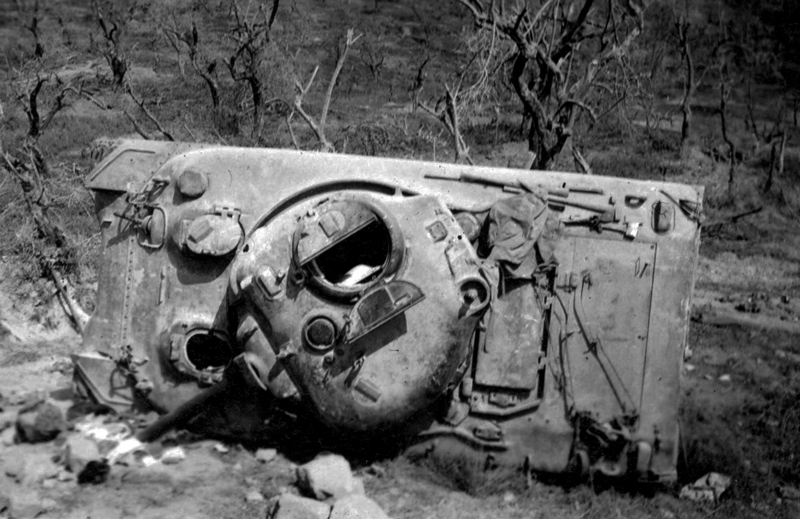
The British army was workin’ its way up through the mountains on the east side. They was havin’ a tough time over there, too, because of the terrain—deep valleys, you know, and just one valley right after another. It just seemed like that all led in a certain direction, but it was just one right after another one. Terrible tough goin’. But they made that end run around and got in behind ’em. That’s how they got ’em out of Cassino.
We were down there on the front until that was over, and then we finally got the roads opened up on toward the direction of Rome after that. They had to pull their troops back to keep ’em from gettin’ encircled. The German army pulled their troops back, and we got up through Cassino.
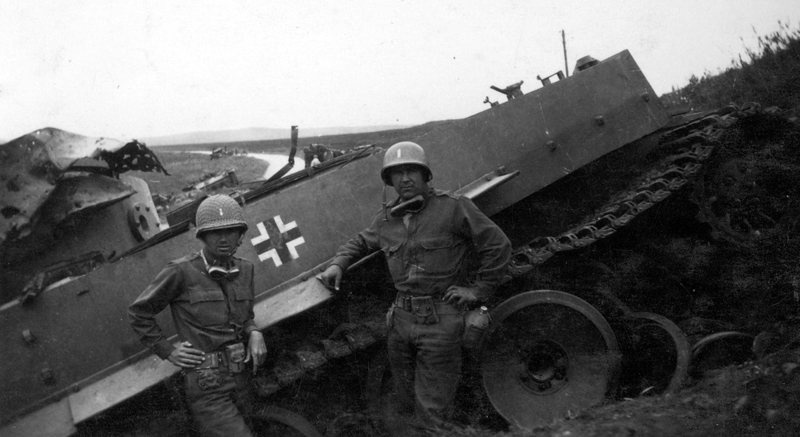
Lt Berry on Right
We didn’t go on the Anzio landing. I believe they brought the 45th Division from the States, but they might have stopped some place on the North Africa coast. Just waited until it was prime time for ’em to come across and land. That’s what got ’em out of Cassino. That Anzio landing. Then we proceeded on toward Rome.
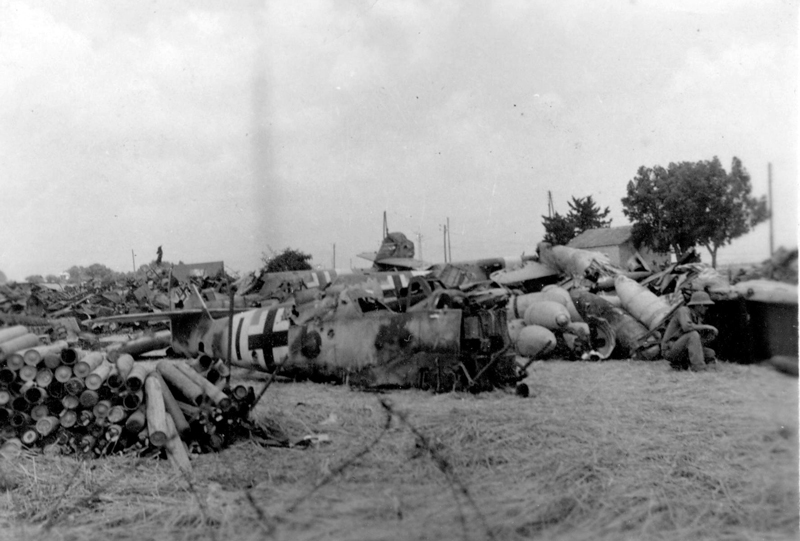
We got up south of Rome, and I was detailed to have a mine detecting crew on the road that led right direct to Rome. South of Rome, and we was up there at daylight. We started up on the...what is this famous highway of the Romans? Appian Way. Okay. We was goin’ up the Appian Way, which had been really worked over and it was a nice blacktop road, and we was sweeping on each side and we’d just gone about a half a mile and we saw tanks sitting up there. A bunch of guys up on the top...it was real early in the morning and we couldn’t tell if it was our tank or exactly whose tank it was. So we cautiously got up there, and we finally decided it was one of our tanks or a British tank. We got up there and it was a British tank. The crew was up on the top and they had their radio goin’ and they had their aerial run way up on it. They was listenin’ to...it was June 6, 1944.
They were listening that they were landing, that they were goin’ across the channel that morning. I’ll never forget that. They were really celebrating. They was really happy boys. They were celebrating, and they just shut it off and settin’ there listenin’ to the news. Of course the road hadn’t been swept on into Rome. It was just about, I’ll say like four mile on into Rome. Just flat road right on up to south of Rome.
We mine–swept blacktop road. They would go along and dig. They would dig in just any material. Now in this case they didn’t, but like in the Tunis area, we’d found places right in the blacktop roads where they’d dig just enough to put those anti–tank mines in. They just dig it about that deep and set ’em down in there, and then they’d take that material and camouflage it all over good, hoping that they’d get a few tanks. So we couldn’t run a chance. For safety reasons, we’d sweep ’em.
We visited there with the British boys a little while. Then we went on and done our business toward Rome. We got up to the edge of town just that evening, and our company commander come and stopped us. See, they declared Rome an open city. Neither side, the American, British or German were to bomb or with artillery bomb the city. Declared it an open city, so they stopped us. About noon the next day our part got permission to go on up through the main street, north and south. That went through Rome north and south. We went right through Rome to the northern edge of it, and went into an area there and stopped.
It was, Bill, it was like some of these pictures just seen about down in South Africa where this man had been released from prison after twenty–seven years. All those people, they was crowded in the cities. Ever’ way you’d look so tight that the vehicles could hardly get through. We had to keep just goin’ real slow and they was just wavin’ flags and yelling and throwin’ booze. You know, pitchin’ wine. Just had a whole bottle of wine, just throwin’ it on us like that. Like Super Bowl. Up on the balconies they’d be a hollerin’ and a wavin’ flags. It was really something.
When we got up to the edge of the city we quit sweeping. There was enough city traffic and things that if there’d been any, they’d have set ’em off. I think we were right at the head of the main force. They’d want to touch us. They’d reach over and want to...I was riding in the back of a jeep, and they’d just crowd in and they’d want to touch you and hold your hand and you know just touch you. Well, they was really celebrating.
We got to stay around there in Rome four or five days until they decided what they was gonna do with us. They gave us passes for so many hours, and then we had to come back and let other guys go in. About four hours at a time, which wasn’t very long. Of course it was good, but on foot you couldn’t get around very far because you’d have to figure on getting back, you know. But we got to see a good bit of it. Got to walk around the amphitheater, the old Roman amphitheater.
Later, we got up in northern Italy toward Florence and things got established until they started givin’ five–day rest leaves. It went on, older guys and longer service, I mean replacements didn’t get to leave until the regulars, you know, just like taking your turn. So I got to go back for five days’ rest leave at Rome. Things were settled down to normal then. It was just like goin’ to Columbus. They had their street cars goin’. Horse-drawn carriages. Cars.
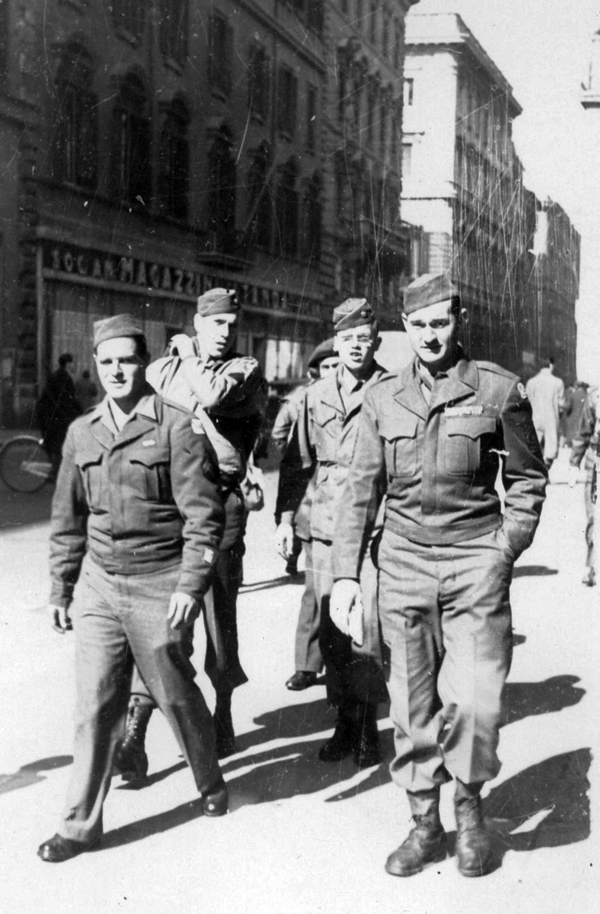
The Army took over hotels. They call it billeting us. We were billeted in certain hotels. I didn’t know it, maybe you did or have read about it. The Olympic games were scheduled to be held in Italy, in Rome before the war, sometime before the war. While Mussolini was in power, he built this huge amphitheater and place especially for the Olympics. The U.S. Army took that over. They made that part of a rest camp. They had these hotels around it. They had barbershops, restaurants, Olympic-size swimming pool, and, oh, tennis courts. Just about anything that you’d want like that.
We were mainly interested, when we first got there, in the barbershops. They were fantastic. They had a row of barber chairs from here over to the restaurant. These Italian barbers...we’d walk in and just say the whole works, you know. Boy, we’d get a haircut, shampoo, shave, tonic, everything. Massage. And they were experts. You know the Italians are quite barbers. Boy, that was really something.
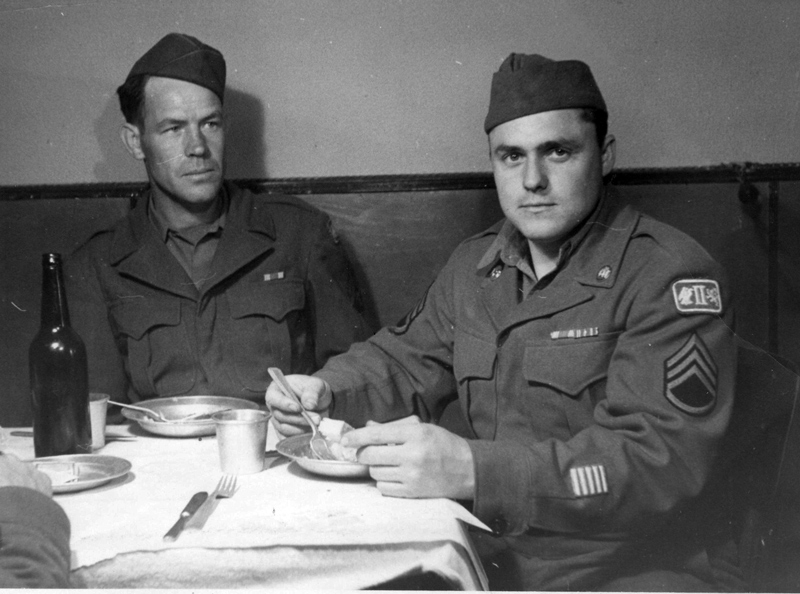
We ate spaghetti and meatballs. The Army had their regular old chow, too, set up there, so you could eat any time of the day. Any time you come in you could go and eat. We slept for two or three days. You know, living with the Army in the field, you don’t keep very clean, because you don’t have the facilities. Like coming up through past Cassino and there, why we didn’t change clothes for weeks. We were terrible lookin’, but ever’body looked the same and smelled the same, so it didn’t make any difference. We’d heat water in the C ration can under our helmet and that black smoke would get on us and make us that much blacker. We looked like colored troops.
We next moved right in the direction of Florence. Florence is the second largest city in Italy or something like that. It’s a beautiful, beautiful town. Now I’m not sure that they declared it an open city, but there was very little bit of destruction there. And, Bill, the churches and those type of buildings were really to me prettier than down in Rome. Rome was built under the Romans and Florence seemed to be what would you call it, architect, the heavy huge steeples on the churches and things. I think I wrote Wilma, after I could write a little more, what a pretty city Florence was.
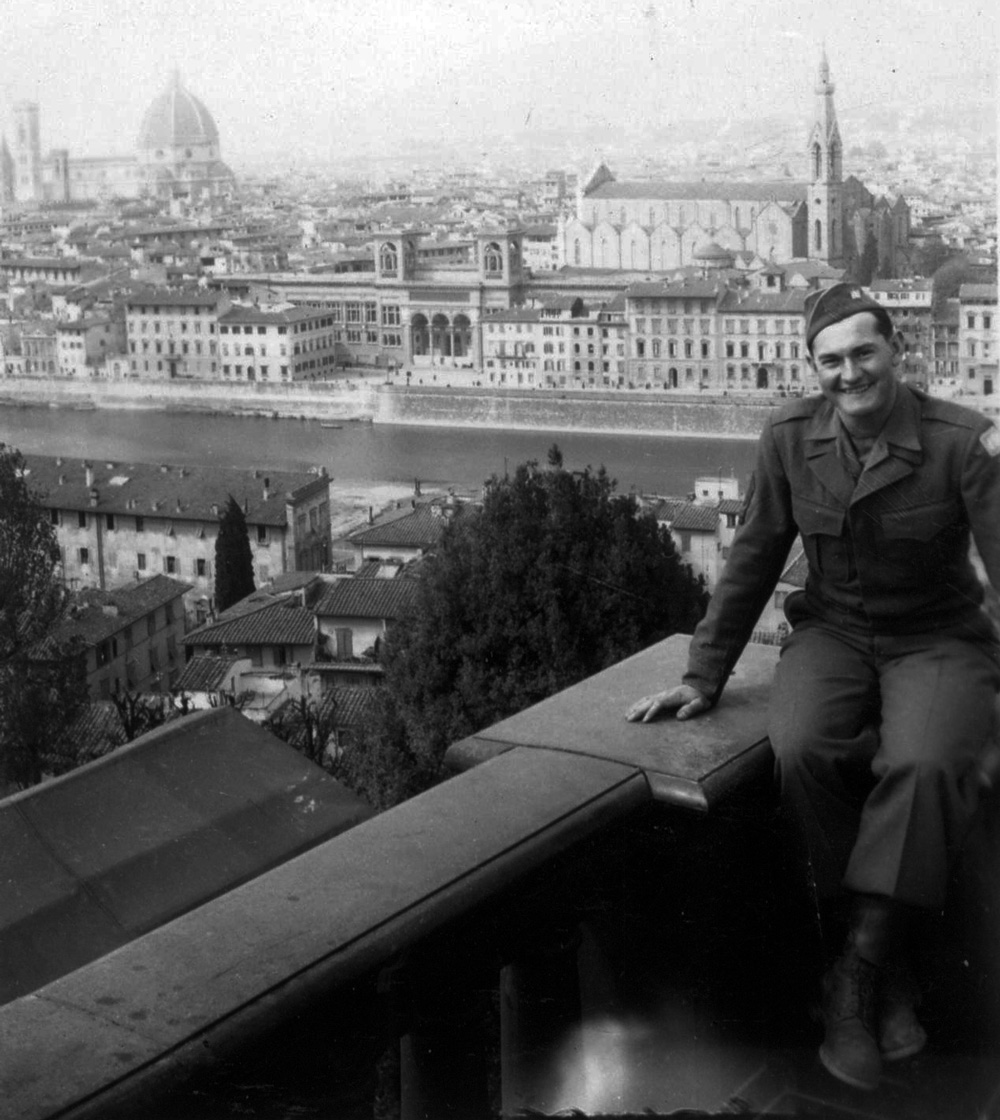
I can’t remember much opposition between Rome and Florence. We were in the Fifth Army under Mark Clark. He got us to attend a ceremony where his son was graduated from West Point and commissioned a second lieutenant, him and one other general come back with him, Bradley. Their sons were graduated at the same class and were commissioned out of West Point.
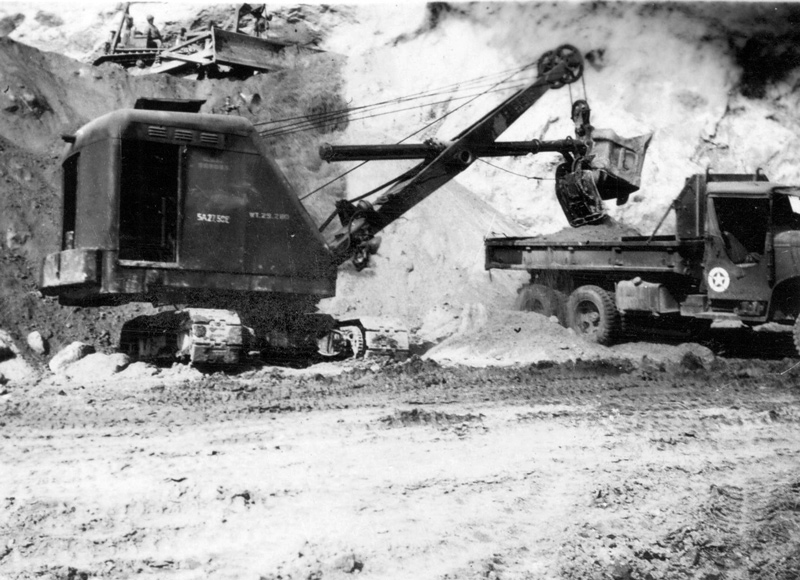
We didn’t linger at Florence much at all. We went on north of Florence on regular roadwork, bridge repair, mine clearing, and just normal following the infantry and the Army up through there. They make pretty good progress up through there. Let’s see, that was still in, Rome was June 6th, wasn’t it? Well, we got on up north of Florence and we was gettin’ into more mountainous country all the time as we went, as we proceeded toward the Po River. When Fall set in and winter, we started getting snow. We were getting more like toward the town of Bologna. Good old Baloney. We got up on the Bologna front. Winter set in. The snows got so deep and the infantry dug in, and from, oh, I reckon from first of November till March, why we were just more or less dug in and permanent stayed still.
Of course the battle line was stretched across the mountains, you know. The mountain ranges and where the infantry was, and the artillery back a little farther, and we were just behind the artillery a little ways. We had more or less just a routine. It kept snowing and the snow kept getting deeper and deeper and deeper.
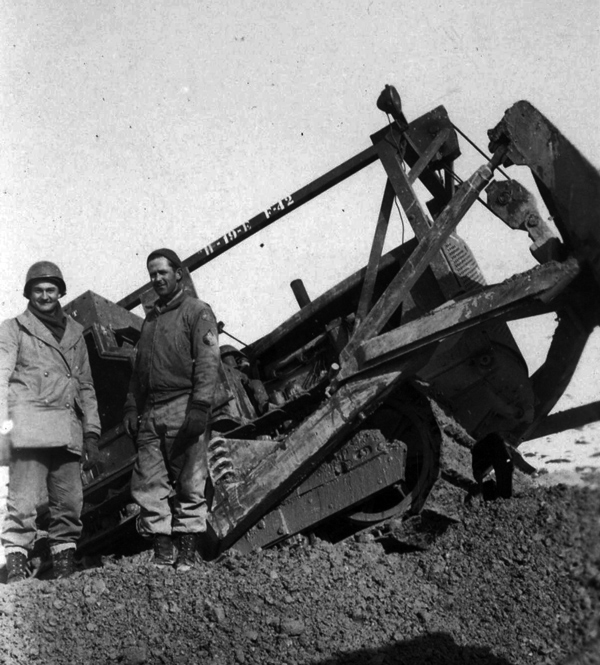
One of our jobs was, we had a several mile stretch of Highway 65 goin’ north of, parallel with the country of Italy. Goin’ up...see we was inland, about the middle of Italy there, and goin’ up through there. We used our bulldozers and road graders and everything to keep the roads clear. Around the clock we drug and scraped the roads. Every mile we made a pulloff place by a pyramidal tent, which had a stove, rations and water and some extra fuel in it. A mile apart all the way up through there.
We had details, assigned details on duty eight hours, off sixteen. The purpose of these convoys goin’ up to supply the infantry and the artillery and all the troops that was up in there. If one of ’em would have a breakdown, like between between this snowpost (we called ’em a snowpost) and this snowpost, well if they was halfway, they’d just have a half mile to walk one way or the other to get into the shelter and water and fuel there and rations. So we did that around the clock about all winter. That was one of our jobs.

Outside of that we just did the regular maintenance work. We were just mostly locked in with winter till Spring come. The troops didn’t move very much. During that time, the Battle of the Bulge was mounting up and finally took place. Of course the Germans had a line of defense up there, too. We had orders to drop back and take our equipment and make secondary gun emplacements and rough fortifications in case the Germans might have some ideas about makin’ a drive on us back down. Reverse and try to come back down through Italy. They frequently shelled, but we were lucky in my area. They didn’t do any damage to amount to anything. They never made that last drive on us.
When Spring broke loose, the snow started amoving, why they begin to make their last drive for we was on what they call the Bologna front. The City of Bologna was right straight in a direct line ahead of us. Troops on each side of us. Well, when the weather cleared and it got to be Spring again, why everything was on the move.
After a huge bombardment of every gun up in there why the infantry and the armor all took off for that final drive in Italy. We got them out of the mountains, back up on the Bologna Front. We was right on their heels. Of course down in the plains it went right through the edge of Bologna. All we could see was just houses and buildings. Nobody ever set a foot into Bologna. So we went right on.
We went down and ended up at the Po River. About all the Germans, through the year and months before that, there was quite a lot of activity. Neither side would let the other side do much. I’m sure we bombed the bridge across the Po to keep the Germans from comin’ down in with their supplies. They bombed it to keep it the other way.
So we got down there. I should say that as far as I’m concerned, after they got the Germans routed out of the fortifications, got ’em on the run, why it was just kind of a one–sided ballgame. We were just taking prisoners. We caught up with ’em, and they were marchin’ down the roads by companies. They’d completely given up.
We got down to the Po River, they was Germans everyplace. It looked like thousands of ’em. Their equipment, what was left of it, was sitting there running. Some of the tanks and trucks, they never even shut ’em off. The engineers right at once in the meantime started to building a huge pontoon, floating pontoon bridge across the Po River. As I remember the Po River was as big as the Ohio River is down at Gallipolis. So that’s quite a stretch of water to cross with a pontoon. But the engineers did it, and they crossed, we crossed there.
They ferried the infantry across. Some way the Navy...like these fast boats, speed boats of the Navy. I think they hauled ’em in there on lowboys some way. They appeared on there, and they carried a lot of ’em across. They used a lot of our pontoon boats, like the raft boats, to get ’em across, just to make the bridgeheads. Once we got across we went up to the town of Verona —Verona, Italy. Across the Po River.
When we dropped down in the valley, the Germans even left their horses. They had a lot of horses and wagons. Guys delighted in gettin’ a team of horses and gettin’ up and settin’ on the seat and drivin’ that wagon down the road. It was sort of like a field day, you know. The Germans were on the run.
Through engineer headquarters, why they had this rotation thing going. Within the last year that we were over there, they had this rotation plan going. It was all based on your length of overseas service, and your time, what you was doing and your rating, and everything had a little bit to do with it. My name had come up for a rotation, so I got my orders and I returned back toward the States from Verona, Italy.
I don’t remember just exactly the date, but I do know I got back to Miami, Florida on my birthday, May the 8th. So you might take fifteen days off of that. Of course it took several days. From my regiment, by the time we got the other companies there was two truckloads of us. We come back by truck over back across the river, the Po River, and went over to Leghorn, I believe it was. Leghorn is close to Pisa, where the leaning tower is. Did you see the leaning tower?
I believe the Port of Leghorn, they loaded us on an Italian ship. They had a rope stretched down the depth of it. Us soldiers was on one side of the rope and on the other side was full of German prisoners. We come down along the coastline, all the way down to Naples, on that Italian ship. They unloaded us there, and then we went into a replacement depot and got our orders to come...more orders, in groups. A certain group, it was goin’ a certain place.
All of us put in this huge building and we were filling out papers. It said maybe one or two percent might get to go home by plane. If you prefer that, check by plane. How you want to come home. Ship or plane. So we nudged each other and said let’s check by plane, not dreaming that we’d ever get to come home in a plane. That was in the evening.
The next morning, after breakfast, a guy come down through there yelling my name and I went out to see what they was gonna do with me now. He said you’re gonna go home by plane. They told me to get ready real quick, and there was about a dozen other guys that had the same thing had happened.
They took us down to where the planes landed at Naples. An old junker, one of them C-147’s landed that they used to haul freight with. That thing landed up there and it threw the ladder down, and we climbed up in the back of it. The pilot and another guy had their heads hung out the window, and they was laughin’, you know, and hollerin’ at us, you know. They never shut the thing off. When we got up in there, they slammed the door shut and back in there there wasn’t a seat or a thing. Just along the sides where they had everything stripped out of it, and whirled and around and took off. We was holdin’ onto anything we could hang onto. I think that’s what they were laughin’ about. They were gonna give us a good ride.
But at least we got outta Italy. But it took off, Bill, right out over the harbor, you know, and then they just tilted that thing like this. The guys on the other side. I looked at them and they were lookin’ at me. They just looked at pale as they could look. We thought for sure we was gonna get killed. They straightened her up and we flew right over Sicily. We could look down and see Mt. Etna.
7—Decorations
I received a silver star from action near Monte Cassino, Italy. We were on a work detail in the afternoon on a bright sunny day, just within a mile and a half south of the Abbey, along the Rapido River. We had just got to our work assignment and got out of the trucks and was starting to get started at the job when we started receiving German artillery fire. This is 30th April, 1944.
We had unloaded from the trucks and was getting our tools out and getting started to get to work on our project when we begin to see Germany artillery fire. The second round that came over landed right about the middle of the concentration of my platoon. Of course, every man in that situation is a man for himself. He dives and goes for cover or whatever protection they can get. At this time I looked back and saw one of my men out in the center of an open area. He had panicked, and he had his rifle in one hand and was just running in like a thirty–foot circle, screaming.
Well, my first thought if he stayed out there he would more than likely get hit if they threw another round in right away. The next thought that come to my mind that I wanted to get him to safety. So I ran out there, and as I got near him I grabbed him by the left arm and threw him off balance and put my right arm around his neck and directed him over an embankment to where we had cover and safety.
Over that bank Sergeant Fred Theiss and Sergeant Thomas Small were nearby. They at once gave me assistance to try to put him at ease and get him back to reality, you might say. Which was a great help to me. After we got him calmed down he was very nervous and just completely not at himself. We had to keep someone with him the rest of the time we were there. We went ahead and started to do our work and the shelling increased.
The lieutenant and the driver came in our jeep just before the second shelling started. They very near come getting hit with the second round of artillery that came in. Just about that time our company commander came in with his driver. They was in what was known as a command car, a vehicle that’s heavier and larger than a jeep. It has no doors, but it has two seats and a compartment in the back to carry tools and supplies. It was completely destroyed. By some miracle Captain Pohlman and Private First Class Wherle wasn’t injured. They dove out of the command car and got to cover and waited till the shelling was over. But it did destroy the Company F command car.
We stayed under cover the rest of the afternoon until darkness settled in. We knew we were in perfect observation by the enemy, so we figured since they had us zeroed in we’d just discontinue the work project and wait for another time. We come out of there in total darkness, without further incident.
I reported to the company commander, and of course Lieutenant Berry, our platoon commander, was there after this had happened. In the confusion at that time he didn’t really know what had happened to Private Lawson or how near he might have been killed there. But I reported this to them and Sergeant Theiss and Sergeant Small came with me and verified what happened. They sent Private Lawson that following day back to our battalion headquarters medics. They sent him on to regimental for further tests, and apparently he was classed not able for frontline duty. He never returned to the company. I don’t know whether he was put in a rear area or work or where he really did end up.
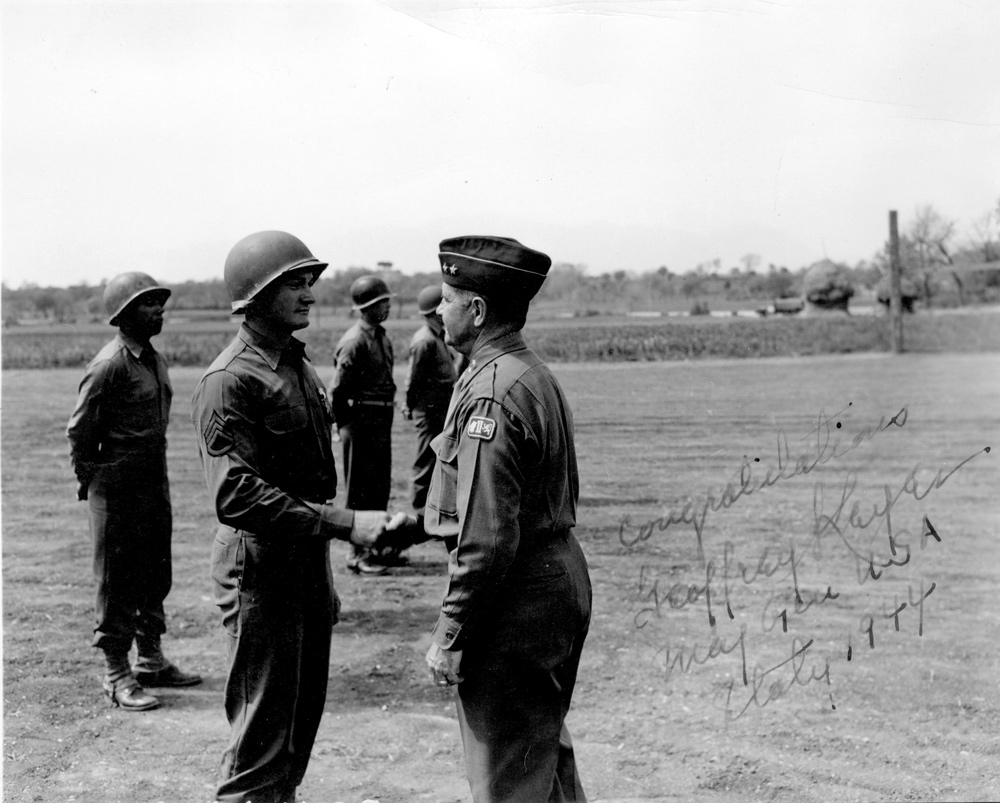
I don’t know who wrote me up. But that was usually the procedure. Somebody wrote it up, and I never knew a thing about it until they told me to dress a certain way, o.d.’s, tie and helmet and I was loaded in a vehicle with a few more fellas. We went down to a place where General Keyes met us.
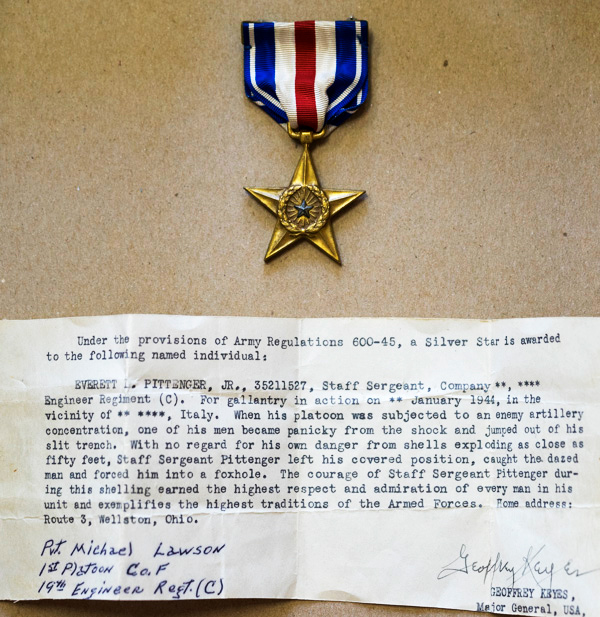
He was the commander of Second Corps. General Geoffrey Keyes, Major General U.S.A., Commanding. During the presentation, General Keyes asked me what town, where I was from, and I said “Wellston, Ohio, Sir.” He looked me and said “What larger town would be near Wellston?” I said, “Chillicothe, Ohio, Sir.” And he said “Fine. I was there as a Second Lieutenant during World War I.” He seemed to be pleased that he’d run into somebody that had been on certain ground he trod, and shook hands and departed. Now that’s the Silver Star.
The Bronze Star. We had the assignment there in central northern Italy, near a little town of Spigno, Italy. Corps down through battalion and they picked F Company because we were the closest in that general area going north. There was a concentrated force over our left, and they were holed up in a huge stone building, and it was a pocket of enemy resistance. So they directed Captain Pohlman to take a force over there and see what could be done about it. In addition to us, we combat engineers, the Corps gave him six Sherman tanks under command of their tank commander to go along with us.
So in preparation to going, we always had anti–tank and all kind of mines, land mines to contend with on our mind. So Captain Pohlman selected me and two PFC’s to ride the lead tank up on the back of the turret. The men that were with me were PFC Davidson and PFC Cox. We got all ready.
It was about mid–afternoon when we left our area and started in that direction by map. Captain Pohlman was basically leading the force over there. We came around the furthest hill and down a small valley and got out in the open. We could see this huge stone building, over on the side of another hill. We got about four hundred yards from that and the lead tank got into a minefield. That was the tank we were on. That stopped him. He had defensive power, but he was immobilized. The tracks blown off. He couldn’t maneuver.
So we transferred into the second tank, and reconnoitered and did some work with the mine detectors. We had two mine detectors. The two PFC’s with me each had a mine detector—the large–type mine detector that was electrically operated. So we transferred onto the second tank and went around and then some of our other men assisted. Sergeant Frank Wary with his squad, came to our assistance. They were coming by foot behind, and they caught up with us. He caught up with us, with his squad, and they had mine detectors with ’em, and together we found the direction of the minefield, how it laid, and cleared a path through. The tanks could go through.
There were some Indian troops. We got up there approximately where the tank went into the minefield and blew the tracks off. There were some Indian troops there, under the British command. They’d been held up by small–arms fire from the direction of that building. So through their reconnoitering, a couple of their scouts come back. Of course we couldn’t understand their language, but we could read their sign language, and they was pointing at that building and patting the tank and indicating there was a tank in that building.
The tank commander, he fired two rounds through that building. The second apparently made a direct hit, and the building blew up. It was a huge explosion, a black fire that a tank will make from their fuel. That broke the back of the force that was in there. These Indian troops plus our troops went on over there while this was going on. They cleared it up.
What it turned out to be was an isolated tank for some reason holed up in that building, with a few German infantrymen. I don’t know whether they hadn’t been detected, whether they would try to slip out under darkness and get on by us, or just what they would have done. They would occasionally do that, if they got into trouble they would hide, and try to get out later.
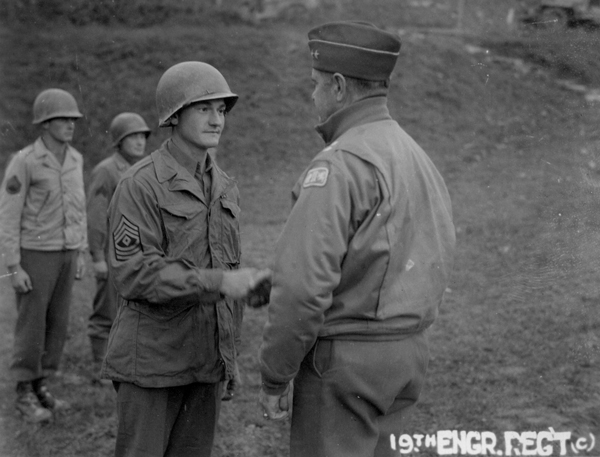
I know one other case that, a work detail, they come down and they’d seen him a comin’, and they come down there and alerted us and we took off and they cleared it and the air force got him. A low flying dive bomber dropped him a bomb just right by him and upset him. But this Spigno, we was written up by some unknown, the three of us, for riding in plain view up on the back of the tank until it run over the mine and then continued on helping get the minefield opened up where they could get on through. We were awarded the Bronze Star.
Here’s the cluster. That’s a second Bronze Star They have a cluster on the ribbon. I have it on the hat in there.
In the vicinity of Berzeta, Italy, I can’t come up with the dates. It was about mid–summer of 1944. We were bivouacked near a road junction for over the night, about two miles south of Berzeta. Berzeta is one of those mountainous towns. It’s up on a high part. The road winds around, finally gets up to Berzeta.
Berzeta, Italy. We went into temporary bivouac. We was moving forward, was what we was doing. We was coming up. This road was a blacktop road. A macadam blacktop road. But where we bivouacked, out in the open, like a valley, there was a crossroad that was like our limestone road, crushed stone road. It crossed this road at a crossroads. You’re familiar with the word bivouac?
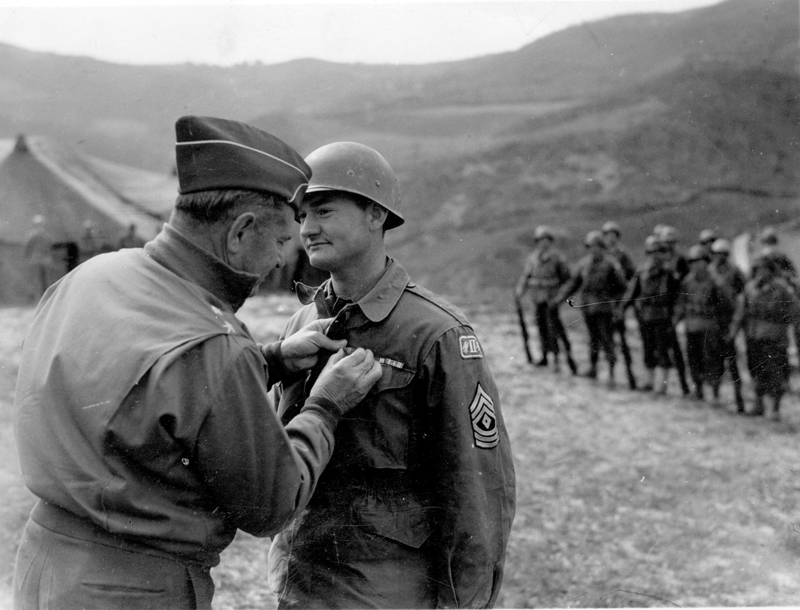
A temporary camp. So it happened to be a vineyard, and about every forty feet there was an irrigation ditch and a row of grapevines parallel with this macadam road. So it made sort of an ideal place to pull up, those grapevines. We could use our camouflage nets and be hid pretty well when morning come.
Well, about ten o’clock that night we heard tanks a’rumbling. Off to our right, up that crushed stone road, which was a two–lane road. One of our tank outfits was coming out of there, and it was dry. It wasn’t a moonlight night, but it was a full, starry night. Those tanks were churning up that limestone and the dust from ’em just made a white streak down through there. A few minutes after the tank column got goin’ and they went right on across there and on down through the country there, we heard a plane circling.
It circled off at a distance and then it came around and just where that road intersection was he dropped...the first bomb he dropped apparently was a huge bomb. It made what they called a four–line crater. It didn’t hit in the road. It hit off the road where the soil was softer, but it made a four–line crater. A four–line crater is so many feet deep to the width of the crater, however they determine that. It was an awful crater there. Threw chunks of mud half as big as a jeep.
Then about a hundred yards, he dropped what we call a personnel bomb or a high–explosive personnel bomb. It went off just the moment of contact with the surface, and it was one of those designed to do the job of shrapnel. That was right near our first row of vehicles off the road, was our shop truck and our kitchen truck and half-track and supplies. Then the rest of the vehicles was on down farther away from the road.
Well, he dropped this bomb and on the shop truck. The shop people had made a rack on their shop truck to carry additional fuel. You know the old GI fuel cans and water cans. They all looked alike, but they made racks on there to carry additional fuel. Some of that shrapnel went right through that gas can on the front of that shop truck trailer. He was pulling a trailer. It went right through there and that hot shrapnel set that gas afire.
Well, first thing I noticed that any of the immediate fellas right near us were not injured. I saw that gas begin to burn on the end of the shop truck there. The shop truck trailer, they were attached together, you know, it was a short coupling.
The flames was goin’ up the front of it and gettin’ up under the tarp, which was canvas over like a truckbed. That was full of very valuable tools and equipment. It was also right on the back end of the shop truck itself. So I run over there to the kitchen and the kitchen had set up their messkit washing, you saw the big thirty-gallon can in the road. Soap, clear, and clear water. Well, there was the water, so I grabbed a bucket that was there and begin to try to put that fire out with water, but not much luck. I took my knife and started a cuttin’ the tie ropes off of it and got it cut off till I could drag that tarp off.
By that time, the confusion had let up a little bit. I don’t know who they were, but other fellas, some of the kitchen fellas and some of the mechanics and them, in a little bit there was more people there to help me. We got that tarp pulled offa there, and we got it rolled and stomped till we got the fire out. One big fear, we thought that same plane would see that he made a hit and he would come back around and do it again.
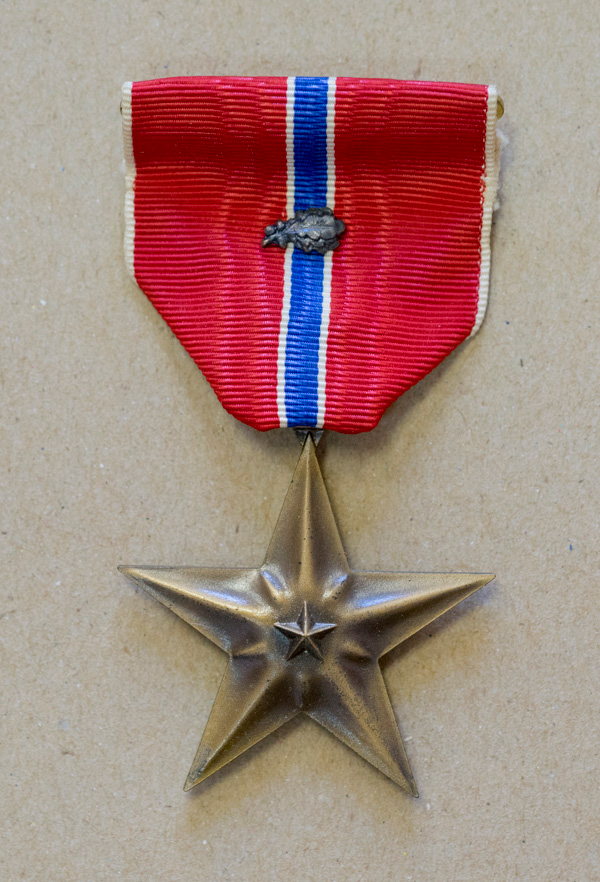
Do it to us again. But, luckily he didn’t. We got it stomped out, and, I don’t know, I just wasn’t thinkin’ about anything but what the fire was gonna do. We needed all that stuff, and I went over there and tried to get it out. Again, somebody unbeknownst to me, wrote me up, what I did, and they awarded me a cluster to the Bronze Star.
I might say that Lieutenant Schultz, Lieutenant Northrop were seriously wounded. Neither one of them come back to our company. By that first bomb. They was bedded down on the ground so near there that they neither one came back. There was one killed and three or four other fellas injured real bad from the explosion of that bomb back there. It made a terrific explosion. Must have been a blockbuster.
Our motor sergeant, he had unfolded his cot and put his bedroll on the cot and was layin’ a short distance from that shop truck. He’d gone to bed in his bedroll, and he was yelling that he was hit. The medics finally got there, and they got him outta there and got him in the ambulance and took him off to the hospital.
The next day before we pulled out, why the word got back to us that Sergeant Burns was hit last night. “How bad was he hurt?” They said, “Well, they say a piece of shrapnel shot his toe off.” So us guys went up and sure enough, there was his bedroll where they done tipped him out and got him out of it. We just completely zipped it on up, on down around, across the end and opened it up. There that shrapnel had gone right down through there. There was the end of his little toe. So it made believers out of us. It did shoot his toe off. That piece of shrapnel went through that bedding and took his little toe off his right foot. He came back. He limped a little bit, but he could walk. He had a time livin’ that down.
You know guys. They gotta pick on somebody. But there was his little toe from the joint out We had physically found it in there. We saved it for him and gave him his toe back.
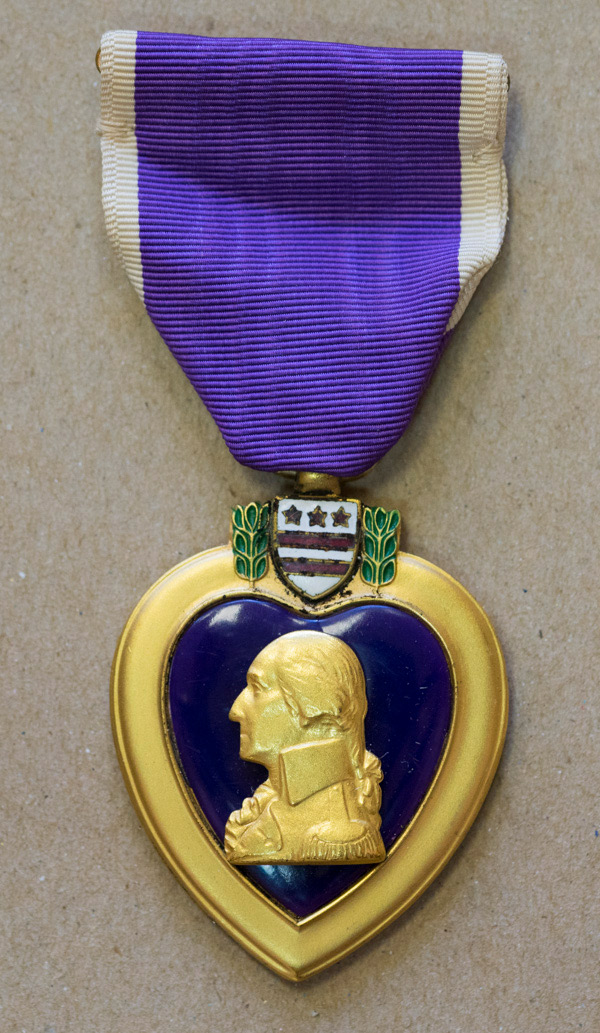
The Purple Heart. We was on a work detail at Empoli, Italy. What had happened, on a road leading out of Empoli, which was sort of an important road for the forces to use, the Germans, before we got in there had blown out a fill—you know, a depression. There wasn’t a bridge, but it was a...you know what a fill is, where they just go from one high part to another and make a fill in the road. It usually has a tile under it for the drainage. They just completely blew about a forty-foot section of that fill out, road and all. To put it out of order. So, the night before they’d sent a mine detector crew in there to check it for mines, and sent heavy bulldozers in there.
The operator on it was Corporal Don Hedrick. T-5 or T-Corporal Don Hedrick was the operator of it. He just got to workin’ right good on it, and he run over, we assumed it was a mine. I wasn’t there at that. There was another detail workin’ on it. It seriously hurt Don, but he recovered from it. It blew the caterpillar right half in two right back of where the motor fastens onto the transmission. She just buckled half in two there.
As Don went off of it, it was the type of bulldozer that has the A–frame out on front and cables run through a channel bar to the back and then down to the type with the clutch levers back there. As he went, it catapulted him off. His head, even with his helmet on, hit that channel goin’ across, put about a three-inch gash in his skull. He eventually come back to us, but he had a terrible scar on his head. So next morning, why I was detailed to pick up that rig and go ahead with it.
First thing I did I went to Sergeant Reynolds. Sergeant Reynolds had been sent back to North Africa to mine school, and he had a diploma, a certificate that he’d made good grades back there in the mine school. He took his detail in there, and they worked till noon, from morning, let’s say 7:30 or 8 o’clock until noon, and covered that whole thing again and couldn’t find another thing. So we went to work on it again.
But up in the evening, this fella come along with a jeep, and just before he got to where the crater was, Sergeant Theiss and I were standing about along the edge of the road, from the middle to the edge of the road, and we were determining how we were gonna mark this to keep anybody from running into that till we got it finished. A jeep came along, and running along the edge of the road, it hit that just right, just right by us, like we were here and he was running along there, and he ran over another mine.
We come to find out that the Germans had started using a prepared charge in an all–plastic case. Our mine detectors wasn’t pickin’ ’em up. That was the first incident that we got into about the plastic mines. They just called ’em plastic mines, but they was actually a case that was all plastic, the detonator and all, and then a huge charge in ’em.
It completely destroyed the jeep. It was our platoon jeep, too. About the only thing that was left of it was the back bumper and part of the back end of the jeep. The front part of the jeep was completely gone. It killed the driver of the jeep. He went in the air, oh, three or four hundred yards. What we got was a concussion and the shrapnel from the jeep and the mine itself and the rock and whatever of that blast.
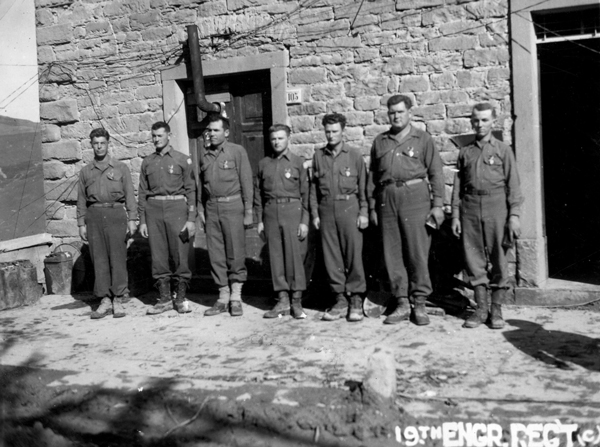
I got shrapnel through my ring finger on the right hand, side of the face, in the right ear, in my neck, chest, side, down to my right knee. Shrapnel into my right knee, which has given me some trouble ever since. Huntington says that the piece that’s in there is so close to the joint in my knee that they’re afraid to do surgery on it, afraid they’ll give me what they call a knee that’ll snap or crack every time I use it. And on account of letting the joint water out.
Apparently the shrapnel pieces were like BB size. If it’d been much bigger that would cause me...from then this nail come off, and it’s been, I’ve had bad luck with that finger. I’ve lost that nail three times, and the medics told me...this medical doctor said when he saw it, he said that nail ’ll come off and you’ll always have a split fingernail. So, to this day, he’s exactly right.
See, there was a hole about the size of a good BB or a grain of popcorn. It didn’t come through on this side, and it wasn’t in there. They said it mighta been a chunk that was goin’ at a terrific speed and hit and just went right on and punched that hole through there. Boy, that thing really did give me fits. Then there’s a scar there. That place there don’t want to get well. This place, it’s just like been burnt. It irritates this ear.
Sergeant Theiss said it looked like I’d been shot with a shotgun. He came out of it with his left eardrum burst. He got a burst eardrum out of it. Never drew blood on him. He wasn’t awarded the Purple Heart. That’s kinda strange to get a burst eardrum. It seemed like to get the Purple Heart it’s gotta draw blood. I don’t know whether that holds true all the time or not, but they didn’t award him the Purple Heart.
He lives in Tucson, Arizona. I hear from him every Christmas. He said he could lay on that ear and can’t hear a thing, can’t hear alarm clocks. Anyway, we survived.
Well, Bill, I’ll tell you how it felt. Theiss...we talked about it later, of course. We told each other the same thing. All I can remember was just a huge orange ball. I was lookin’ at that jeep and all at once there was no jeep and nothing but a big orange ball.
How far away was the jeep when it exploded? Well, an ordinary blacktop road is what, 40 feet? We were a little more than halfway across the road, standing there. We used tracing tape, this wide white tape, to make temporary barricades around bad places. Well, let’s just say thirty feet.
The next thing I knew, I didn’t know where I was, but I was lookin’ straight at the sky. I could see little streamers. It looked like there was smoke comin’. It actually was. There was particles off’n that jeep and things that’d been shot I don’t know how high, but they was burning and coming down.
It didn’t blow either one of us very far. It just flattened us. It just flattened us flat on our backs. How we know this, our crew was up on the halftrack. We’d used the halftrack that day for power, and they was about oh, say, fifty to seventy-five feet up, loaded up on the half-track lookin’ right down the road at us. We was all ready to go in. We’d done what we could, and we was waitin’ for another bulldozer to come to make that fill up to that crater. We was gonna mark it so nobody would get in it. They was lookin’ right at us, and they witnessed the whole thing.
The jeep, they said, just disintegrated, and this fellow flew over the top of them and went down through the back of a building. Over a building there at that little place. They said it just blew us flat down on the road right on our backs. This Corporal Wagner from Defiance, Ohio, he was on the halftrack lookin’ right at us. He said he jumped off the halftrack and run down. He said neither one of us moved until he stepped over Theiss and looked at me and turned around. He thought he saw Theiss move a little bit, and he turned around and was lookin’ at Theiss and he turned back around and I’d pulled one leg up. You just draw your leg up, you know. But you just still lay there. Finally I come to and got settin’ up and tryin’ to figure out what happened. Of course we were taken to the battalion medics, and they worked us over.
They were close to our company. They kinda like to be along our company. I believe I said before that they kinda liked to eat with our company. So they’d move along, a lot of the times, and luckily they were right close to our company again. I suppose in all the confusion, and we had to go back about three mile to get to another road that come out of Empoli, back here. Go back up I’d say through all the confusion that went on, probably an hour.
There wasn’t a surgeon, but there was a captain and a second lieutenant medical officers. They were physicians. The aid men which was non–coms, all of ’em was sergeants and they had a regular staff of aid men. They were with the Second Battalion. There were two battalions in the regiment, First and Second Battalions. Each battalion had a medical setup.
I had not lost a lot of blood. All these places bled, but not profusely—luckily. I was in shock. It was like when you’re comin’ out of a nightmare. You’re scared. Your nerves are shot and you’re scared. You know people, but you don’t talk rationally and you don’t have your complete facilities yet.
I rode there on a halftrack. They loaded us up on a halftrack. That was all the transportation we had. Got no jeep. No driver, either. Well, it was a sad situation.
They treated me fine, but to this day I can’t understand why they didn’t give me first aid treatment, what they was capable of, then send me back to regimental hospital for further checkout. They took me over to camp, back to our company. Both of us. It took, oh, a week or ten days to recover. I was so sore I couldn’t hardly...
The third day, just the aid men would look at my wounds, you know, and maybe dress ’em, this finger and this knee and put stuff on ’em. The third day I went on sick, when they had sick call, I went with a bunch down to where they had the battalion station set up. Medical station set up.
Well, this captain, he said, “What’s the matter with you?” and I told him. He looked me over and he said “Well, get back and go on K.P. and you’ll be all right in two or three days.” I was glad I didn’t have my sidearm with me because there’d been one less captain. I tell you I was sore. It is true. Theiss said, “You just look like you was shot by a shotgun.” Ever’ one of them places, you know, had to get well.
8—Home
We went over to Casablanca. They landed over at Casablanca. Bussed us down to a barb wire enclosed stockade, and put us in there and kept us in there until they processed our orders out. They left us to watch a bulletin board there whenever we was gonna get to leave by another plane to the States. That plane was a C–53, four–motored passenger plane. It had nice seats. It was really a nice plane.
Eleven o’clock at night one evening my group, our names were there. Eleven o’clock we loaded on it, and we took off and next morning we landed on the Azore Islands to refuel and for breakfast. It was a terrible dark, low–cloud, rainy morning. They set her down on the landing strip on the Azore Islands. We got our breakfast and I guess they refueled and took off and landed down at Miami, Florida about six o’clock in the evening or maybe a little bit later. It was getting kind of darkish, like.
They at once took us down to where they had arranged for the barracks, you know, sort of a camp there. They processed us there. In a couple days we got ready and got boarded on the train and they brought us up to Camp Atterbury by train. Camp Atterbury, Indiana. We was there a couple days getting processed, and the situation had changed until this rotation plan you got home for forty–five days. When it started out, you’d get home for forty–five days and then you’d return back on your trip and you’d end up right back in your same outfit. By the time we got to Miami, why things in Europe had changed so much that people with a certain number of points under the point system, they were discharging them. So I qualified with plenty of points left over, mainly because of my citations, that when I got to Atterbury they discharged me on the 16th day of May, 1945.
See, we were on temporary leave. We were to have a forty–five day furlough and go back to our original unit. Got to Camp Atterbury and the next day some orderly come yelling for my name. “Go to the orderly room!” I said what have I done now? He said, “I don’t know.” I went up there and they said, “Sarge, you’re not a gonna get furlough. You’re gonna get discharged.” I almost fell over.
I got a bus you know that used to run down from Columbus to Jackson and then on to Oak Hill. We got in here at Jackson about 2:30 in the morning and I went in there and there wasn’t a soul there. There were those settees and couches in the waiting room there and I said to the fella that was on duty, “Do you care if I lay down there a while?” He said “No, you lay right down there till morning if you want to.”
So I just went sound asleep, woke up with people waitin’ on the bus. They thought that was awful. Well, why get ever’body up in the middle of the night just to come down from Wellston to Jackson to get me? Nobody’d got any sleep, would they? Well I tell you, we was wore out, comin’ from Naples over to Miami and do this, do that, and then on the train all the way to Atterbury. Why, a feller was asleep on his feet anyway.
We were kinda funny, comin’ back to the very steps that we left from almost four years before, you know. We left there at the Court House and walked up there and got on the bus there at the Gibson House and took off.
What they was doin’ to us, was the war was winding down, they was wantin’ to build up new commissioned officers because they wanted to send all the originals back. After so long a lot of them had went on to the Pacific, see? Well, I’d been through five major campaigns and survived it, and I thought my number was just about up. So, maybe I’d a got along all right there, but you know where Tom Allen and several guys that we knew, they ended up in ’Nam or Korea because they had a commission they called ’em back in.
Anyway, I thought I’d used up all my chances. I don’t know. Maybe that wasn’t a very nice way to look at it, but I wasn’t figurin’ on makin’ a career outta of the Army anyway. I’m proud of what I did.
I mean I tried to do what I was supposed to. Several of the fellas that I knew was, it was Masters, Firsts and Masters. They usually started with a First Sergeant and went up to Masters, Techs you know. And several of ’em took it up. I haven’t heard from any of ’em. Sergeant Patrick and...I hope they made out all right.
I got home on May 17th, 1945. I had, let’s see, I had ninety days to return back to the railroad to my former position. I went back to work.
I think it was the railroad policy along with the selective service organization. We had a time to return if we wanted to return to our former employment. I went back to work, I think, the 29th of July. I was off the rest of May, June, July. I went back at the beginning of a new pay period, so I was ready to go back.
I was a trackman, maintenance of way on the B & O Railroad, headquarters here at Jackson. I went from trackman to section foreman and on up to line gang foreman and extra gang foreman.
Line gang foreman is foreman over a gang that will cover the territory of several section gangs. The old sections used to be about ten mile long. The line gang, the supervisor could give them orders to go, oh, down to Portsmouth and assist that section gang down there or at Oak Hill or Jackson. Wherever they had like a bigger job going than the section could handle by itself.
A line gang usually was a foreman and from ten to twelve men, to make it like in putting in ties or switch ties, they had more men to do the job. Usually they worked along in conjunction with the section gang which made it like a fifteen or sixteen man gang. They could do more work in handling material, like if they was laying rail or switch ties which is heavier work than regular maintenance.
Extra gang, it may be about the size of a section gang or maybe from six to eight men with foreman. He can hedge hop from one, under the supervisor’s orders, he can hedge hop from one section to another. Sort of a floater. Had a troublesome place, well they can send this extra gang to fill in or take care of the problem, that the local people will be there, but they need help.
I took care of the water system down here at the Jackson Depot for ten years. At that time the steam engines were the power, and they had the water tank facility here, that was tapped onto the Jackson water system. Of course the facilities to water the steam engines. They came along and installed a treating plant with water tanks. The oldtimers called ’em the tubs, the water tubs. I took care of that for ten years. I made a test on the water once a day with chemicals and added soda ash and extract as the test required.
It cut down on the boiler maintenance tremendously after I got to using that. The boilers wouldn’t corrode up. It foamed. A lot of water would foam on ’em so bad, boil up and foam and it cut their steam down. Treating this water kept it a lot better for ’em.
At that time Chillicothe on the B & O was the main point at the B & O for the maintenance. They had a large number of steam engines. Freight engines, passenger, and regular local steam engineers. You could remember going down the branch here. To give you a number how many, I’m not sure how many. The local engines was like 400 class, and then the bigger freight engines were the 4500 class steam engines, and the passenger engines was like 5000 class steam engines. The passenger train was built of course for speed. The freights were mostly for heavy loads.
I retired in 1979, the last working day in July. I think that must have been about the, let’s say the 30th of July, 1979. I had a total or thirty–eight years and four months service. I liked railroading. It was interesting, hard work of course. You was out in the open. That meant you had bad weather to contend with, but as a whole I liked railroading.
9—Questions and answers
Q: When did you get your promotions?
My promotions? Well, before I was wounded September the third, 1944, I was a staff sergeant. Say November 15th, our first sergeant was killed by a artillery barrage. I had known him from the time we were at Fort Ord. He was the mess sergeant of our company, and he was a fine fella. He was a Regular Army man, and he advanced through the ranks. He was promoted to first sergeant in the last days of North Africa. When he was killed, I was the ranking staff sergeant in company, and it seemed to be the procedure that the ranking staff sergeant was nominated to be the first sergeant of the company if he qualified and if he would accept it. It wasn’t mandatory that you had to accept these promotions, but usually you did, and so I accepted the position of first sergeant about November.
Q: Does that mean you skipped over sergeant first class? Or did they have that rank then?
No, it went private, private first class, corporal, sergeant (that’s a three–striper) and then your staff (three stripes with a rocker under it) and then you jumped from that to the first sergeant. Now there was a staff sergeant in each platoon. There’s a staff sergeant in supply. There’s a staff sergeant in the cooks. The head cook was a staff. And a staff sergeant in the motor pool. Then from that it went for first sergeant. Sergeant Pomphrey was killed and he was the first sergeant. I was promoted to first sergeant.
Q: I thought there was three up and two down?
What was master sergeant? From first sergeant in our outfit, in engineers, from first sergeant he was, he was this one. Take the diamond off and take one off was a tech sergeant. Technical. Then put the other one down below and take the diamond out, he was a master sergeant.
Q: Was he an engineer? Was a tech sergeant and a master sergeant, were they engineers?
Yeah, they were engineers. They were both in headquarters, the headquarters company.
Q: Okay. You were out in the line company, going from staff sergeant to first sergeant?
Yeah, first sergeant was the highest ranking non–com in a line company. See, your PFC, Corporal, your line, your three striper, then your staff, then your first, then take the diamond out and there was the tech, technical sergeant, and then the master.
Master was the highest rank of all of non–coms in the regiment. He really was a higher rank than the first, but he wasn’t in a line company. He was in the H & S Company.
Q: How far back was the regimental hospital, and how big was it?
Oh, regimental, they usually stayed within, oh, normal times, not over ten mile behind us. They stayed pretty well in the clear, you know, because naturally, you wouldn’t want wounded guys up too close. Then if they was seriously wounded, they’d send ’em on back to the bigger hospitals.
Q: Would that have been large tents, then?
Yeah.
Q: How many men would be in the regimental hospitals? How many patients?
Oh, maybe, oh from fifty to two hundred or more. It’d just be according to the situation. It’d be after a drive or a battle, we called ’em drives, if it’d be after a battle, maybe there’d be easily a couple hundred men in them—huge tents, you know, great big long tents.
Q: Would they be in the same general location as the armored division hospital?
Yeah, yeah, yeah.
Q: So you were still closely associated with the armored division?
Right. Then, just for an example, one other time where we got a direct hit by artillery and some of the fellas, one fella it almost shot his leg off, why they took him back, and he ended up at Naples. The Army had taken over a civilian hospital. He ended up there. Another fellow got hit right direct in the middle of the back and it completely paralyzed him. Those two, they ended up at Naples. Then they shipped ’em to the States after they’d see, you know, what they could do for ’em. We never saw them anymore. A couple of the other guys, they got shot through the legs, and they more or less were just flesh wounds. They kept ’em until they was healed up and sent ’em back.
Q: You said you had the metal detectors with the mine sweeping. I’d like to know how those work. Tell me about those metal detectors. I’ve seen ’em in pictures and I haven’t the faintest idea how they work and what they were like.
Okay, well we’ll start with the handle. There’s a handle on ’em about the length of an ordinary long pointed handle, long–handle shovel, you know, long–handle shovel. Down on that end there was a disc, about the size of a fifty–pound lard can, just about that size—round. And it was about that thick.
Q: Indicating about two inches?
Yeah. That was of course on a frame on that handle, and it was bent where you stand up, it was flat, parallel with the ground. Well, about mid–ways up, and I never saw inside of one of those heads. We’ve had ’em blown all the bits, but I don’t know how they was made, but anyway there was something electronic, you know, in there, because they must have been full of wire and magnets and everything. But anyway, there’s a cord came about halfway up the handle, and there was a little box about that big.
You know the old automobiles like the Model A Fords and the older cars that had the little amperes hand on the dashboard? That you could see that little hand go like that from say zero to ten?
Q: Sure. It would have a gauge on it instead of an idiot light?
Yeah. It was about that big, and it faced the operator. He could look down the handle and he could watch that as he swept. He’d sweep like this, and then you’d take a step and you’d try to sweep the width of the head of that mine detector, see. When you was actually sweeping, you’d try to cover it like you were painting it.
I can’t tell you how many, but there was either four or six or maybe eight flashlight batteries in there that give it the power. There was a switch on it, that you press it forward, well she was on. Press it back it was off. Of course you turned it off when you wasn’t using it or you’d work on your batteries, you know. On up the handle on a cord and then the cord was long enough that you put a band around, like this.
Up on your shoulder was a little round thing about that big around, about that thick, and it was a toning thing. When you turned it on you could just hear a light hum, you know just like a...well, like a flourescent light. That hum?
Q: Uh–huh.
You could hear that hum. Then you’d turn the switch on and you’d get that hum, and you’d start out. If you went over a piece of metal it would go “Bee–eep, bee–eep.” You’d get a high frequency beep. That told you that you was over somethin’. If you was really down to serious business, you’d usually back up and you always had a couple buddies and they’d have bayonets. We even made probing rods. Well, gingerly we’d start lookin’ to see what we had there. If you had a mine, why you’d take care of the thing.
Q: What do you mean by “take care of it”?
Well, we had training to remove and put ’em to the side and guys would come along and mark ’em you know, so somebody wouldn’t get over ’em.
Q: You put ’em off to the side and move on?
Yeah. We had several different ways. Now in the Teller mine, the German Teller mine, it was a mine about this big around, about that thick.
Q: Indicating what, about twelve, eighteen inches around and several inches thick.
About three inches at the most. It had seventeen pound of explosive equal to TNT in it. Seventeen pound. That’s a pretty good charge. They would blow the track off of any tank or track vehicle. Or a truck run over it with a front wheel, that truck was minus the whole front wheel and front end. I seen lots of ’em get that. Then of course if they’d back up, well the same thing. But anyway, that’s how strong they was. Now a man could step on them and it wouldn’t detonate. One of those Teller mines.
But then they had anti–personnel mines. They had one that they called a S mine. It was in a canister about the size of a quart oil can, and it was a double can thing. This canister went down in the ground level, just below level to the ground first. It had a charge in it, and a detonating device, where if it was pressed so far like a switch, it would set off a charge. The other canister that went down into it, it had a charge inside of it that was on a timing device.
On top of it there was three little steel prong wires like that, just little short fellers, and they’d set them just level with the ground, the mine, and them little things would be stickin’ up just like that, in the grass. See, it wouldn’t always be buried, though. They could conceal them with a little grass or leaves or anything. If an infantryman or somebody would step on either one of them prongs or all three of ’em, it pressed that down and throw that switch on. It’d throw it about six to eight feet in the air and then that timer device, she’d explode. There was two hundred fifty steel balls in there. Now that was really death on infantrymen. I mean or anybody, a group like. And that was one of their worst mines.
Then they had what they called a shoe mine. It was about the size of...you’ve seen the old-fashioned chalk boxes that they used to have blackboard chalk in?
Q: Sure.
Little dove–tail boxes. They was about that high. They had a hole and a slot in one end of it that they could pull out a detonator till they’d come into a notch. It went back into a quarter pound of explosive back in that little box. When they set that thing, they could set it and then close the lid on it. Then if you stepped on that lid it would press down on that notch and that’d fly in and cause it to go off.
It wasn’t really made to kill you. It was just made to blow your foot off. You was out of action, and it took three or four guys to take care of you. That was their theory. It took more people to take care of you than what you was worth goin’ ahead, see?
Then they had various type of trip wires. They’d put explosive charges. If they’d get into thick growth where they wanted to mine a place, they’d have little short steel stakes about this high, and they’d run it like this through there, maybe for oh, a hundred yards. They’d have these mines hidden and they’d have trip wires. Them little wires were little steel green wires, and at night you couldn’t see ’em at all. In the daytime you’d likely not see ’em. Put a little tension on that wire, one of those things would fly up and go off. They had various types of anti–personnel mines, booby traps.
Q: Was fear a major problem with these men, or did they have enough morale that they were able to get out and do it? How did that work, day to day?
Well, Bill, it seemed like, that once you got into it you had that fear, but you overcome it some way. You’d go ahead. Now replacements. We was continually getting replacements, and they were pitiful, how scared the guys would be ’cause they hadn’t overcome that fear yet. After two or three experiences or outings with us, why they’d usually come along. I’ve seen fellas just practically refuse, but we tried to bear with ’em because we knew how we felt at one time, too.
Q: Did it ever occur to you that you had a lot to be afraid about?
Yeah. Lots of times.
Q: You just did it anyway?
Yeah. Had to. We was, we was ordered to, and only one thing to do is do it. Just do it or die, I guess.
You know. If you disobeyed your orders or didn’t go do your job and come back and “No, I didn’t get it done. I seen some mines up there” or “Artillery came over”. Why “Well, we know that, but you didn’t get the job done?” See, there you are. Once you become a non–com you had a certain amount of responsibility to get it done with the men you had. I’m sure when you was up in the commissioned officers, why they had the same problem. If they went back and told the major or the colonel “No, I didn’t get it done. We got into a bunch of mines up there and we couldn’t do that.” Or “We run into shell fire” or snipers. We’ve been sniped at. Just something that you...I don’t know, you accept it and you just go ahead.
Q: Did you get any orders from your officers that you thought were so stupid that you shouldn’t do it?
Yes.
Q: Did you avoid doin’ it?
No.
Q: Did it anyway?
Did it anyway. I wouldn’t want you to hear a tape, some of the guys how they talked about it. But they did it anyway. They either got knocked out or got the job done. It was drilled in us, you know, from basic training on.
Just like every morning before breakfast we’d run with the rifles about a three mile circle. We’d have to jump these pits that was full of water, you know, and after so many’d splash around in ’em the banks would get slick. “I’m not gonna do that.” Well they did do it. You’d get thrown in. You might as well do it. They’d throw you in it.
Q: How often were you brought out of that and given a few days off?
Well, not very often. Across North Africa, we didn’t have no days off at all. We didn’t have any days off in Sicily. The first time I had some time off, we got up at Caserta, Italy. That’s just south of Cassino and among Naples, and they started this program of giving us five–day leave. So many men out of each company and they’d have a designated place, and they’d furnish transportation.
We got to go back to Naples after they got Naples cleared out. They had big old, sort of like barracks or something down there that they took over and cleaned up. We had canvas cots to sleep on. Blankets. Then they had a mess place for us to eat. Our pass just was for Naples. It included if we wanted to sign up, we could go run a train out to Pompeii.
Q: Did you get to Pompeii?
I’m certainly glad that I took that trip out to Pompeii on a train. We was out there from say eight o’clock in the morning till four in the evening. I’m sure glad I went out there. We could just look around all day.
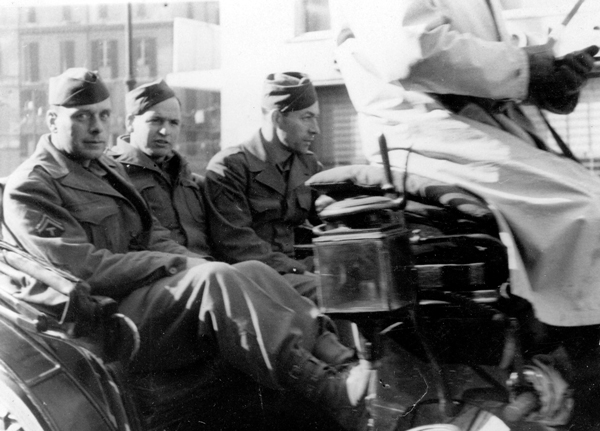
That was my first leave. Then we got up to Rome, got above Rome. I got to go back to Rome for five days.
Then we got above Florence, my turn come up again. We got up toward the Bologna front, I got to go back to Florence for five days. Later on that winter of ’44 and ’45, after a part of the winter, they sent half of each company, over to Pisa and Leghorn for five days. Had hotels. Billeted, you know, in hotels.
Q: So they tried to give you some time off in Italy, anyway?
Yeah.
Q: Keep you fresh?
Yeah. And that really helped a lot.
Q: How was the mail service on the line there?
Normally we had good mail service. It took it a while to get from the States over there.
Q: Do you recall how long? Was it a week?
Ten days, eight or ten days. It seemed like I’d get a letter maybe eight to ten days or something like that.
Did I show you this picture? That was taken in Oak Grove Park in Pasadena, out at Pasadena, California. I think I told you before we cleaned up an abandoned three C camp, and we bivouacked there after the Japs hit Pearl Harbor. This fella he was on his way home and he got to Fort Ord after three years. His three years’ enlistment was up, so they just canceled everything like that.
Q: You mean that poor fella was on his way home and he got caught on the way home?
Yes sir. After that they let him and a lieutenant go from there to The Bronx, New York. The evening of the day they got there, they got orders to report back to Fort Ord, California, at once.
The Stars and Stripes wrote up somethin’ like that. That come out in the local papers through the government, that I had 550 continuous days. I racked up a good many points. That’s one reason I got to come home.
After the Bologna front, we crossed the Po River, we could tell that the war was winding down. When we motored, come on a convoy from up at Verona back, we come back to Leghorn, gee whiz, that morning there was just mile long lengths of column of fours of Germans and officers and no arms.
Q: Prisoners?
Well, yes, they were prisoners in one way, but they was just give up and there was nobody with ’em. They was just marchin’ all by themselves. Just column after column.
Q: In your unit, say in Italy, how important was alcohol to the troops?
Well, you mean to the common soldier?
Q: Common soldier.
Well, the ones that really had a problem with it, they was pretty bad, but it was a small percent.
Q: Well, was alcohol readily available, like the wine in France?
Yeah. Now that was one problem across Tunisia and Sicily and up through Italy. They were wine countries and just about any place they’d go, they could get wine, different types of wine. Some cognac, what they call cognac. It’s more like a liquor, isn’t it? But it was a common thing.
But they really were in the minority, the ones that really, we had a few of ’em right in our company. They had to get rid of some of ’em, too. They ended up in trouble of course, missing formations and runnin’ off from their details. They were just nothing but a nuisance. I still hate ’em.
Q: Some of the people that I’ve talked to said that they thought that alcohol was used as something to give a little comfort to the troops. They were under such mental strain that they had to have something to relax that strain.
I go along with that to a certain degree, but I think way back in their lives, even in civilian lives they had to have it.
Q: You mentioned the Stars and Stripes, the newspaper? Tell me about the Stars and Stripes. How often did you get it, how important was it, what was in it, and so on?
Stars and Stripes was very important to us. It was really the main news that we got along the way, and usually we got it, say, every week or ten days they came along. Along the line, who would be working they’d throw off several issues and drop by the company headquarters and drop off a few. It was really appreciated. I have several old copies around that I brought back as souvenirs. They had war news and back home news and over all news, and it was something to look forward to.
Q: Did you have a sense that the war news was accurate, at least as far as it reported the Italian campaign?
Yes, I think it was accurate to a great extent.
Q: When you weren’t moving, it said you weren’t moving, and so on?
They usually had what was going on in Europe and in the South Pacific and over that way. News briefs, pictures.
Q: Do you recall where it was published?
No, I really don’t know where it was published. I might look at an old issue and see if it tells. When we take a break or now, I can go get one. I think I can get one.
Q: Can you?
Uh-huh, sure.
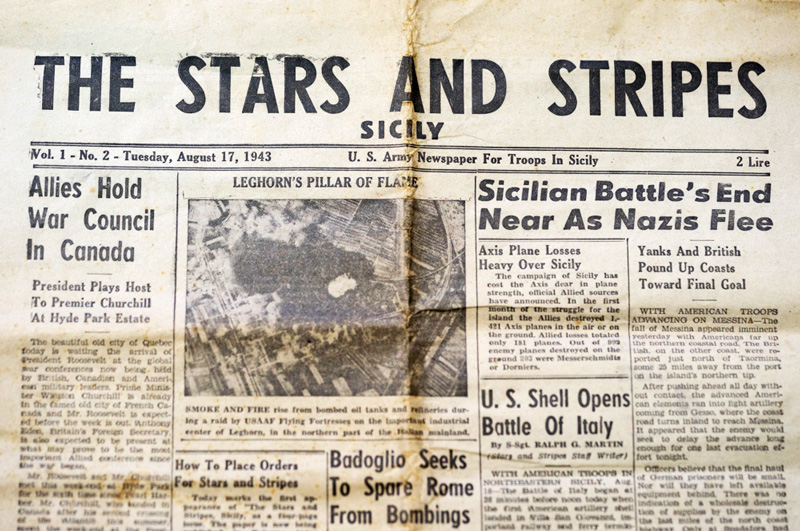
Q: Okay, we’re back on here, Lyle, and we’ve got some Stars and Stripes. Mediterranean. It looks like the Stars and Stripes had several issues according to what theater you were in. This is the Mediterranean issue.
We really appreciated getting them. Most of us got letters frequently, but it filled in between, and gave us something to read and talk about. We didn’t get much news by radio or anything like that.
Q: Here’s one dated July 10th, 1943, and it’s the Stars and Stripes, Africa, and the headline is “Sicily Invaded”. Allied forces begin landing operations. It’s got a map showing basically what Sicily looks like and where the forces landed. It’s got a “Sad Sack” cartoon in it.
Yes, we always read “Sad Sack”, Bill. We really kind of adopted him as cousins to us. Sad Sack.

Q: It says here the Stars and Stripes in Africa is edited and published by and for the personnel of U.S. Armed Forces in the North African Theater of Operations, printed by Lecca de Algiers, in Algiers. It looks like the officer in charge is a Lieutenant Colonel.
I had never given that as fact, I don’t know why, but I guess we was reading...
Q: It’s real interesting. Got sports news here. The baseball scores.
Yeah.

Q: Cartoon “Terry and the Pirates” with Milt Caniff.
Uh-huh.
Q: News about the Red Army. That was in 1943.
The big Russian push.
Q: January, 1945, Stars and Stripes, Mediterranean. Let’s see if it’s got the little bit in here that’ll tell us where this was printed. Rome. The Mediterranean edition was printed in Rome.
I think that issue carried the article about the 19th Engineers there. I believe that’s the issue. Of course, I would save it, you know.
There you are, Bill.
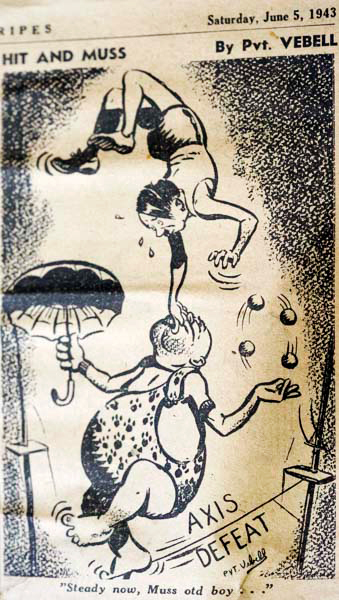
Q: 19th Combat Engineer Regiment has put 550 days at the front. This is in Stars and Stripes. “Wherever Stars and Stripes reporters have gone, Tunisia, Sicily, Italy, they’ve always run across the 19th Combat Engineer Regiment. And like all the Joe’s who are proud of their outfits, the men have asked ’Hey, when are you ever going to do a story about the 19th Combat Engineers?’ Many stories have been written about the men and deeds of the 19th, but up until today censorship regulations have never allowed the unit itself to be designated...The 19th, in the words of Colonel Joseph O. Killian of Altadena, California, long its Commanding Officer and now II Corps Engineer, has done every kind of combat engineering in the book and a few new ones, too. The 19th was reactivated on July 1, 1940 at Fort Ord. Then Tunisia, then Italy...” So that’s why you saved this one, January 17, 1945.
That’s quite a souvenir.
Q: Cartoon here is “Lil’ Abner” by Al Capp. We’ve got April, 1945, the Mediterranean edition. Looks like they’re winding down and taking prisoners by the ten thousand. Here’s “Up Front” with Mauldin. I was wondering if Mauldin was going to be in here.
Yeah, we really got a bang out of those cartoons. We had a small book of those cartoons.
Q: And it looks like they’ve got a pinup in here.
Yeah, they always...
Q: “Dick Tracy”, “Blondie”, “Lil’ Abner” again. That’s real interesting.
We oftentimes think that men who are near the front line in a wartime situation, that they have relationships with other men, a buddy kind of relationship in the military, which is considered a very strong relationship. Are you able to confirm that situation in the 19th Combat Engineers?
Yes, I think that is true. It seemed like you’d fall into certain fellas that was closer buddies than others. In your units you knew basically the other guys, most of ’em by first name. But it seemed like there was always little groups around that went on pass together if they could or had details or tented in the same area, that was closer.
I think maybe the locations where they may have come from, different states or different cities, close, they’d kinda buddy up closer.
Q: How many buddies did you have in your little group?
Well, there was several of us. Sergeant Theiss and Sergeant Small and Sergeant Kisor, Corporal Robinson, PFC Mustapha, just several.
Q: Have you kept track of these fellas since the war, those that survived?
Well, I’ve done pretty well. Once I got back home in May of ’45, then I got several Christmas cards at Christmas time, and I sent several. Then, 1946, I heard from more of the fellas, and it got up to like fifty different fellas that I knew. It was from totally over the United States. Since that time and especially in the last fifteen years it’s dropped down. I got twenty-three this past Christmas.
Q: Have you had organized reunions?
Yes. They have a 19th Engineer reunion every year, usually in like September, August, September, along in that time of the year.
Q: Where do they have it?
Well, this 1990 reunion, it will be held in St. Louis, Missouri.
Q: Do you ordinarily go the reunions?
I haven’t attended many. I’ve attended, I believe, four. One at Cincinnati, one at College Park, Maryland, one over at, let’s see, it’s near Baltimore, you might say near Baltimore, Maryland. It was out at, north of Washington up toward a junction up there. Baltimore Junction I think they call it.
We’ve always had a good time, and several attend, but likewise, age, health and transportation problems and traveling, the number is diminishing as we get older. I get a letter every late summer about the reunion, where it’ll be held and the town and usually a rundown on the hotels or accommodations that we can have. It’s really nice.
Then we have 19th Engineer Association, which I’m a member of, and they issue a card every year. We pay an annual dues of five dollars a year to keep in good standing. That’s just to help on postage and things like literature that they print and send to us. It’s nice to keep in touch with ’em after all these years.
Q: A change of subject for a minute now. Think back to I guess Africa, Sicily and Italy. I believe I asked this question as I recall with respect to Africa, but perhaps not with respect to Sicily and Italy. Did you run across very many German prisoners as you went forward?
Yes, we occasionally was in close contact with prisoners.
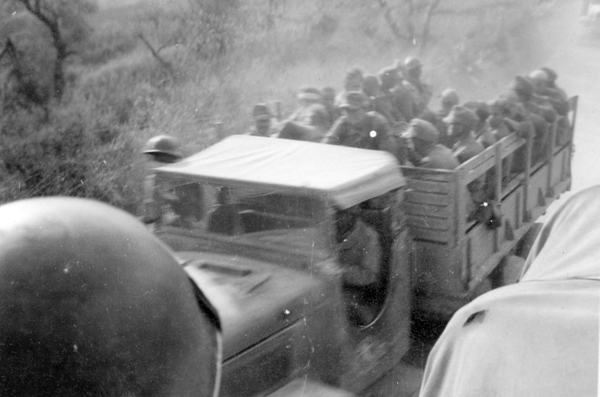
Q: How were they handled?
They were handled of course by guards. The infantry usually collected them on the line and had charge of them. They’d have collection points along back of the lines and get ’em there. Then they would transport ’em back by truck. On occasion we’d be working, bridging or whatever work was required and maybe fifty or a hundred would be marched back by us, after a push up there. They never had much to say. They just went on their way.
Q: Were any prisoners set to work, or was that against the law? I don’t know.
Well, under Articles of War, prisoners can be required to work under certain rules, but not mistreated or forced into anything that isn’t right.
I have a little booklet here someplace that if we would be taken prisoner we had our rights to give our name, rank and serial number. They wasn’t, under the rules and regulations, they wasn’t supposed to take any money we had on us, or pictures or something that was not connected with anything military. If we had maps or something like that that was deemed military, why they could take something like that. But personal items, and under the Articles of War they was really, prisoners worked both ways. They was supposed to be fed and protected, and not mistreated.
Q: Did you see any prisoners being mistreated?
No sir, I never. I never saw a one mistreated. We were near a camp over near Bizerte after the war ended, and they must have had four or five hundred there. During the day for exercise they would get ’em out and hike ’em just like we’d take hikes. Down the road and back and around. But I never saw any of ’em mistreated.
Q: Did you see any people that you could tell were Nazis, or were they just Germans? Could you tell the difference?
Well, we could tell the hard–line, the ones that we thought were the true hard Nazis. They were more standoffish. Soldiers, they would offer cigarettes and things like that, and some of ’em wouldn’t have a thing to do with it. We kind of figured that they were the hard–shelled ones.
Q: Did you run across any SS prisoners?
No.
Q: In Italy I think it was mostly regular German Army, wasn’t it?
Right, uh–huh. They were more just regular line troops. No, I can’t recall any SS troops. But we always figured that there was a few mixed in with all of ’em, tried to keep ’em in line to a certain extent. I thought I had a little bit here.
Q: I’ll read part of this: “Being a prisoner of war is a grim business. You live behind barbed wire under constant guard. You are not going anywhere because there is no rotation of prisoners of war. You are there for the duration—no furloughs, no leaves, not even a three–day pass. The monotony is deadly.
The whole thing is like an indeterminate sentence in the guardhouse, and the work details work harder and longer than the prisoners you used to watch when you were on prisoner guard back in the United States. But even the guardhouse prisoners back there were in a rich, friendly country. As a prisoner of war you are in enemy country, living with the enemy. You live no better than the enemy does and hardly ever as well. Never as well as a GI. At best your captor is bound to treat you no better than he does his own soldiers stationed back in the rear. In Axis countries, the pick of such food as they have, goes to the frontline troops. Farther back, the population makes out with what is left. As a prisoner of war you won’t get first call on that either.
Nevertheless, there are certain rules about being a prisoner of war. The Geneva Convention relative to the treatment of prisoners of war contains rules which state what you must do and what you may not do. It also tells what the enemy may and may not do about you. From the moment you are captured you have certain rights. Even before you are taken to a prisoner of war camp, these rights are in effect.
Stand up for your rights, but do it with military courtesy and firmness at all times. The enemy will respect you for it. You must be humanely treated at all times. Reprisals against you are not permitted. You cannot be punished for what somebody else has done. You must be protected against insult or acts of violence by enemy military or civilians. If you are wounded or sick you are entitled to the same medical care as a member of the enemy’s army. The enemy must clothe, feed and shelter you.
You are a prisoner of war, not a criminal. When you are questioned by no matter what enemy authority, you must give only your name, rank and serial number. Beyond that there is no information which the enemy can legally force from you. Do not discuss military matters of any sort with anyone. An Allied soldier may be an enemy intelligence agent. Forget all you ever knew about your own army. If anyone wants to discuss it with you, even its insignificant details, say nothing.” And it goes on. This is War Department Pamphlet Number 21-7, entitled If you should be captured these are your rights, published by the War Department, 16 May 1944. It’s issued under order of G.C. Marshall, Chief of Staff.
That covers it pretty well. I might add that I saw medics taking in wounded prisoners that they’d left, and loading them in our ambulances and taking them back to, ones that needed surgery or were in bad shape, taking them back to the hospital.
Of course they were under guard, too, and usually the frontline hospitals had a special tent for them. They was guarded all the time, but nevertheless they were given medical aid. I think they were treated pretty well. They gave ’em cigarette rations and things like that.
Q: To change the subject again, did you see any blacks in fatigue details or truck drivers?
Oh, yes. In our, U.S. Army? Yes, our quartermaster companies had basically colored troops. They were in different units. They transported supplies and gasoline rations, all basic supplies up to a certain point, close behind the front lines.
Then in Italy they had, I believe it was the 92nd colored infantry division there. It was up on line. Right shoulder to shoulder with 91st, 88th, 85th, 34th, 45th, all the rest of ’em. That was the only colored division that I can remember being close to there. There may have been others, but in our area that’s the only one I knew of.
Q: Did that division have colored officers and sergeants and enlisted men?
Yes, yes.
Q: All up and down the line?
Yeah, uh-huh.
This famous colored fighter outfit was based back around Grosetto, Italy as we come up through there. It was all colored pilots on the fighters. Fighter pilots. They had the Mustang and our fighter planes. They had a very good record. They claimed that they was expert fighters, those small planes.
Q: Did you notice any racial discrimination, or was it noticeable to you?
Very little. One time the last winter we were there, the front got more or less stationary. The roads was hard to keep up and the engineers would work ’em day and night. They sent several colored drivers to each company with their dump trucks.
I remember one occasion in our company. When they arrived and they’d got settled down and at the evening meal, some of the regulars didn’t like it very well because they was in the chow line. Our people were told that the drivers were here to help us, they was U.S. soldiers in the U.S. Army, and didn’t expect any trouble from them. So it worked out all right. That’s about all that I know of any cases. I’m sure maybe there were along the line some place.
Q: Colored troops would have been quartered separately, wouldn’t they?
Right, yeah. They were in their own units. The first colored troops I saw went through basic at Fort Wood, shipped to Fort Ord, back to Camp Kilmer. Camp Kilmer was a point of embarkation. Camp Kilmer, New Jersey. We did a lot of marching over there and hiking, while they was waiting to get ready to send us over, to keep us busy. We’d go through areas that was colored. Naturally there’d be some catcalls both ways. But nothing to speak of. There were colored troops getting ready to go, too.
Q: Have you been in any veterans’ organizations other than the 19th Combat Engineer Association?
Yes, I’ve been a member of American Legion since 1945. I just recently got my life membership with 45 years served as a member. I belong to the D.A.V., Disabled American Veterans, and the Military Order of the Purple Heart, life member in each one of those.
Q: The American Legion has been thought to have some political beliefs, in addition to being a military organization or a veterans’ organization. Did you pretty much share the political beliefs of the American Legion?
Yes, I think I...
Q: Anti–Communism is what I’m talking about.
Yes, anti–communism? Yes, I shared that belief. I went along with the beliefs on that and what they worked for, I guess. I think they’ve done a good job, the American Legion. I was just reading something like 300,000 members in the United States.
Q: What do you think about what’s going on on eastern Europe? Isn’t that remarkable?
Yes, it really is, I think. I hope it all works out in the long, long run real well. But I hope that the nations can work together and not let one get too strong and cause another war like our generation has seen two of ’em. I’m speaking of World War I and World War II. But I guess we’ll have to wait and see.
Q: What was your view of Korea when it happened?
Well, there again it just seemed like a faction got strong enough that they could pull away and ended up goin’ to war. Different leaders got strong enough that they wanted to dominate and ended up with a war.
Q: Did you have exposure to a call–up in the Korean War?
No.
Q: Did you join the Reserves when you got out, or did they just let you, cut you loose from the Army altogether?
They just cut me loose altogether.
Q: Was that because you had points?
Yes.
Q: Some of the other people going out had to get in the Reserves, didn’t they?
I think so, yeah, uh–huh. But I wasn’t in the Reserve at all. I had two brothers that come along, was the right age. They both volunteered, but they went to Korea. One was in the general service engineers, and one was in the Air Force radar outfit.
Q: What kind of experience did they have?
The one in the radar, they was out on faraway points constantly listening, keeping the ear, you might say, ear, on the planes, the airplanes. The one that was in the maintenance, general service engineers, they were behind the lines doing reconstruction work. Things that the Army needed done. They didn’t have the job that the combat engineer had. They were back farther.
Q: What did you think of Vietnam when it came along?
Well, I don’t know. I don’t know how to express my views on Vietnam. I really don’t know too much about it. I’ve read the papers and I don’t know why we should have been, if we should have been there or not. I can’t, I really can’t say much about that. A terrible thing. Lost a lot of men.
Q: You expressed a desire to talk about the role of the church in the military in World War II.
Yes. Yes, I think that we should give that consideration. In the training camps each battalion had the church of your choice. We were encouraged and a big percent took part and went to their own church. It was all a free will thing, but most of us went to church on Sunday. When we got into our own units they always had the Chaplain. Each regiment or battalion had a chaplain and an aide or two to help him with his work.
While we were in the States they had church service and made it available almost every week. When we got overseas they went right along with us. It was like the time that things were slow, they made church services available. When things was rough, why we just didn’t go.
Q: How many chaplains with the regiment?
Our regiment had one head chaplain, and then he had assistants. They were sort of secretaries to him. Over that many men, why they had quite a bit to do.
Q: Did they hold services in the field, or would they have a tent back behind the front lines, or how did that work?
In nice weather they’d just have it in an open field. If the weather was bad and the situation was more or less at a standstill, why sometimes they’d put up a big tent and have services in a tent.
Q: Your regimental chaplain, was he a Catholic or a Protestant?
Our first one was a Catholic. Chaplain Malone. He was Catholic. We had Catholic and Protestant both.
Q: Would he attempt to hold non–denominational services, so that all the boys could come?
Yes, uh–huh. It worked real well. It seemed like denomination was more or less forgotten.
Q: What style communion would they hold?
It was just like our communion at our churches. It was just up to the individual if they wanted to take part in it.
Q: Wouldn’t be a Catholic style, though?
No.
Q: What about Jewish boys? Where would they go?
They would come right along to services, too. Some of them, and some of them wouldn’t.
Q: Was there a rabbi available somewhere back behind the line?
Yes, somewhere back behind the line there was, if they desperately needed him, why there was one available.
Q: They didn’t have regular Jewish services available to the Combat Engineers?
Not that I can remember.
Q: Did you take advantage at all of the GI Bill?
No sir, I just took a little leave there like I mentioned before, and spent my time with the family and friends. When the time come I went back to work, and I didn’t take any part of the GI Bill of Rights.
Q: Didn’t they give some mortgage help, too, for some folks?
Yes. I didn’t get into that either. I was financially able to go through our own bank and got started real well.
Q: What about the veterans’ benefits on your medical, with your... Did you have any disability from the war? I know you had some skin problems, you said.
Yeah.
Q: The Veterans took care of that?
They took care of that, uh–huh. I’ve been to Chillicothe, a Veterans’ facility in Chillicothe, and Huntington, West Virginia both. And everything’s okay.
Q: Have you had any interest in firearms since the Second World War?
Yes. I like firearms. I have a few pieces, but not to great extent. I hunted for years.
Q: Well, you grew up as a hunter, didn’t you?
Right. Grew up on a farm. We always hunted, small game. I’ve never taken part in deer hunting. I don’t have a desire to kill a deer, but I don’t frown on people who do. I’m not interested in deer hunting. I have turkey hunted some. Got one turkey.
Q: Did you ever join the National Rifle Association?
No, I never did, never joined any association, just owned guns, shotguns, rifles.
Q: Did your wartime experience give you any feeling one way or the other for or against guns? Gun control?
I think we should have the right to bear arms, have our own guns, and as we have had all these years. That’s about all I can say, but I’m against these dangerous high–powered guns that people get ahold of and create terrible things like we’ve seen in our own country in the last few years. I don’t think they ought to be available to us, these terrible automatics and all these kind of guns. But just the regular sporting rifles and shotguns and handguns, I think we should have a right to have them, back as our forefathers did.
Q: How did the wartime experience affect your view of yourself and your own capabilities?
You mean in the way of adjusting to that and then coming back? I think I made a good adjustment in the military and then back in civilian life.
Q: Did you have to make a conscious effort to do that?
Yes. It took a time for the routine of military life and then back in the routine of the civilian life. To me your thoughts and actions and what you did in the military was more or less guided by somebody else. Back in civilian life, why it’s up to one’s own personal thoughts and feelings what they’re gonna do and the type of life they’re gonna live. If they’re gonna live life or go on the wild side.
I think I made a pretty good adjustment both ways.
Q: While you were over there for five hundred days or five hundred fifty days, other people back here were still on the job and progressing. Did you feel that you lost out by the time you spent in the military service relative to the people that didn’t go? Or did you have any of that experience when you came back? Did you find that in some respects you were behind?
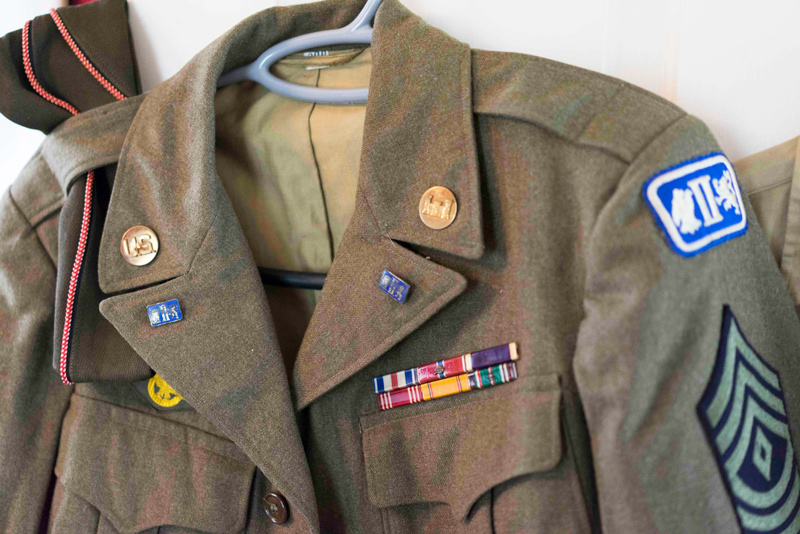
Well, yes, to a certain extent I did feel that way. But I tried to rationalize, and in my own way I was glad that I could go and do my duty for my country and get back safely. I’m proud of the fact that I went, and I would do it again.
Q: How were you treated when you got back? Treated well?
Everybody seemed to be happy. I will say maybe that after three years a person wondered if they ever was gonna get back without being back one time. But I took that in stride, too. I never had a furlough from the time I left till I got back. These five–day leaves which really is not a furlough, only you don’t get home. I guess getting home is the main thing once in a while.
Q: You mean, did you get home to visit at least for a short time or you didn’t get home at all?
On August the 12th up here at the Gibson House where the bus stopped, from August the 12th, 1941 to May the 17th, 1945 I was home one time.
Q: I’m getting the impression you thought there was no reason for that either. That you figured they ought to give a man a furlough every once in a while.
We had thirteen weeks’ basic training, and through basic they kept saying we’ll get eight to ten days’ furlough when our basic’s over and then we’ll ship to our next post. When that happened we just did odd jobs and picked up rocks off the drill fields and just washed windows and just spent a couple weeks doing that while they was waiting to see where they was gonna...but most of us was in Ohio, West Virginia, Kentucky area.
Out of Fort Woods, Missouri, why we could all come, and in ten days we could all have got home and had several days at home and got back. Well, then they said we’d get a furlough as soon as you get to your next post. Well, I ended up at Fort Ord, California into a regular outfit. “Well, you’ll have to go on a furlough list,” so that shot that down. Then the war come along and nobody got any. Unless they was stationed right here in the States. Once we went overseas we knew we weren’t gonna get a furlough.
Q: Anything else, Lyle, that you have on your mind?
Well, Bill, I guess that about covers it. I’ll say again that I’m proud and happy that I could answer my country’s call, and do my duty and get back home, have the service behind me. I do have a few souvenirs I’d like for you to look at.
Combat Engineers in World War II—a video
This is a documentary about World War II combat engineers. It shows the techniques for construction, bridging, and mine removal which Lyle Pittenger described. Click on the arrow. There is a box on the lower right to enlarge the picture to the full screen.
photo acknowledgments
Many of the photographs in this oral history are family photos graciously lent by Lyla Wagner, Lyle's daughter. Other photos are taken from the public domain. Google Maps images are gratefully acknowledged.
